
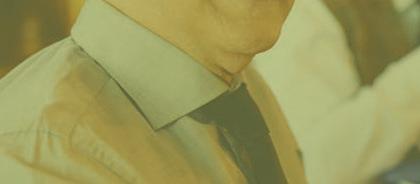

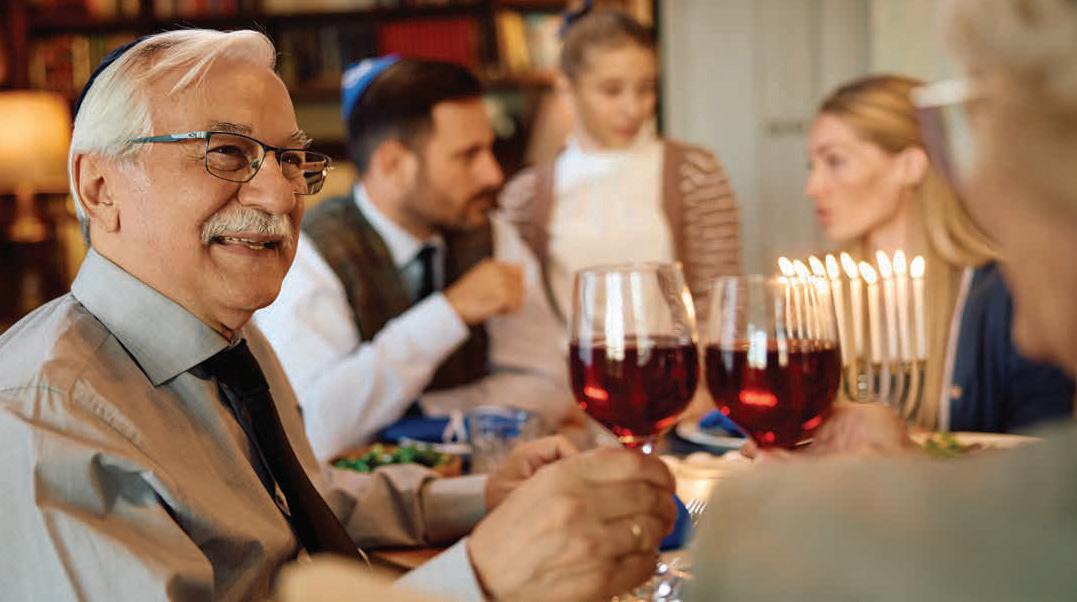
















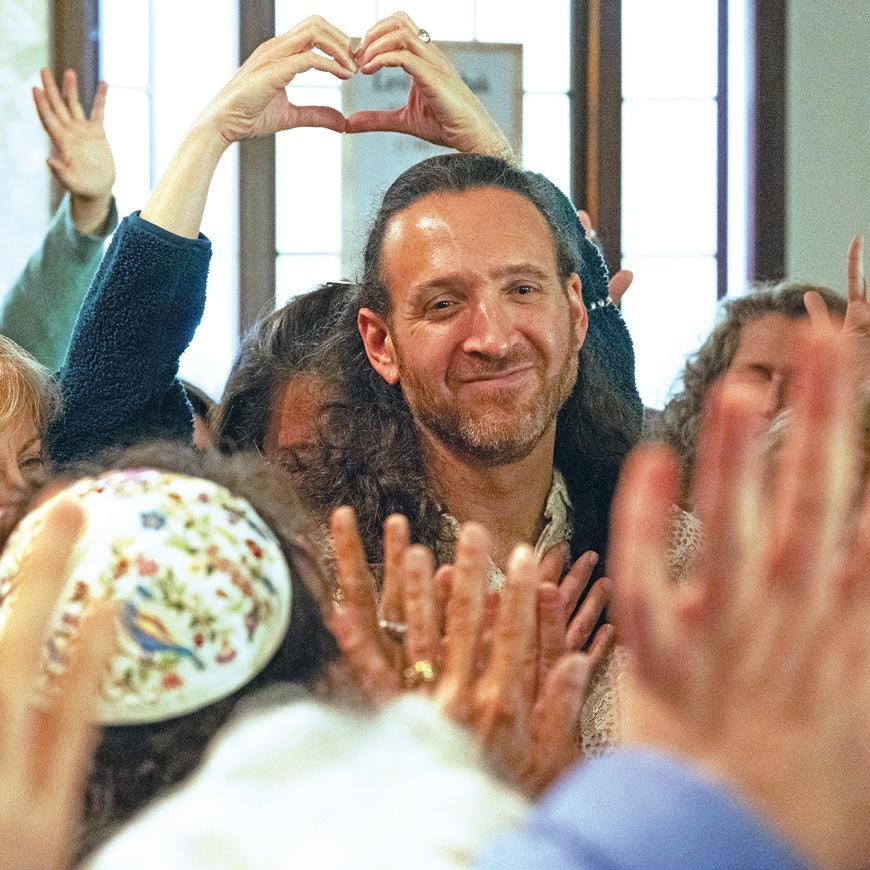


Registration Required: jleaders.org/forum
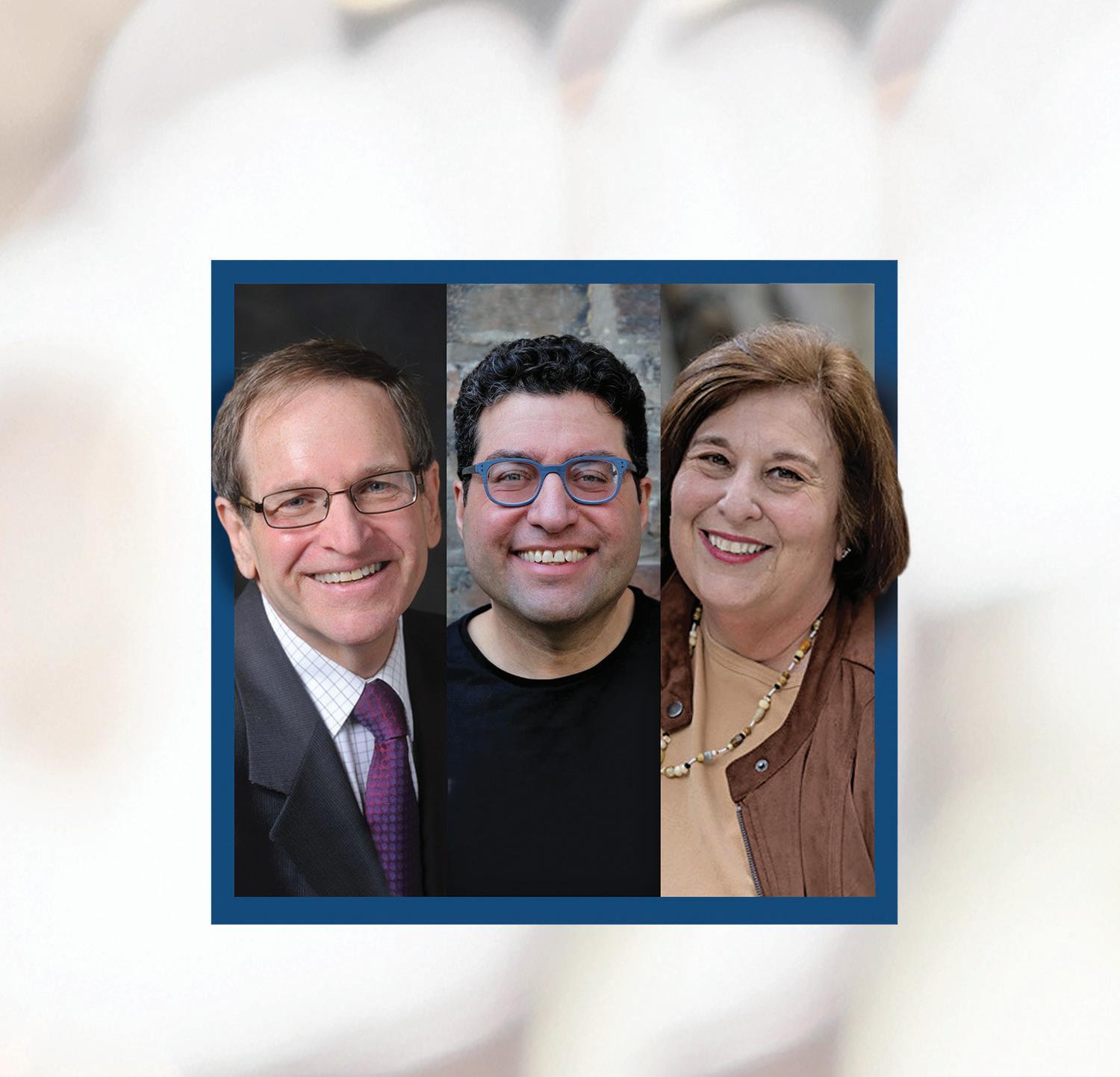
Wednesday, March 12th 5 to 6 pm PT/8 to 9 pm ET
























Registration Required: jleaders.org/forum

Wednesday, March 12th 5 to 6 pm PT/8 to 9 pm ET
Rabbi Ron Wolfson
F inger h u t Profe s sor o f Education , Ameri c an Je w is h University , & Autho r o f jewi s hl e aders h ipboo k. co m
Dan Libenson
P re s ident o f t h e L ipp m a n Kanfer Foundatio n f or L iving T ora h
Rabbi Denise Eger F o unding Spiritual Leader , Cong r ega t ion K ol A m i , W e s t Holly w ood , C A
MODERATOR Kyla Schneider V P Leader s hip Develop m ent and Ma s ter Exe c utive Coa c h, R a tlif f & T aylo r











CEO Jo Ellen Green Kaiser
PUBLISHER Steve Gellman
A.M. Wilensky
EDITOR Natalie Weinstein
NEWS EDITOR Gabe Stutman
CULTURE EDITOR Maya Mirsky
STAFF WRITERS Niva Ashkenazi, Emma Goss
ENGAGEMENT REPORTER Lea Loeb
PHOTOGRAPHER Aaron Levy-Wolins
CONTRIBUTING EDITORS Andy Altman-Ohr, Sue Fishko , Dan Pine, Alix Wall
COLUMNISTS Howard Freedman, Karen Galatz, Janet Silver Ghent, Faith Kramer, Dr. Jerry Saliman, Micah Siva
ADVERTISING & PROMOTION
ACCOUNT EXECS Nancy Beth Cohen, Meryl Sokoler
ART & PRODUCTION
DIGITAL TECHNOLOGY DIRECTOR Antonio R. Marquez
GRAPHIC DESIGNERS Michelle Palmer, Steve Romero
BUSINESS
DEVELOPMENT DIRECTOR Allison Green
DEVELOPMENT ASSOCIATE Carrie Rice
MARKETING ASSISTANT Holley Newmark
ACCOUNTING ASSISTANT Linda Uong
TECHNOLOGY
IT SUPPORT Felipe Barrueto
BOARD OF DIRECTORS
CO-PRESIDENTS Steven Dinkelspiel, Carol Weitz
VICE PRESIDENTS Andy Rittenberg, Jerry Yanowitz
SECRETARY Patricia Rosenberg
TREASURER Jane Springwater
MEMBERS Liz Berman, Alex Bernstein, Mark W. Bernstein (imm. past president), David Cornfield, Alexandra Corvin, Rabbi Joey Felsen, Howard Fine, Inna Gartsman, Alia Wechsler Gorkin, Samantha Grant, Steve Katz, Susan Libitzky, Rabbi Deborah Newbrun, Susan Sasson, Harmon Shragge, Peter Waldman
PAST PRESIDENTS Marc Berger, Lou Haas, Jon Kaufman, Dan Leemon, Adam Noily, Lory Pilchik, William I. Schwartz

SUE FISHKOFF | CORRESPONDENT
Elizheva Hurvich sat cross-legged inside a homemade chuppah in her Oakland backyard, surrounded by friends, as Amanda Bunde, a kohenet (Hebrew priestess), performed a ritual to welcome her as a newly ordained Renewal rabbi.
of Jewish Renewal, an approach to Judaism that combines old and new, and blends the Hasidic emphasis on direct connection to the Divine with New Age practices, from radical feminism and egalitarianism to meditation, dancing and drumming.
Although much smaller than the other major Jewish streams — in a 2020 Pew study of Jewish Americans, Renewal was counted in a group with “other” small branches, representing a combined 4% affiliation — Renewal

After readings from Sefer Yetzirah, a 2,000-year-old book of Jewish esotericism, the “three elements” mentioned in that book were invoked: Hurvich was showered with flowers (earth) and lightly brushed with feathers (air), before a bundle of sage was lit (fire) and passed around for folks to smell.
“It’s an ancient ritual that predates the Kabbalistic four elements,” Bunde said, referring to Jewish mysticism that emerged out of the 13th-century Zohar and is at the core of Hasidic Judaism. “I like it because it’s holy time, holy space and holy selves.”
The swirls of fragrance, myriad blessings and ancient symbolism in the ritual is typical
has influenced Jewish practice in certain circles, particularly in the Bay Area where the movement has a long, strong history.
That is especially true in the East Bay.
Aquarian Minyan, founded in Berkeley in 1974, is one of the oldest Renewal communities. It was joined in 1984 by Kehilla Community Synagogue in Piedmont, in 1994 by Chochmat HaLev and in 1996 by Beyt Tikkun, both in Berkeley.
Taking their cue from Renewal founder Rabbi Zalman Schachter-Shalomi, who fled Nazi-occupied Europe and helped create the first Renewal communities in the 1960s, leaders today refrain from calling it a “movement,” preferring to call it an “approach” to Judaism. But one could argue that it looks a whole lot like a movement, with Aleph: Alliance for Jewish Renewal, an umbrella organization that has an ordination program for rabbis, cantors and rabbinic chaplains; a professional organization called Ohalah that meets annually; and a directory of four dozen affiliated congregations, primarily in North America.
Like Hurvich, newly ordained Rabbi Zvika Krieger was celebrated by his commu-
A dozen Renewal rabbis lined up in the center aisle while Krieger walked between them, stopping for hugs along the way, as the congregation sang a niggun, or wordless melody.
way, as the congregation sang a niggun, or wordless melody. He made his way to the bimah, standing under a purple chuppah while Rabbi SaraLeya Schley, a former spiritual leader at Chochmat, told him, “Today you receive a second smicha [ordination], from your community, which will make a brit, a covenant with you.”
After Krieger shared a list of his commitments with the congregation, those attending shouted out their commitments to him: “I commit to holding you with love,” “I commit to emulating your ethical chutzpah,” “I commit to dancing ecstatically with you and loving God on the dance floor.”
Finally Krieger turned around, the
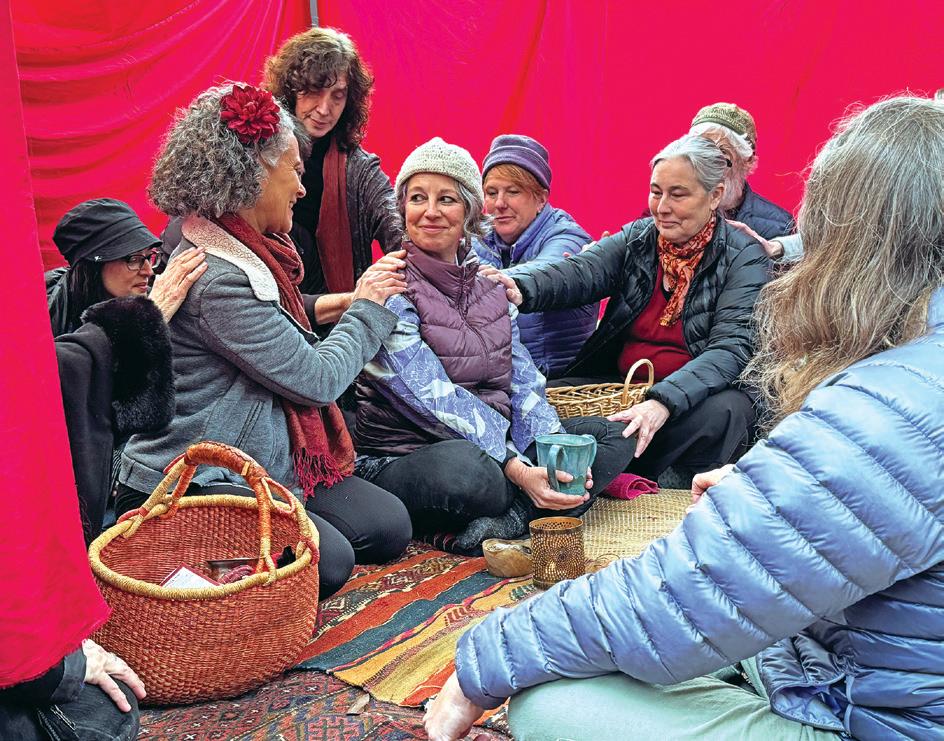
nity in a colorful ritual at Berkeley’s Chochmat HaLev, where he’s served as spiritual leader since 2022.
On Jan. 25 in the main sanctuary of the 30-year-old congregation, five local Renewal rabbis each spoke about one of Krieger’s spiritual heroes, including the Ba’al Shem Tov who founded Hasidism in the 18th century, the late Schachter-Shalomi — known as Reb Zalman — and the late Rabbi Burt Jacobson, founding rabbi of Kehilla.
Then a dozen Renewal rabbis lined up in the center aisle while Krieger walked between them, stopping for hugs along the
congregation pressed forward tightly, and he fell backward into their waiting arms as blessings for him were shouted out.
“Do we accept Zvika as our rabbi?” Schley asked, to which the congregation responded with a loud “Yes!”
Hurvich and Krieger are two of the eight rabbis ordained by Aleph last month, and both live in Oakland, illustrating yet again the East Bay’s preeminent position in the Renewal family.
Five of Aleph’s approximately 40 affiliated communities are in the Bay Area, including
continued on page 39
Before Rabbi Idit Solomon founded a fertility-focused nonprofit, she struggled for years to get pregnant. She had turned to in-vitro fertilization, which led to anguish and financial strain after multiple cycles. She also felt isolated from the Jewish community in her grief, she told J.
Solomon decided that if she ever became pregnant, she would pay it forward to other Jews facing similar hardships. After additional IVF attempts, Solomon received the news she’d longed for, and in 2012 she gave birth to twin girls. By that time, she was already working to create Hasidah, focused on helping hopeful parents-to-be dealing with fertility challenges.
For over a decade, the Berkeley-based nonprofit with the motto “build Jewish families” has distributed grants averaging $5,000 to $10,000 to individuals and couples to pay for IVF procedures. Solomon has also offered spiritual care and resources to destigmatize the topic of infertility, which can be hard for some people to discuss.
In September, though, Hasidah transi-
“Our No. 1 donor type was a grateful patient.”
Rabbi
tioned to a spend-down model, prioritizing IVF grants. Once the remaining $40,000 runs out, Solomon said in early February, the nonprofit will shut down.
Solomon, who serves as Hasidah’s CEO, said the decision to close the nonprofit was tied to difficulties in fundraising. She also noted that the fertility-support landscape has expanded since Hasidah’s early days, with more organizations providing financial and other resources for fertility issues and with abundant information available online.
“A lot of pressure that we got was constantly about ‘expand, expand, expand,’” Solomon said. “But I think we’re just going to celebrate what we did, which was extraordinary.”
Solomon said Hasidah’s IVF grants resulted in the birth of almost 60 babies, served more than 1,000 clients and provided free information online, much of it Jewish-oriented, to countless others aspiring to become parents.
“Be fruitful and multiply” (Genesis 9:7) is considered the first commandment given by God and one of the most important. In Israel, the state fully funds fertility treatments for Israeli citizens up to age 45 with a

Rabbi Gershon Albert, Rebbetzin Meira Albert and their children. (COURTESY)
limit of two children. Israel also has become a medical destination for treatments whose cost is prohibitive elsewhere.
IVF treatment is notoriously expensive.
According to a 2024 report from the U.S. Department of Health and Human Services, the average cost for a single IVF cycle can range from $15,000 to $20,000 and sometimes exceed $30,000. Because many people must undergo multiple cycles, the financial strain accumulates rapidly. IVF treatment is often not covered by insurance. California
is one of nearly two dozen states with laws for covering infertility treatments, but the terms vary widely.
Hasidah, which is Hebrew for “stork,” previously received funding from the Jewish Federation of the East Bay, which in 2019 became part of the S.F.-based Jewish Community Federation and Endowment Fund, and from San Francisco’s Mount Zion Health Fund, among others. However, most of its budget, including the entirety of the IVF grant pool, came from individual donors,
some of whom, like Solomon, had their own experiences with infertility.
“Our No. 1 donor type was a grateful patient … who’s been through it and then gives back,” she said. “We even had past recipients of our grants who would give back.”
Rebbetzin Meira Albert was one such recipient.
Although she and her husband, Rabbi Gershon Albert of Beth Jacob Congregation in Oakland, were able to conceive their first child naturally, routine genetic testing during pregnancy revealed that she has a genetic mutation called Fragile X syndrome. This disorder causes a range of delays, including intellectual, behavioral and developmental issues. For Albert, it affects fertility.
“We were told that having my first child was lucky, or God,” she said.
The couple knew they wanted more children and would need help to conceive. They met with specialists, and she went through fertility treatments, hoping that a combination of science and faith would bring good news.
“Even though the doctor said it would take a miracle, we tried to retrieve my own eggs,” Albert said. “But it didn’t work. I didn’t get any eggs.”
By that point, the Alberts had exhausted their funds. Their family had already pitched in to cover some of the medical costs, and living on Meira’s social worker salary and Gershon’s rabbi salary left little disposable income for them to keep trying.
Fortunately, congregants at their Modern Orthodox synagogue connected them with Hasidah, and they were quickly approved for a grant. Because she had already successfully carried one child and undergone fertility treatments, Albert was a good candidate for IVF using an egg donor and her husband’s sperm.
For some reason, though, the transfer failed.
“That was quite devastating for me, because it was a lot to get to that point,” Albert recalled. She was ready to give up. “I wasn’t going to put my body through it anymore.”
She decided to try one final transfer, this time using two of the four remaining embryos to improve the odds of one sticking. Those two embryos developed into a healthy set of twins, a boy and a girl, who are now 6 years old. A few months after the twins were born, Albert discovered she was pregnant again with their “‘miracle’ baby against all odds.”
Albert was so grateful to Hasidah that
she began working for the organization, leveraging her background in social work.
“It’s a testament of how much I was indebted to them and how much they helped me,” she said. “I wanted to work for them and help other people through their struggles.”
As other fertility-related nonprofits and financial aid programs sprang up over the years, Hasidah cited these new resources as alternatives or even additional sources of funding for IVF.
When Hebrew Free Loan in San Francisco started a fertility loan program around 2019, for example, HFL executive director Cindy Rogoway could tell early on that collaborating with Hasidah had potential.
“She has referred a lot of people to us over the years who took out loans,” Rogoway told J. “I’m a big believer in collaboration.… I think it’s all for the better good of the community, and this was a prime example of one that really worked beautifully. I was very sad to hear when Idit told me that it
was time to close [Hasidah] down.”
Hebrew Free Loan makes 15 to 20 fertility-related loans per year, with around 40 loans currently outstanding, totaling over $500,000.
Even when Solomon could not offer financial support, she sought to help clients by combining her experience in pastoral care as a Reform rabbi with what she had learned during years of personal struggle.
“I was getting calls all the time for grants, and I would hear people asking very deep spiritual questions,” Solomon said. “I started offering that care and developed a framework over the years,” which she then shared with other rabbis to use.
Hasidah’s website houses Jewish approaches to infertility, such as a tashlich ritual for fertility around the High Holidays, a blessing for a newborn after infertility or a previous pregnancy loss, and a prayer before starting IVF. For clergy, Solomon has developed written materials for guiding congregants dealing with infertility. She has
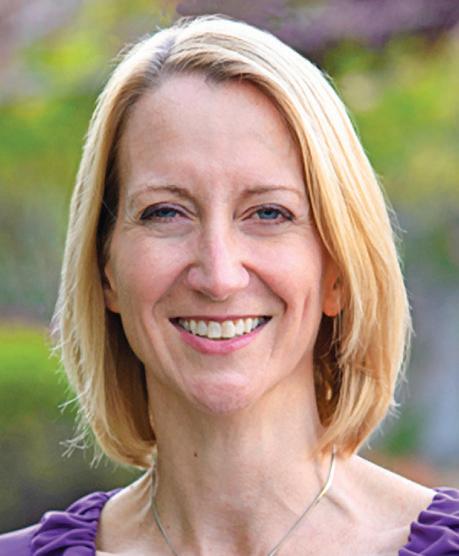
also led training seminars on the emotional and spiritual elements tied to the issue. Once Hasidah closes, the resources that Solomon has accumulated will need to find a new home. Solomon told J. she has so far
considered options such as transferring the information to a national group like the Jewish Fertility Organization or I Was Supposed to Have a Baby.
Dr. Aimee Baron, a former pediatrician who herself had twins as a result of IVF, founded I Was Supposed to Have a Baby in 2019. She has collaborated with Solomon on summits on Jewish fertility.
“We would be thrilled to have her resources,” Baron said, “and with very clear credit saying that these resources came from Hasidah.”
Despite her years of work to shine a light on infertility in the Jewish world, Solomon credits the clients for their inspiration and insights. “By far one of the most meaningful experiences of Hasidah was when I could just work with people going through this,” she said. She compiled her resource library by “listening to the questions that people ask me and realizing these are the issues that people really have. Because that’s what I heard, that’s what I addressed.” n
By Elise Jordan
Artwork by the Residents of

Elyse Kaye has been appointed executive director of Mt. Zion Health Fund, a supporting foundation of the Jewish Community Federation and Endowment Fund. Mt. Zion Health Fund is a philanthropic organization dedicated to advancing health equity and improving access to care in San Francisco. Kaye brings more than 25 years of leadership experience to the role.
A.J. Sass of Oakland was awarded the Sydney Taylor Book Award silver medal in the middle grade category for “Just Shy of Ordinary.” The award is named for the author of “All-of-a-Kind Family,” the first in a series about a Jewish family living in New York’s Lower East Side near the turn of the 20th century. The award is administered by the Association of Jewish Libraries and recognizes titles for children and teens that exemplify high literary standards while authentically portraying the Jewish experience.
Anita Friedman, longtime executive director of S.F.-based Jewish
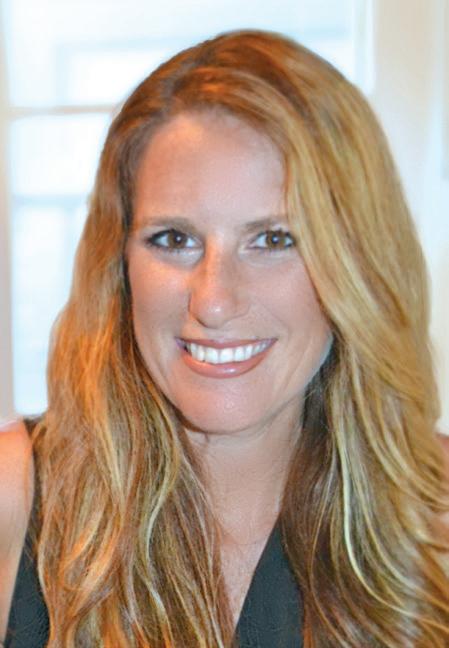
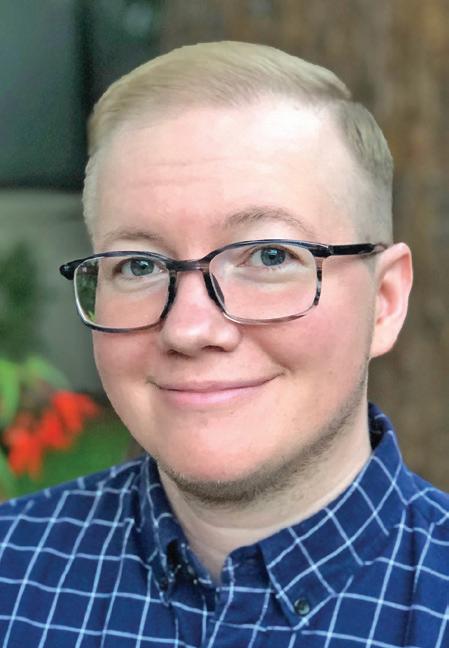
Family and Children’s Services and its Holocaust Center and board president of the Koret Foundation, will be honored for her leadership and dedication to combating hate, advancing education and preserving Holocaust memory by the U.S. Holocaust Memorial Museum at its Western Region Tribute Dinner on March 19 in Beverly Hills. Friedman is the child of Holocaust survivors and is co-chair of the Governor’s Council on Holocaust and Genocide Education. The tribute dinner is co-chaired by Sam Lauter and Susan Lowenberg
Alon Liubovitch a student at Wilcox High School in Santa Clara, was awarded the Shine A Light on Antisemitism Civic Courage Award, presented by the Jewish Education Project. Liubovitch founded his school’s Jewish Student Union and also serves as president and helps organize events to promote Jewish culture. When faced with antisemitic comments and threats, Liubovitch advocated for himself and

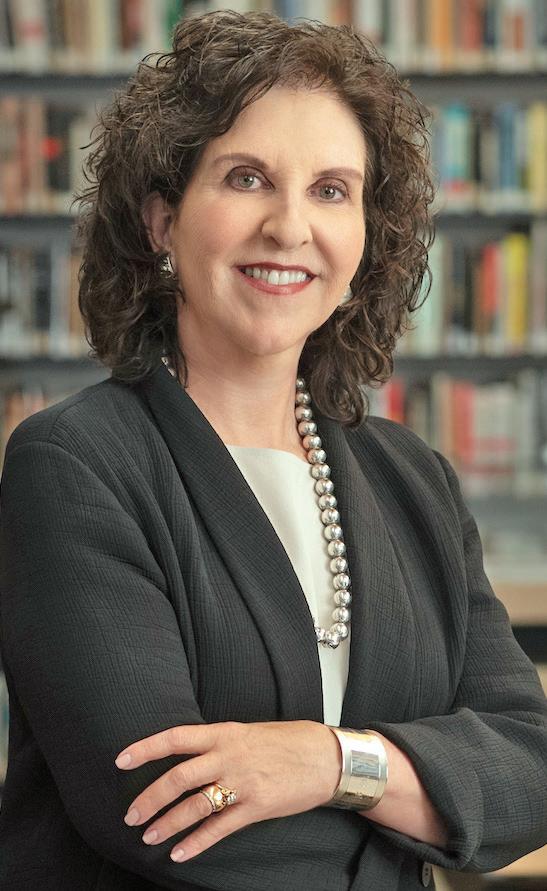
Anita Friedman (JAMEY STILLINGS/COURTESY FIRST REPUBLIC BANK)
his peers by collaborating with school administrators. The award recognizes students, educators, gamers and influencers who take meaningful action against antisemitism. He was one of two students nationwide to win the award.
Contra Costa Midrasha will honor Devra Aarons for her 18 years of leadership at its annual gala on Feb. 22. Aarons serves as executive director of the midrasha, which provides an educational and social community for Jewish teens in grades 8-12. Aarons was the recipient of the 2020 Ruby Award from Jewish LearningWorks and earned an executive master’s in Jewish education from the Hebrew Union College-Jewish Institute of Religion in 2023.
Eitan Manhoff has been selected as one of five judges for the 2025 Will Eisner Comic Industry Awards at San Diego Comic Con. Manhoff, who was featured in J. a decade ago, is the son of a rabbi and the owner of Cape and Cowl Comics in Oakland, which won the Will Eisner Spirit of Comics Retail award in 2023. Eisner was honored by the Jewish Museum in New York City in 2006 as one of the “Masters of American Comics.”
Jill Suzanne Jacobs, director of community relations at Claremont Hillel, and Hadar Aviram, a professor at UC Law San Francisco, were
Join us Tuesday, March 4 at 7 PM at the JCC East Bay for an evening of celebration and connection. Meet Dr. Joshua A. Miele and hear insights and stories from his latest book in conversation with journalist Alix Wall.
Josh is a MacArthur Fellow, scientist, and disability rights activist. He is known for inventing inclusive technologies that help people with disabilities navigate the world. He works with companies and organizations, including Amazon, on non-visual customer experiences, accessible designs, and disability inclusion.
Alix Wall is a contributing editor of J. The Jewish News of Northern California. She is also a contributor to the Vows section of the New York Times and writer/producer of the forthcoming documentary film “The Lonely Child.” As a contributor to local news site Berkeleyside, she wrote the first profile about Josh after his MacArthur Fellowship and “genius grant” was announced in 2021.
“Connecting Dots” chronicles Josh’s experience learning how to navigate the world as a blind person and using his intellect and creativity to help make the world a better place for others like him. This captivating memoir offers a powerful, humorous, and triumphant perspective on life.
JCC East Bay: 1414 Walnut St., Berkeley | Tickets $5 jcceastbay.org/events/book-launch-connecting-dots


selected to participate in the Hebrew Union College-Jewish Institute of Religion’s inaugural class of students entering the rabbinical school through its new virtual pathway. Jacobs grew up in the Bay Area, attending Temple Isaiah of Lafayette. Aviram was born in Jerusalem and writes about the intersection of law, criminology and sociology. Minna Stess of Petaluma was honored on the California Assembly floor by Assemblymember Damon Connolly of San Rafael. Stess, an 18-year-old skateboarder, represented the U.S. in the 2024 Paris Summer Olympics in the women’s park event. Connolly presented the first-time Olympic competitor with a resolution to commend her achievements.

In observance of International Holocaust Remembrance Day on Jan. 27, the California Legislative Jewish Caucus hosted the California Mobile Museum of Tolerance at the state Capitol for the first time. The mobile exhibit was created in partnership with the Museum of Tolerance in Los Angeles and featured interactive exhibits and educational modules to foster respect, tolerance and human dignity. Mobile Museums of Tolerance also operate in Illinois, Florida, New York and Canada. Santa Clara University, in partnership with Hillel of Silicon Valley and Hillel International’s Campus Climate Initiative team, hosted a regional one-day summit on Jan. 24 for administrators titled “Jewish Identity, Antisemitism, and Inclusion on Campus and Beyond.”



Thirty-eight administrators attended from five college campuses, including De Anza College and San Jose State University. A key goal of the summit was to help administrators and sta better understand the needs of Jewish students, recognize the diversity of the Jewish community and address antisemitism.
The HaZamir Silicon Valley Chapter will perform with 35 other chapters from across the U.S. and Israel at Carnegie Hall on March 23 as part of the annual HaZamir International Festival. HaZamir is an international Jewish teen choir for high school students to sing classical, contemporary and popular Jewish music.
Nominations are open for the Jewish Community Federation and Endowment Fund’s Judith Chapman Memorial Women’s Leadership Award, honoring women who are role models in the Jewish community. Nominees should demonstrate significant and sustained volunteer leadership, model the importance of tzedakah, have a significant connection with the Federation, demonstrate volunteer leadership in the secular community and mentor, motivate and encourage others to follow in their footsteps. A $2,500 grant will be awarded and designated to a nonprofit of the recipient’s choice. Nominations close March 3. tinyurl.com/judith-chapman-25
Nominations and applications for the EarlyJ Impact Award are open. The award consists of a $10,000 personal prize and a $5,000 prize allocated to the recipient’s preschool to support an initiative led by the recipient and designed to expand programming and enrollment. The award is open to early childhood educators currently teaching in a Jewish preschool in the Bay Area with at least three years of experience in Jewish early childhood education. Nominate or apply by March 10. earlyj.org/impact-award ■



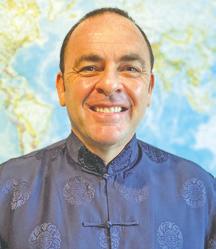
EMMA GOSS | J. STAFF
Zellerbach Playhouse shows no trace today of the battering it took a year ago when a violent mob attacked the UC Berkeley performing arts venue.
A glass door and large window were broken the night of Feb. 26, 2024, when many of the 200 protesters forcefully banged against Zellerbach’s entrance and eventually stormed the theater. The protest shut down a planned speech by Ran Bar-Yoshafat, an Israeli attorney and combat reservist who had recently served in Gaza, and then forced him and attendees to flee through an underground tunnel. Several Jewish
But it may not be enough. A new federal investigation, announced Feb. 3, alleges that Cal’s progress in addressing the climate for Jewish students has fallen short. The prestigious university also faces a federal lawsuit over its handling of anti-Jewish discrimination and harassment. And last month, an Israeli postdoc at Cal filed a separate lawsuit alleging discrimination by her union.
The campus has been under intense public scrutiny since the Oct. 7, 2023, Hamas massacre. Anti-Israel protests repeatedly erupted on campus during that academic year, along
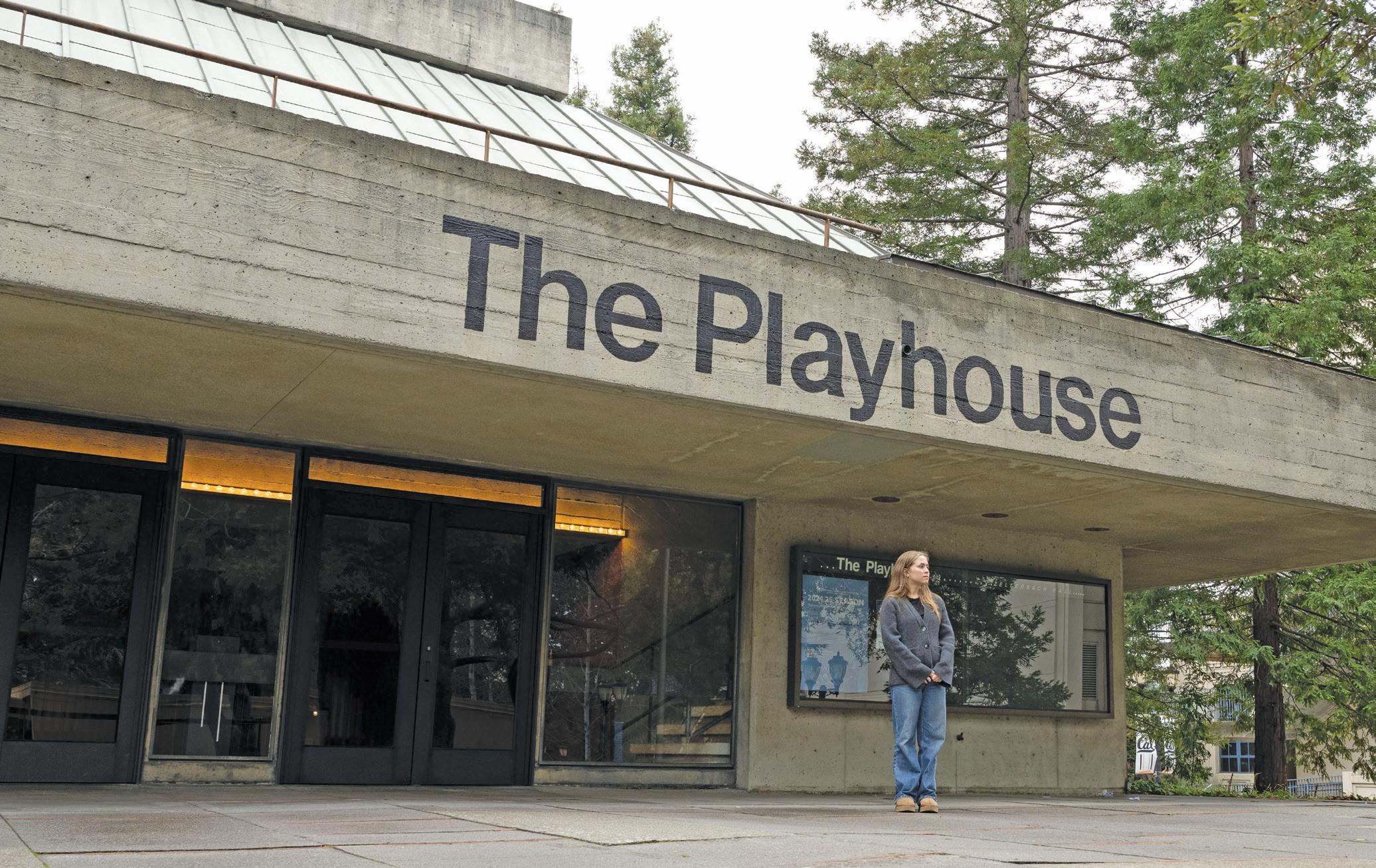
students who were at the event were injured in the chaos. One left with bruises around her neck.
“It was just hands being thrown, spit flying out of the corners of masks. It was slurs being thrown all over the place. It was really, really mortifying and terrifying,” recalled Vida Keyvanfar, a student leader who helped organize the event.
Keyvanfar was stationed by the front doors of the venue. She wrestled to keep the doors shut as protesters tried to enter by force. They eventually swung the doors open, spraining her thumb and wrist in the process. She couldn’t see protesters’ faces because they wore masks and kaffiyehs.
“If you were standing in that mob … you could barely see eyes,” she told J.
Since that night one year ago, the campus has invested millions of dollars to address Jewish student safety and has mandated antisemitism training for all incoming students. Ron Hassner, the UC Berkeley professor who famously slept in his office for two weeks to protest administrative inaction after the Zellerbach disturbance, now applauds campus leadership for “setting things right.”
with violent language calling for “intifada” and supporting Palestinian “resistance.” In the spring, two pro-Israel demonstrators were attacked in two separate incidents at a pro-Palestinian tent encampment on campus.
Regarding the Zellerbach incident itself, no one was ever arrested.
UC police opened a criminal investigation, interviewing people who had witnessed the violence and vandalism outside and inside Zellerbach, Dan Mogulof, assistant vice chancellor of communications, wrote last month in an email to J.
Cal police also publicly posted and distributed photos of five suspects, “most of whom were masked to one extent or another,” Mogulof wrote. The photos were circulated widely across local news outlets in late March 2024 and were emailed to all students, staff and faculty, according to Mogulof.
“They almost never do that,” Ethan Katz, a professor and the faculty director for the university’s Center of Jewish Studies, said about the release of such photos. “It reflects a serious level of commitment.”
None of those suspects was ever identified, and the case is
cold. However, the investigation remains open, Mogulof said.
“It’s unfortunate, it’s frustrating, but I also understand,” Keyvanfar said of the inability to identify the suspects given that most protesters covered their faces. “I really think that even the police officers themselves were really afraid and didn’t expect that [level of violence]. It makes sense to me that they would never be able to track down those people.”
The memories of what happened at Zellerbach Playhouse still haunt Keyvanfar, who graduated last spring and moved home to Southern California.
“I didn't realize that would follow me, even to another city where I'm used to feeling safe,” said Keyvanfar, 22. “But it did, and my parents made me do trauma therapy and things like that.”
Keyvanfar said she doesn’t identify as a victim. She credits the events of that night, as well as subsequent conversations with attorneys from the Anti-Defamation League and the Jewish advocacy group StandWithUs, for inspiring her to apply to law school.
“[Enforcing the rules] sends a message to those people that your behavior isn’t welcome here, and you can’t treat Jews like they’re a chew toy.”
Shaya Keyvanfar, Cal student
“The environment at Berkeley made me really strong and made me prepared for the worst situations, and also made me understand how hate forms,” she said.
Current students and faculty said that what occurred at Zellerbach showed UC Berkeley at its worst and that administrators have taken noticeable steps over the past year to support Jewish student safety.
In the wake of the Zellerbach incident, the university invested $8 million in more robust campus security measures, mostly toward staffing, Mogulof said. The reservation process for booking student-sponsored events on campus has also changed, giving administrators a heads-up on all scheduled events.
In March 2024, three weeks after the Zellerbach protest, Bar-Yoshafat was welcomed back to campus and spoke to a room of 150 people with no interference. Campus police and private security helped to ensure that the event went smoothly.
Anti-Zionist campus rage is no longer a staple of daily life, but rather “comes in waves,” said Keyvanfar’s sister Shaya, who is a sophomore and a campus senator representing Jewish students. She, too, was inside Zellerbach the night of Bar-Yoshafat’s canceled speech and witnessed a friend get “strangled” as she tried to stop the protesters from entering. Shortly after, she saw her sister Vida crying in pain.
“When I saw what happened to my sister, I was trying to hold in my cries because I didn’t want to scare the other Jewish participants in there, my friends, who I’d asked to come to the event,” she said.
Now, as a campus senator, Shaya Keyvanfar leads a team of some 20 students who help keep a record of antisemitic incidents on campus.
For instance, she noted that a group of students from Berkeley Law invited Simcha Rothman, a right-wing member of Israel’s Knesset, to speak last fall. He was driven off the stage within minutes by a mix of pro-Palestinian protesters and anti-Netanyahu Israeli demonstrators.
“There was a protest happening inside of the event, and people were being verbally harassed,” Keyvanfar told J. Rothman delivered the rest of his remarks over Zoom.
Two weeks later, on the one-year anniversary of the Oct. 7 Hamas massacre in Israel, pro-Palestinian students and faculty participated in a “week of rage,” which included a walkout that triggered a standoff with pro-Israel counterprotesters.
“There was lots of graffiti around campus, and people were saying mean things and antisemitic things to students,” Keyvanfar said. In violation of campus rules, protesters hung a banner from the Campanile, the campus’ iconic clock tower, with the words “glory to the resistance,” she said.
Cal’s new chancellor, Richard Lyons, who stepped into the role in July, “was tested early,” said Katz.
Sather Gate, the main entrance to campus, was blocked twice in October by pro-Palestinian protesters. In both cases, the university intervened. The first time, staff got protesters to disperse after an hour. The second time, university staff took down an unauthorized structure overnight.
Last month, administrators removed an online description for a Feb. 11 anti-Zionist event that explicitly denied the rapes and sexual violence committed by Hamas on Oct. 7, 2023.
Lyons emailed a statement to J. in late January that described Cal’s efforts to turn the page from last year’s violence.
“I believe the university’s review of security procedures
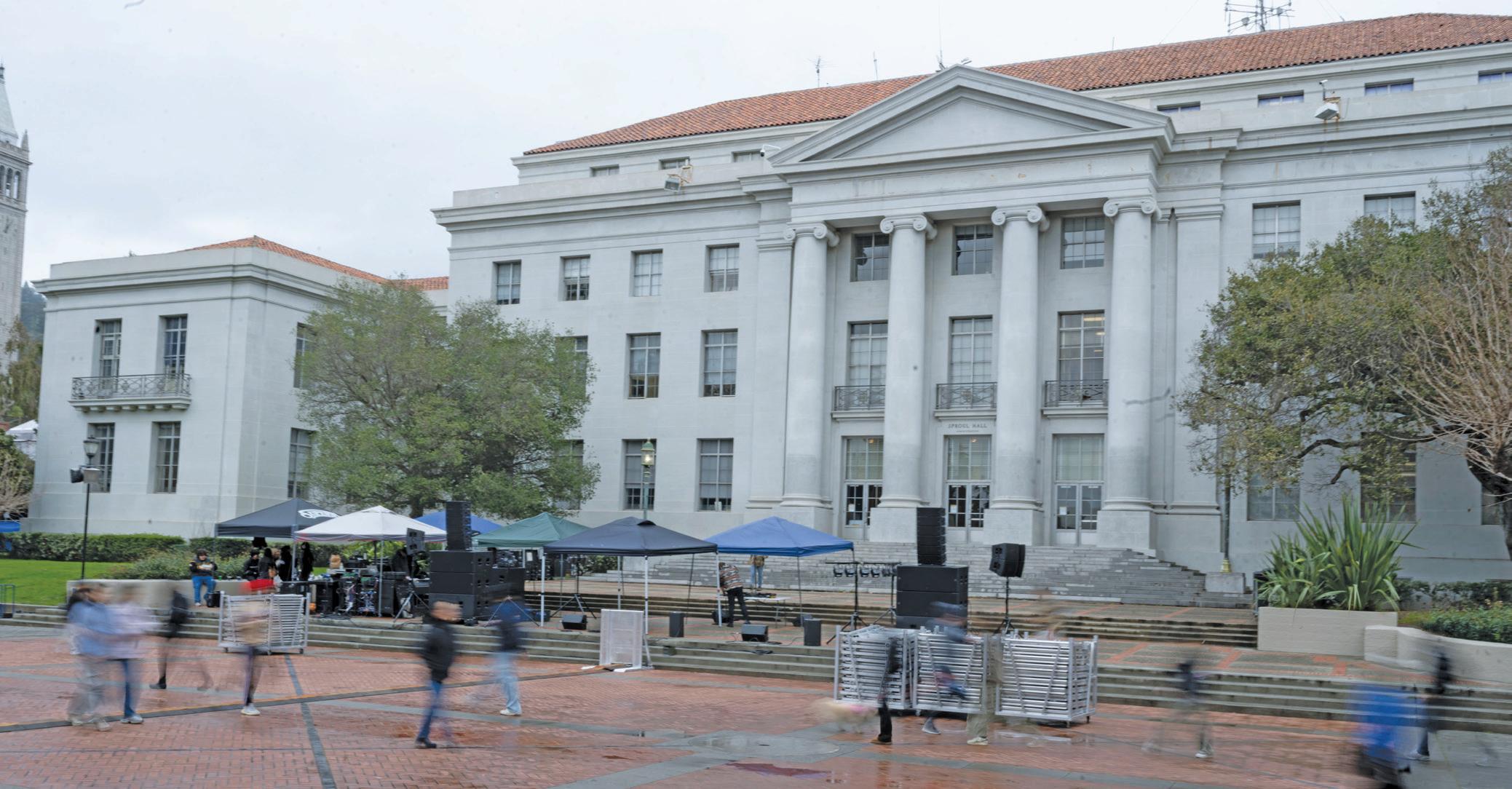
and the reservation process for student events, conducted after the terrible incident at Zellerbach Playhouse, was a needed and essential step,” Lyons said in the statement.
“Subsequent to that review we have seen nothing similar occur on campus, and it is my intention to maintain our commitment to enforce campus rules and policies, and ensure appropriate consequences are imposed when rules and
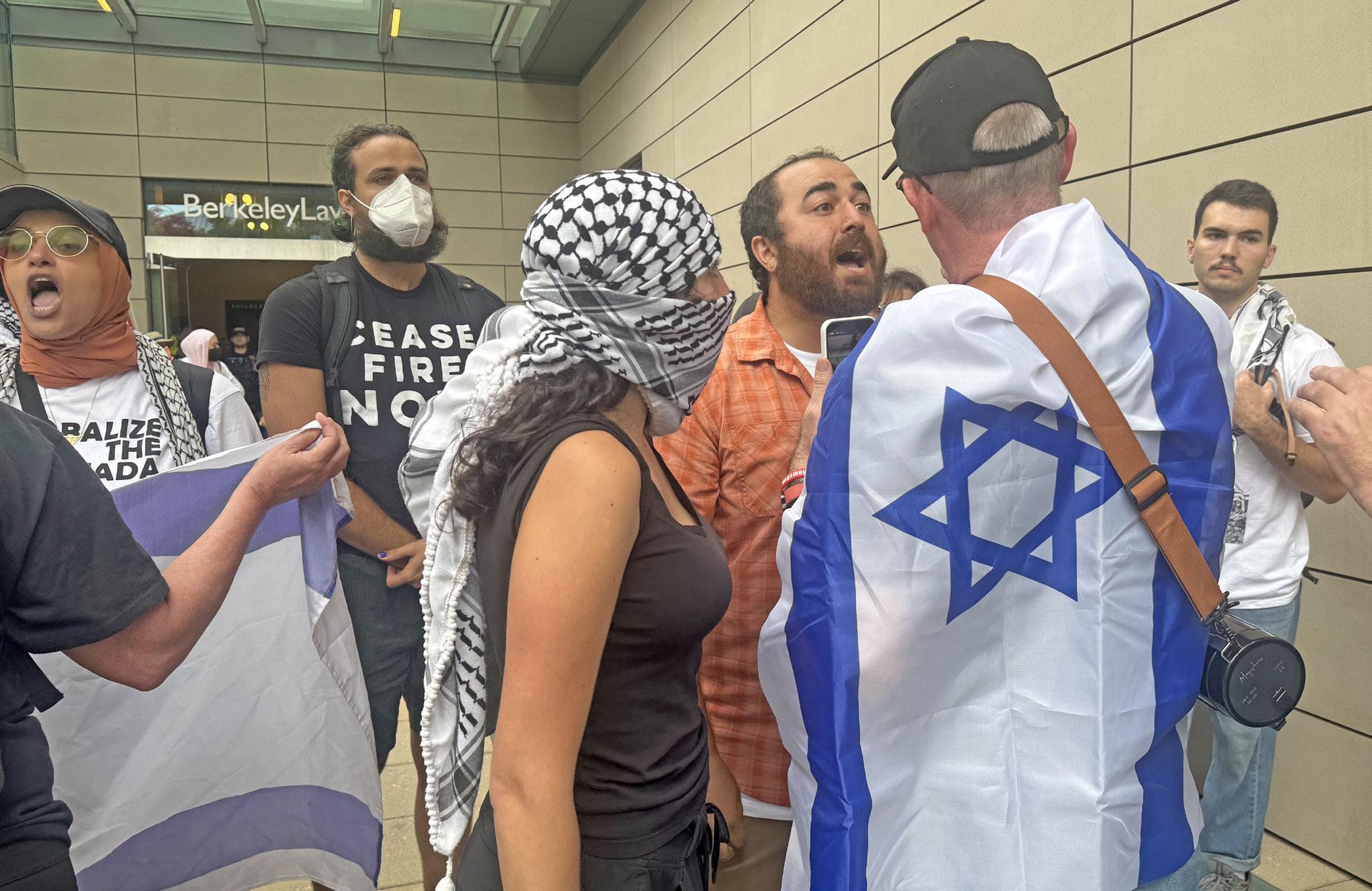
policies are violated.”
Lyons also made a point to engage directly with Jewish students by attending Shabbat dinners last semester, one hosted at Berkeley’s Hillel and the other at Chabad.
“On those Friday nights I was deeply moved by the warm welcome I received, and by the powerful sense of community, connection, and commitment that was evident at both of the gatherings,” Lyons wrote to J.
“He’s made a really demonstrable effort,” Katz said.
Shaya Keyvanfar concurred.
“So far, I only have really good things to say about him,” she said. “I feel really hopeful about the rest of the year too. He has not hesitated, and it’s not about taking the side of Jews over the side of anti-Israel people. It’s about the fact that he’s there to enforce the rules, and he’s been doing that to a much
“It was just hands being thrown, spit flying out of the corners of masks. It was slurs being thrown all over the place. It was really, really mortifying and terrifying.”
greater extent than our last chancellor was. As a result, it’s led to much more order on campus, and it sends a message to those people that your behavior isn’t welcome here, and you can’t treat Jews like they’re a chew toy.”
To mark the anniversary of the Zellerbach incident, Keyvanfar plans to introduce a bill this month to the Associated UC Student Senate condemning the violence of that night. Coincidentally, days ahead of the Feb. 26 anniversary, the Batsheva Dance Company from Israel is scheduled to perform at the adjacent auditorium inside Zellerbach Hall. n
On the 1st of April 1925, in a ceremony attended by dignitaries from across the region and the world, the Hebrew University of Jerusalem officially opened its academic doors.
After decades of thought and over seven years of construction — from the setting of the cornerstones in 1918 to the start of classes in 1925 — the University’s official opening marked the start of a new era, setting the stage for the institution to become a beacon of academic excellence and an internationally-renowned incubator of discovery and innovation.
100 years on, the Hebrew University is linked to new inventions and schools of thought that impact on nearly every walk of life; from the foods we plant and eat, the medicines and machines we use to treat disease, the air we breathe, the nature of political and social discourse — among countless other areas where the University has left its mark.
In looking back on the University’s achievements over the past century, we know that for the people of Israel and her friends and supporters around the world, the Hebrew University has become far more than just a center of learning and productivity.
Indeed, the accomplishments reached within its many halls and campuses have been instrumental in charting the forward progress of the State of Israel, a nation blessed with tremendous success even in the face of ongoing challenges and threats to its very existence.
Alongside the founding of the University itself, committees around the world were created to support its development. As such, American Friends of the Hebrew University will also cele-
brate its 100th anniversary in 2025, marking one hundred years of partnering in growth.
To mark the onset of this historic year, we took the opportunity to speak to top executives at the Hebrew University and its American Friends to hear first-hand why this anniversary is so important for Israel, for the Jewish people, and for the world at large.
Yishai Fraenkel is the Vice President and Director General of Hebrew University, responsible for advancing a vision that he anticipates will firmly establish the University as one of the top centers of higher learning in the world.
As CEO of American Friends of the Hebrew University, Joshua Rednik oversees an ambitious and continuously expanding development effort manifested by what he describes as the “inextricable bond” between the American community and the University.
Both say that what sets the Hebrew University apart is how it is far more than just an academic institution. It has become a pillar of Israeli society, with its success being instrumental in both the founding and remarkable growth of the State of Israel and the modern Zionist movement.
Yishai points out that the initial concept for the Hebrew University can be dated back to the First Zionist Congress in 1897 and that its founding, more than two decades before Israel declared its independence, “can be seen as the first major project of modern Zionism.”
Joshua adds that it would be shortsighted to view the success of the University as solely an Israeli, or even Jewish, enterprise. “The vision of the Hebrew University really is about creating a better world for all people. Whether it’s through developing better medicines, a healthier and more sustainable environment or any of the countless areas with which the University is involved, it is no exaggeration to say that the daily pursuit is about creating a better future for all people to be able to live and thrive together.”
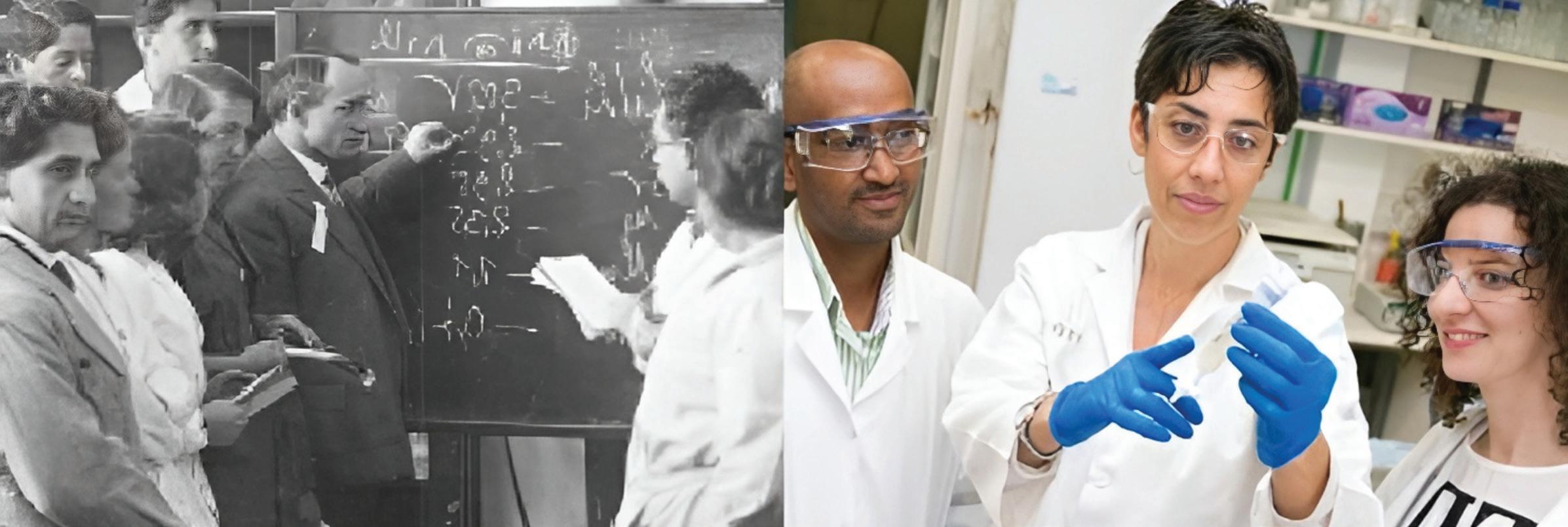
That pursuit to better society is what has helped forge
relationships between the University and the international community, driving philanthropic investment in its forward development. “My experience has been that people view support of the Hebrew University as a fundamental way to achieve two meaningful ends: fulfill their commitments to Zionist ideals and improve the world around us,” Joshua says.
Yishai points to specific examples of how the University is charting an academic course that will benefit people far beyond Israel’s borders. “Our motivating vision is to see Israel as a light unto the nations in areas of science and forward-thinking. This manifests itself in essential research in areas including climate science and sustainability but no less so in educating the community on how minority populations can live together or how to advance social justice and greater inclusion.”
Like the early Zionist movement itself, the Hebrew University faced many challenges in its early years, and sadly those challenges have remained an ever-present reality even all these decades later.
“The vision of the Hebrew University really is about creating a better world for all people.”
Joshua Rednik, CEO of AFHU
As the University prepares to mark this 100th anniversary, Israel finds itself amidst another deeply tragic and increasingly costly war. “Sadly, this is far from the first time where we as a university community have been forced to respond to the pressures of war. The cornerstone of Hebrew University was laid while World War I was still raging and we have been here for every moment of tension,” Yishai says. “But our mission then and today has been to remain resilient and utilize all the means at our disposal to grow and support a diverse and inclusive Hebrew University community, one that reflects the democratic and multi-cultural values of Israeli society.”
Since the beginning of the war over 7,500 Hebrew University students have been called to military-reserve duty and all-too-many people from within the HU community have fallen or were injured in battle.
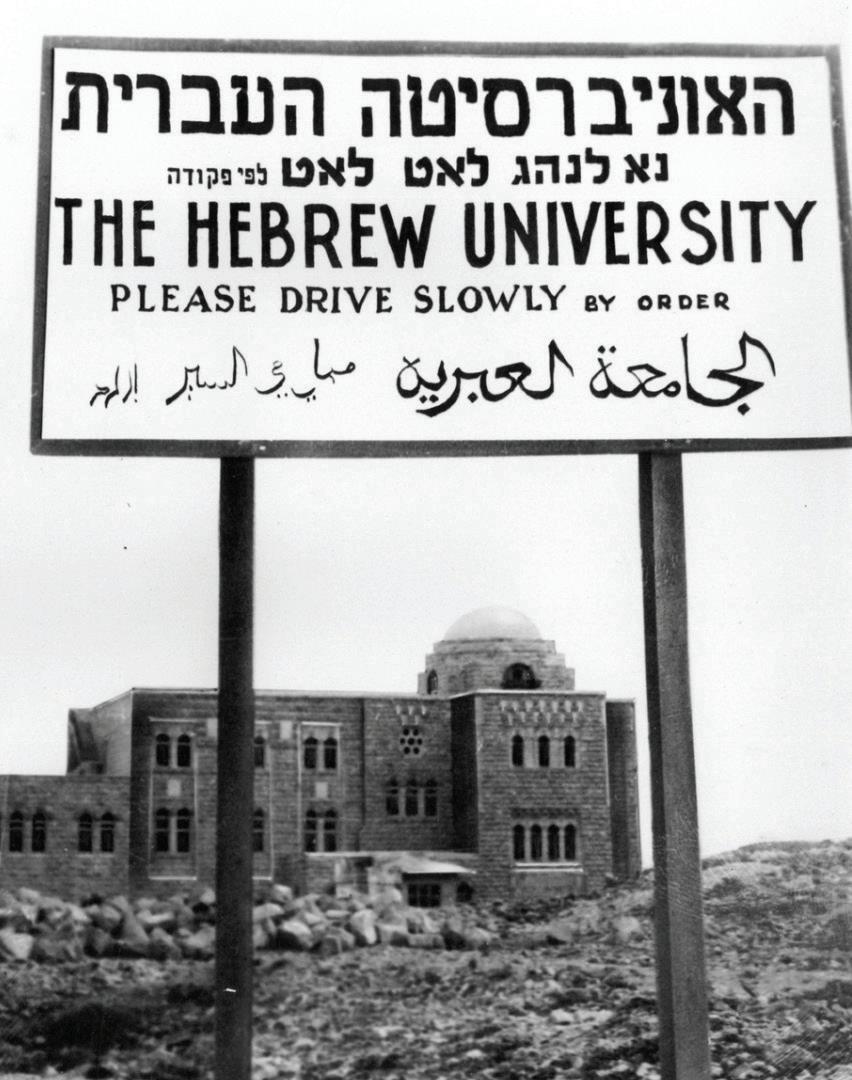

That sense of dedication is something which both Yishai and Joshua say is the ultimate mark of achievement, and what they believe will carry the University forward over the next century.
“While the miracle of the modern State of Israel might have happened even without Hebrew University, we take incredible pride in the fact that we supported it and were at the heart of making Israel the economic powerhouse and international success that it is today,” says Yishai. “The halls of Hebrew University have truly expanded the boundaries of human knowledge and science. As we now look towards this second century, it’s about doing all we have been doing and much more, with the specific goal of becoming one of the top twenty universities in the world.”
For Joshua, the next century is about harnessing what he believes firmly is the University’s greatest resource — its people. “Without the right people teaching, researching, and leading an institution, nothing else matters. Everywhere you turn in Israel, you will see leaders and achievers who trace their paths directly back to the University. I am very confident that if we continue to focus on our people and maximizing their potential, in 100 years’ time, humanity will look back at this moment and be able to state with certainty that the Hebrew University was instrumental in creating a better world.”
DAN PINE | CORRESPONDENT
Before Oct. 7, 2023, Columbia Business School professor Shai Davidai was no activist.
“I’d drop my kids at school. Work, teach, have lab meetings with Ph.D. students, close my laptop at 5 o’clock, then be with the kids. Rinse and repeat,” he told J. earlier this month.
Davidai will visit the Bay Area to tell his story at a Hillel of Silicon Valley fundraising event on March 9 in San Jose.
Nothing has been the same for Davidai since Oct. 7. After the worst terrorist attack in Israel’s history and the onset of war in Gaza, Columbia became a hotbed of intense anti-Israel activism, reaching its apex last spring when protesters pitched tents on Columbia’s main quad, spearheading a national movement.
Shortly after the Hamas massacre, Davidai began speaking out. Since then, he has amassed 105,000 followers on X and 131,000 followers on Instagram by documenting what he sees as rampant antisemitism and expressions of support for terrorism from Columbia protesters — as well as the university’s response, of which he has been unsparingly critical.
In the process, Davidai has become a household name for those paying close attention to the post-Oct. 7 debate surrounding anti-Israel activism on college campuses.
Davidai testified on Capitol Hill in June, speaking before the House Committee on Ways and Means at a hearing titled “The Crisis on Campus: Antisemitism, Radical Faculty, and the Failure of University Leadership.”
“I am here to speak up for every decent American who believes that antisemitism and support for terrorism have no place on campus,” Davidai said. “Yes, I have paid a personal price for speaking up, but I would rather pay the price for speaking up than the price for staying silent.”
Columbia Business School in 2019. He is currently an assistant professor in the school’s management division with a special focus on the psychology of decision-making,
Amid an anti-Israel protest at Columbia on Oct. 7, 2024, the first anniversary of the Hamas massacre, Davidai posted videos on social media of his public confrontations with Columbia administrators.
In one video, Davidai told Columbia COO Cas Holloway, “You are indifferent, and you know what? Hatred happens when people like you are indifferent. You are the chief operat-
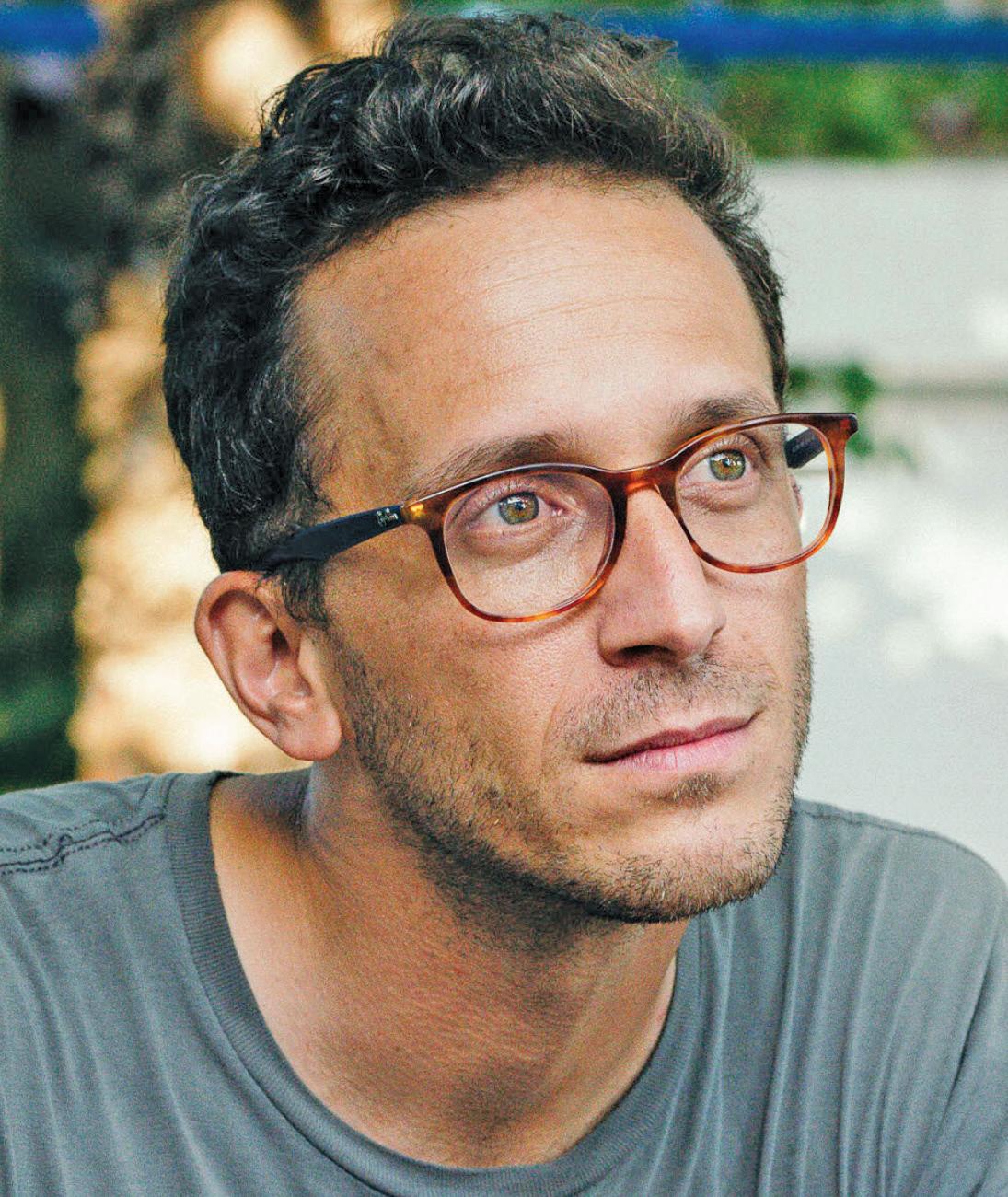
ing officer of Columbia. Do you realize that?”
He has continued to pay a price. The most recent and most public one: suspension.
In October, Davidai was temporarily suspended and barred from campus because of what the university described as the harassment of Columbia leadership. The suspension remains in place and he has no classes this semester.
Davidai will tell his story when he appears as the keynote speaker at L’Dor v’Dor 2025, a fundraiser for Hillel of Silicon Valley.
His appearance in San Jose will reflect his current role and focus. From the moment he was suspended, Davidai said, he transitioned from college professor to what he calls “community organizer.”
“I've been speaking with as many audiences as I can, engaging in conversation,” he said of his efforts to sound the alarm on increased antisemitism. “I travel around the world telling people what's happening on campus and city streets, and I help them organize.”
He has also turned to podcasting to spread his message with “Here I Am with Shai Davidai.”
A native of Kiryat Ono, just east of Tel Aviv, Davidai attended Hebrew University before earning a Ph.D. from Cornell in 2015. He became a postdoctoral fellow at Princeton and spent three years as an assistant professor of psychology at the New School for Social Research before joining
Despite his suspension, Davidai remains a faculty member and still receives a paycheck. However, the university demanded he undergo a sensitivity training course before he will be allowed back in the classroom. The professor said he’s willing to do so, except for one requirement.
He will not sign a nondisclosure agreement.
“Columbia requires that I sign a gag order about the training,” he said. “I refuse to sign. I'm completing this [training] for a crime I did not commit. So I want to be able to talk about it. I’m contesting this with a lawyer, but they refuse to work with us.”
According to his Columbia Business School bio, Davidai studies “people’s everyday judgments of themselves, other people, and society as a whole…. His topics of expertise include the psychology of judgment, economic inequality and social mobility, social comparisons, and zero-sum thinking.”
“Now that we have unearthed how deep the problems go, the goal is to create a normal future.”
Shai Davidai, Columbia professor
Campus newspaper The Spectator referenced another video of Davidai telling assistant director of public safety Bobby Lau, “You are such a useless administrator. But you know what, there were so many useless administrators in Nazi Germany. And you know what? After the war, they said they did everything they could.”
After the confrontations, the administration alleged that Davidai “repeatedly harassed and intimidated University employees in violation of University policy,” a Columbia spokesperson told The Spectator.
Davidai categorically denies the accusations.
“For the past 16 months I've never broken any rule,” he told J. “I'm aware I get very close to the boundaries, but I never do anything that breaches a rule. There are numerous videos of [protesting] students supporting terrorism, confronting faculty, cursing them. I've experienced it, too. I did not put the administration in a comfortable situation, and I admit to that. But that doesn't mean it’s harassment or intimidation.”
He said Columbia officials not only failed to provide him with definitions of the terms “harassment” and “intimidation,” they also “never replied to a few very basic questions asked by my lawyers: Who did I harass? How? What did I do? And who is in charge of this decision? I don’t know what the crime is. Given that, Columbia is the investigator, judge and executioner.”
He finds it ironic that, given his research into the psychology of judgment and decision-making, his teaching career has been “placed in purgatory,” as he put it.
“We’re never going back to normal,” he said regarding Columbia. “Now that we have unearthed how deep the problems go, the goal is to create a normal future. That has nothing to do with me. It’s a bigger issue with Columbia, the faculty, the administration and student organizations.”
He hasn’t been totally abandoned. In November, a few weeks after his suspension, more than 400 university professors, staff, students, alumni and parents signed a letter addressed to Columbia’s interim president, Katrina Armstrong, blasting the decision to suspend him.
Earlier this month, after President Donald Trump issued an executive order titled “Additional Measures to Combat Anti-Semitism,” the Department of Education’s Office for Civil Rights opened antisemitism investigations into Columbia and other universities, including UC Berkeley.
But Davidai laments that few of his colleagues have stood by him as the only faculty member suspended amid the campus turmoil since Oct. 7.
“When there’s a rally, when I come to counterprotest, very few professors show up, in a university with 5,000 professors. I work with 30 [professors] in my department, and none have said anything. These are people training America’s future leaders, and they failed.”
Davidai said he has been forever changed by what has happened to him and by the explosion of Jew hatred. But he sees an even more insidious threat than the hatred alone.
“We focus so much on educating people on the problems of hatred,” he said, “but we really have to educate on the problem of indifference. I now see on an everyday level the dangers of hatred and the dangers of indifference. They work together.” n
L’Dor V’Dor 2025, sponsored by Hillel of Silicon Valley, is set for 3 p.m. Sunday, March 9, at the Rotary Summit Center, 88 S. Fourth Street, San Jose. Tickets, $72. $18 for students. hillelsv.org/ product/ldor-vdor-ticket


GABE STUTMAN | J. STAFF
A team of lawyers is putting the finishing touches on a lawsuit against Oakland’s Jerusalem Coffee House, J. has learned, and is planning to file a complaint in state court alleging civil rights violations “very, very soon,” one lawyer said.
The lawsuit promises to launch the coffee shop back into the headlines after a series of incidents last year, including an internet firestorm when it released a “Sweet Sinwar” drink around the first anniversary of the Oct. 7, 2023, massacre orchestrated by Hamas leader Yahya Sinwar.
Plaintiff Jonathan Hirsch of Oakland is working with lawyers from the Brandeis Center for Human Rights Under Law in his complaint against the coffee shop. The lawsuit will center on an Oct. 26, 2024, incident that was captured on video and shared widely over the internet. In the video, Hirsch is sitting in the business with his young son and wearing a navy-blue hat emblazoned with a Star of David when he is told to leave.
“Get out of my business,” says Abdulrahim Harara, a co-founder of Jerusalem Coffee House. “This is a violent hat and you need to leave.”
“You can’t ask me to leave because of my religion,” Hirsch says.
“I’m not asking you to leave because of that,” Harara replies. “Are you a Zionist?”
“I don’t have to identify myself,” Hirsch says.
“Leave,” Harara says, pointing at the door.
Oakland police eventually arrive, and Hirsch and his son leave. The Jerusalem Coffee House did not respond to a request for comment sent via Instagram.
The shop, which opened in 2023, celebrates Palestinian culture and sells Palestinian-inspired items like a date tahini latte. It also hosts political events and fundraisers for Palestinians. It describes itself as “rooted in revolution.” The cafe features inverted red triangles, a Hamas symbol that represents violent resistance to Israel, on its menu and on an outside mural. The menu also features an “iced in-tea fada.”
Omer Wiczyk, a lawyer with the Brandeis Center, told J. on Feb. 12 that the lawsuit will name Harara and what he described as “the company that owns the place” as defendants.
“We’re going to be suing all of them,” Wiczyk said. “All of

them have the obligation to uphold the law.”
Wiczyk said the lawsuit will assert that Hirsch was kicked out of the business because of his religion, which violates California civil rights law under the Unruh Civil Rights Act.
The Brandeis Center, a pro-Israel nonprofit law firm based in Washington, D.C., for years focused exclusively on antisemitism at universities but more recently branched out beyond college campuses.
Wiczyk said the facts of the Jerusalem Coffee Shop case are clear-cut to him. “You can’t ask somebody if they’re a Zionist. It’s none of your business what my politics are,” he said. “It would be like if I was wearing a cross, and walked into a location and someone started asking questions about my politics. This is America. You don’t get to refuse service to Jews.” n
NIVA ASHKENAZI | J. STAFF
Two employees at the San Francisco Municipal Transportation Agency have sued the city, alleging that they faced persistent harassment, discrimination and retaliation because they are Jews.
The lawsuit, filed in late December by employment law firm Hoyer, Hicks & Gage in the Superior Court of San Francisco County, details allegations of verbal harassment against plaintiffs Alexander Lukovsky and Samuel Raphaelson. They also allege to have been targets of retaliation after reporting their complaints.
The plaintiffs worked in adjacent shops within the agency’s transit system, better known as Muni, starting in spring 2020, the complaint states. Lukovsky, 67, who is of Ukrainian Jewish descent, had worked for Muni since 1996 and was the primary target of most incidents alleged in the complaint. Raphaelsohn, 72, who is of Latvian Jewish descent, began working at Muni in May 2020.
Lukovsky and Raphaelsohn are suing the city and three co-defendants, including a Muni supervisor and a co-worker.
That co-worker began verbally attacking Lukovsky in 2017 and intensified such attacks after May 2021, the complaint alleges. The co-worker “habitually called Mr. Lukovsky a ‘Fat Russian F**got F**k,’ ‘Dirty Jew,’ and ‘cripple,’ because of Mr. Lukovsky’s hip replacements,” the complaint reads. The co-worker “seemed to believe that he could act with impunity, telling Mr. Lukovsky: ‘Go f**k yourself, I do everything I want here, and I am protected.’”
The San Francisco City Attorney’s Office, which is representing the city and the employees listed as defendants, acknowledged the lawsuit but declined to comment further.
“We are reviewing the complaint and will respond in court,” the city attorney’s office said in an email to J.
The complaint alleges that the supervisor overlooked the

co-worker’s conduct because of their personal relationship.
The lawsuit mentions a September 2017 complaint that Lukovsky submitted to human resources regarding an alleged verbal attack by the co-worker. The complaint was rejected, apparently because one incident wasn’t enough to create an “abusive working environment.”
After a May 2021 incident, the supervisor told Lukovsky that the co-worker could do “whatever he wants” and that Lukovsky should not “bother him,” the complaint alleges.
The harassment allegedly reached its peak following the Hamas massacre in Israel on Oct. 7, 2023, the complaint states.
The co-worker “praised the attack,” the complaint reads,
and told “Mr. Lukovsky that Hamas was making ‘very good progress… there will be less Jews in the world.’”
The complaint also alleges that the supervisor sought to undermine Lukovsky’s career advancement. Between April 2021 and June 2023, Lukovsky served as acting supervisor of the facility’s motor shop, but his tenure ended when the supervisor demoted him. According to the complaint, the supervisor explained his reasoning bluntly to Lukovsky.
The supervisor “wanted ‘to put the Jew in his place,’ and teach him to ‘keep his mouth shut’,” the complaint alleges.
The plaintiffs assert that the harassment, discrimination and retaliation violate California’s Fair Employment and Housing Act, the California Family Rights Act and Labor Code Section 1102.5, known as the state’s primary whistleblower protection law.
The lawsuit lists other allegations of harassment toward Lukovsky, who has been on administrative leave since February 2024.
Once Lukovsky was gone, Raphaelsohn became the primary target of the co-worker’s harassment, the complaint alleges.
The co-worker “told him, ‘all you f***ing Jews are genocidal maniacs and it is a pity that Hitler didn’t finish you off. But we will,’” the complaint reads.
Although Raphaelsohn is still a Muni employee, the lawsuit states that he is afraid to go to work due to the conduct of the supervisor, co-worker and other employees.
The complaint seeks damages for lost wages and physical and emotional distress, as well as for a declaration that the defendants retaliated against the plaintiffs in violation of the Fair Employment and Housing Act, Family Rights Act and labor code. n
NIVA ASHKENAZI | J. STAFF
A 19th-century Torah scroll rescued from the Holocaust arrived recently at Orangevale’s Temple Or Rishon, where 200 people gathered on Feb. 2 to rededicate the precious item.
For years, the scroll was stored in a former synagogue in Prague, where the local Jewish museum accumulated more than 200,000 religious objects from destroyed Jewish communities following the Nazi invasion of Czechoslovakia in 1939.
A London-based organization called Memorial Scrolls Trust sent the Torah scroll to Or Rishon as a long-term loan. Per agreement, if the congregation dissolves or merges with another, the scroll would be returned to the Memorial Scrolls Trust. If the Czech Jewish community to which the Torah belonged is ever revived, the scroll would be returned to its original home.
Or Rishon, a Reform congregation with about 250 households, was founded in 1983. Located about 20 miles northeast of Sacramento, Or Rishon is one of about 20 congregations and Jewish organizations in Northern California with a rescued Torah through the Memorial Scrolls Trust.
As one Bay Area congregation knows, sometimes the Torah scrolls actually do go home.
Foster City’s Peninsula Sinai Congregation returned one of its rescued Torahs in 2017 to the Eastern Czech town of Olomouc, where the Jewish community has re-emerged in recent years.
Or Rishon Rabbi Alan Rabishaw contacted the Memorial
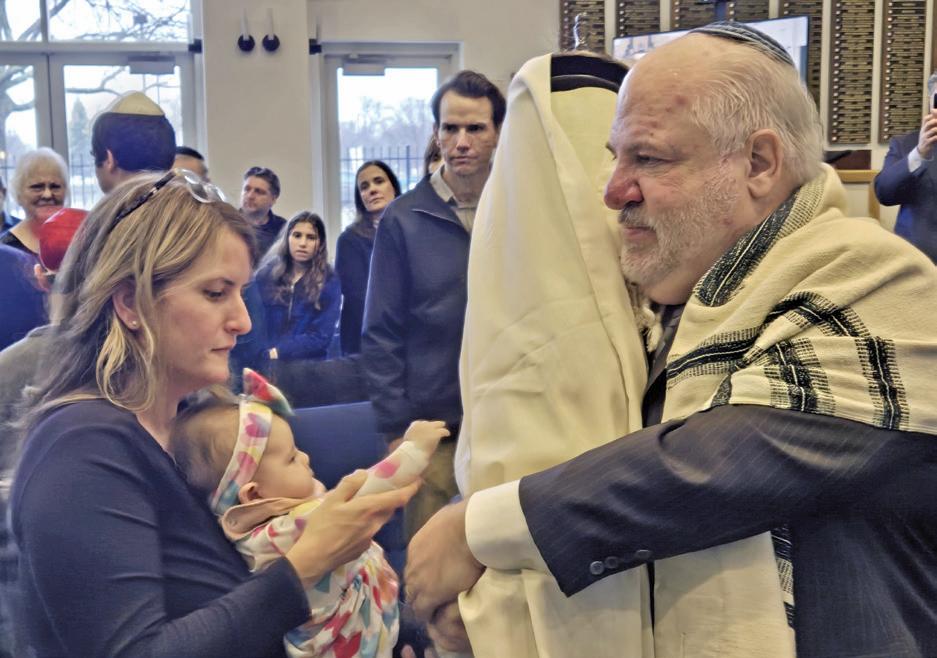
Scrolls Trust last summer, after meeting a congregant’s cousin visiting from London who is a member of the Westminster Synagogue, a London congregation integral to the founding of the Memorial Scrolls Trust.
Rabishaw emphasized how important it was for his congregation to receive a rescued Torah in good enough condition to be used during services, including for b’nai
For Senior independent living at its best
Rossmoor can be your Happy Place — with over 200 organizations, 9600 residents, 6600 manors on 1800 acres. Co-ops, condos, single family from the low $200s$2million+
Call me today for a private tour and information packet.
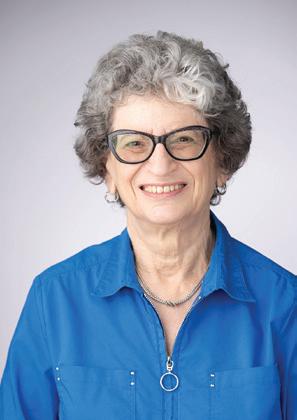
972-841-8655
RossmoorRealty.com/Libbie-Norton DRE 02078185
Become a Facebook fan facebook.com/jewishsf
Follow us on X @jewishsf
Follow us on Instagram jewishnews_sf Visit our website jweekly.com

mitzvah, rather than to sit on display as a memorial artifact.
“We don’t want one to just remind us of history,” Rabishaw told J. “We want one that would allow us to bring it back to life and to be celebrated as part of our synagogue today, not just the memory of what was.”
In November, Or Rishon was matched with Torah No. 492, a scroll from Domažlice, a small town about 12 miles east of the German border. At the height of its Jewish population in the late 19th century, 153 Jews lived in the town, according to the Jewish International Cemetery Project.
The scroll was restored by Neil Yerman, a New York-based sofer, or scribe, who has been writing, maintaining and restoring Torah scrolls for over 40 years. Although the scroll was originally estimated to be around 114 years old, Yerman told J. that he believes it is at least 50 years older, dating it back to around 1860.
Yerman traveled to Orangevale to hand-deliver the Torah to Or Rishon and join the rededication.
Since the recent releases of Israeli hostages from Hamas captivity, Rabishaw said he couldn’t help but see a bigger meaning in the ceremony.
“It wasn’t just about this Torah in particular. It was also about our shared commitment as the Jewish people to be strong and draw resilience from our Torah, from our history,” he said. “For me, it’s a message to Hamas: Those who want to destroy us will not succeed.” n

We are grateful for the special support from the Jewish Community Federation and Endowment Fund, The Lemala Fund and Craig Newmark Philanthropies.
$50,000+
California Local News Fellowship
Lisa and Douglas Goldman Fund
Jewish Community Federation and Endowment Fund
Koret Foundation
The Koum Family Foundation
The Lemala Fund*
Craig Newmark Philanthropic Fund
The Bernard Osher Jewish Philanthropies Foundation*
$25,000+
Newton and Rochelle Becker Charitable Trust
The Donald and Carole Chaiken Foundation*
Gaia Fund
Laura and Gary Lauder
Fred Levin, The Shenson Foundation in memory of the Shenson and Levin families
Susan Libitzky/Libitzky Family Foundation*
Taube Foundation for Jewish Life & Culture
$15,000+
Frederick J. Isaac Philanthropic Fund*
LION Publishers
LSP Family Foundation
Laszlo N. Tauber Family Foundation/ Ingrid Tauber
$10,000+
Elizabeth E. Bettelheim Family Foundation
Aaron and Marie Blackman Charitable Fund*
Suzanne D’Arcy and Jerry Yanowitz
Steven Dinkelspiel
Yuliya and Arron Klein
The Milton and Sophie Meyer Fund
John Pritzker Family Fund
Rittenberg Family Foundation
Rob and Eileen Ruby Philanthropic Fund*
The Harry and Jeanette Weinberg Foundation
Yerba Buena Fund
$5,000+
Tanya and Mark Bernstein*
Diana Cohen and William Falik
Contra Costa JCC
Sonia Daccarett and Alex Bernstein
Lisa Drehmel
Amy and Mort Friedkin
Firehouse Fund
John & Marcia Goldman Foundation
Eve Gordon-Ramek, in memory of Kenneth Gordon
Cheryl and Louis Haas
Hellman Family
Tricia Gibbs*
Nadine Joseph and Neil Goteiner
Carol Kaganov
Amy Lit and Andy Rittenberg
Patricia Rosenberg and Scott Nichols
Susan Sasson and Ori Sasson
Stacy Schusterman
William Schwartz
Sara Seims
Jorun and Harmon Shragge
Jane Springwater/The Klion Springwater Coven
Family Foundation
Mary and Steven Swig
Eli Weil z”l
The Lawrence Weissberg Foundation
Carol A. Weitz
Hilary Zarrow
$2,500+
Isaac Applbaum
Liz Berman and Richard Fiedotin*
Helen and Art Bobrove
Lynn Brinton and Daniel E. Cohn*
Tria and Barrett Cohn
Dana Corvin and Harris Weinberg*
Louise and Jacob Epstein
Fayne Family*
Claudia Felson*
Jill Tonkin-Finegold and Jeff Finegold*
Richard Goldstein*
William and Flora Hewlett Foundation
Jennifer Krasnoff-Homa and Eitan Homa
Sarah and Jordan Hymowitz
Alex Ingersoll and Martin Tannenbaum
Roslyn Kahn*
Kendra and Thomas Kasten
Cathy and Jim Koshland
Sara Gaviser Leslie and Josh Leslie
Andrew Litwin
Daryl Messinger and Jim Heeger*
Jessica Pers and Robert Stein
Anne and Nathan Petrowsky*
RMLow Foundation
Nanette Rowe and Gary Leight
San Francisco Humanities, Inc. in memory of Emil Knopf z’’l
Gayle and Eric Starr
Joelle Steefel*
Carey and Noah Wintroub
$1,800+
Pam and Larry Baer
Valli Benesch and Bob Tandler*
Katherine and Marc Berger
Amy and Matt Berler*
Sandra Bragar and Jerome Rossen
Julie and Paul Candau
Stuart Corvin
Ilana DeBare and Sam Schuchat
Julie Dorsey and Daniel Leemon
Leslie and Raphael Edelman
Emily and Dave Fisher
Lisa C. Friedman and James D. Harris*
Virginia and Randy Hess
Eileen Ingenthron
Jo Ellen Green Kaiser
Lily Kanter and Marc Sarosi
Barbara and Ron Kaufman*
Judge Quentin L. Kopp (Ret.)
Barry Kramer
Felicia Hsin Liu and John Tamor Citron
Caroline Fromm Lurie and Rabbi Brian Lurie*
Nancy W. Marks in Memory of James and Roslyn Marks
MSS Charitable Fund
Barbara Oshman
Joann T. and Richard Philips*
Sharon Rogoff
Tina Sharkey*
Lydia Shorenstein
Sinai Memorial Chapel
Karla and Neil Smith
Barbara Sommer and Alan Fisher
Holly and Jeff Ullman*
Barbara and Scott Waxman
Beth-Ann Schwabacher-Wenger and Marvin Wenger
The Bennett and Donna Yanowitz Family Foundation
Jill and Stefan Zechowy
$1,000+
David Agger*
Julius Aires*
Sharman Spector-Angel and Gary A. Angel
Judy and Robert Aptekar
Linda and Mike Baker*
Eileen and Ralph Battat*
Marsha Lee Berkman and Norman Berkman
George W. Breslauer
Patricia C. and Richard M. Briskin
Gerald Buchwald
Madeline Chaleff and David Arfin*
Judy and Mark Cohen
Steven J. Cohen
Maya and Steve Cohn
Congregation Emanu-El, San Francisco
Phyllis Cook and David Cook z”l
David Cornfield
Adele Corvin
Alexandra Corvin and Eric Walder*
Valerie and Scott Corvin
Ofra Daniel and John Gertz
Nelson B. Delavan Foundation
Gayle Donsky and Morton Stein*
Dori and Barry Dubin
Judith and Joseph Epstein*
Susan and Bill Epstein
Fenster Family
Carol and Howard Fine*
Gail Friedman and Martin Harband
Jennifer and Abe Friedman*
Karen Galatz and Jon Wellinghoff
Jessica and Stephen Galloway
Inna Gartsman and David Nelson
Susan and Howard Geifman*
Mariela and Richard Gerstein
Christine Glastonbury and H. Michael Feldman
Juliette and Jeffrey Goldman*
Meredith J. Goldsmith*
Sally and Richard Goodman
Alia Wechsler Gorkin and Travis Gorkin
Diana Grand and Jon Holman
Allison J. Green
Greenstein Family in memory of Morey Greenstein*
Marsha and Ralph Guggenheim
Linda and Eric Horodas
Jill Horowitz z”l and Jonathan Kaufman
MacKenzie and Tam Huynh
Paula and Dennis Jaffe
Elizabeth Jaroslow and Marc Lipsett
Valerie Jonas
Laurie Kahn
Gia Daniller-Katz and Steve Katz
Hannah and Allen King*
Janet King and George King z”l
Patty and Mike Krigel
Jack Lapidos
Allison and Richard Lenat
Sharon and Seth Leslie
Monica Levin and Nancy Igdaloff
David Levine
Julie Levine
Fred Levinson*
Shari Libicki and Andrew Coblentz
Linda and Sidney Liebes Jr.
Jeanne and Peter Mandell
McNabb Foundation
Judith and Andrew Mendelsohn
Toby Mickelson and Donald Brody
Susan Moldaw and Bob Stallings*
Gladys H. Monroy and C. Lawrence Marks*
Rabbi Deborah A. Newbrun*
Jan and Robert Newman*
Tari and Bill Nicholson
Lea and Allen Orwitz
Tamasin Partridge and Jack Halperin
Eda Pell
Lory Pilchik and Rich Bayer
Peter Pollat*
Joyce and Kenneth Polse*
The Press Forward Administrative Fund at The Miami Foundation
Purple Lady/Barbara J. Meislin Fund*
Irving and Varda Rabin Foundation*
Janet Reider and Tom Frankel
Robbins Family
Esther Rogers and Robert DeBare
Susan and John Roos*
Helen Rutt and Gil Ohana
Carol and Harry Saal*
Betty and Jack Schafer*
Emily and Jim Scheinman*
Reva and John Segall
Sklar Family Fund
Deborah and Michael Sosebee*
Vera Stein*
Cheryl Zatkin-Steres and George Steres*
Roselyne Chroman Swig
Judy Tick and Steven Ganz
Gertrude Waldmann
Arthur J. Weil
Patricia and Alan Werba
Anita L. Wornick*
Diane C. Zack and Howard B. Zack*
Charene Zalis and Peter Waldman
Victoria and Steven Zatkin
Jessica Nutik Zitter and Mark Zitter*
$500+
Jeryl and Ronald Abelmann
Gilah and Mark Abelson
Liki and Joe Abrams
The ALL Share Fund
Nancy Alpert*
Nathan Apple
Rona Bar-Din and Theodore Levin
Susan and Gordon Bardet
Wendy Bear*
Josh Becker
Cheryl and Randall Berger
Eve Bernstein and Alex Gersznowicz
Nersi Boussina
Bonnie Burt and Mark Liss*
Susan Carey
Chizen Family Foundation
Arthur B. Cohen
Barbara and David Cohen
Carol Cohen z”l
In memory of Carol Cohen, Altamont Capital Partners
Lisa and Dick Cohen
Susan and Mitchell Cohen
Jeff Colvin
Susan B. Crystal
Win Derman
Sue Diamond and Marty Schenker*
Frances Dinkelspiel and Gary Wayne
Avi Downes and David Bilsker
Peter L. Dwares Foundation
Laurie Earp and Denis Chaix
Jeanne S. Eber
Beth and Norman Edelstein
Sandy Edwards
Lori Feldman and Gary Caine
Sarah and Rabbi Joseph Felsen
Ruth Finkelstein
Martin Fleisher*
Selma and Paul Forkash
Barbara Franklin
Ednah Beth Friedman
Marianne and Herb Friedman*
Robert Gardner
Mimi Gauss*
Karen Glikman and Jerene De Laney
Gayle and Steve Goldman
Cathy Dobbs Goldstein and Philip Goldstein
Millie and Henry Goltz
Gittel and Nachman Goodman
Laurel and Michael Gothelf
Arlene Leslie Gould
Samantha Grant/The Wiesler Family
T. and D. Green
Danielle Hacker and Jake Teitelbaum
Devorah Harris and Larry Abrams
Hershey Baer Fund*
Karen and Jim Holtz*
Helen Hubert
Penni Hudis
Sandi Hyman
Ava Kahn and Mitchell Richman
Bonnie Kalbrosky
Linda and Tom Kalinowski
Philip N. Kaplan
Terry Karl
Tobye Kaye
Donor names continue on pages 18-22
$500+ CONTINUED
Nancy Klehr
Sheryl and Tony Klein
Beth Kleiner and Bruce Kirschner
Deborah Knapp
Eileen Kopec
Anne Krantz and Mark Gunther
Doris and George Krevsky
Edouard Kujawski
Linda and Frank Kurtz
Sue Levin
John Lewin
Galina and Lev Leytes*
Beverly and Herb Liberman
Judy and Steve Lipson
Melanie Maier*
Susan and Jay Mall*
Douglas Mandell
Robbin Mashbein and Steve Lipton*
Lindsay and Michael Meyer
Marla Miller and David Kremer
Micki U. Miller
Gale Mondry and Bruce Cohen*
$360+
Toby Adelman • Sereen and Herbert Barasch
Linda Myszak and Lawrence Prager
Martha and Richard Pastcan
Aliza and Raanan Peleg
Karen Pell and Heather Lupa
Danielle Pener and Kevin Frisch
Karen Kaufman Perlman and Brian Perlman*
Harriet Prensky and William Pomeranz*
Mary and David Rabb
Amy Rabbino and Neal Rubin*
Norman Reid
Robin Reiner and Frederick J. Isaac
Alissa Robinow
Cindy Rogoway and Joe Goldberg
Marlene and Stanley Rosenberg
Mindy and Philip Rosenberg
Barbara and Sheldon Rothblatt
Marcia and Steve Ruben
Alix and Sam Salkin
Gail Pastor Sara
Lela and Gerry Sarnat
Dorothy R. Saxe*
Amy and Dan Schiff
Randee Seiger
Marcee and Mark Samberg • Samiljan family
• Maureen and Michael Samson • David Saxe
• David Schnur
• Jeanie and Richard Schram
Seiler Family Fund*
Robyn and Mark Setzen
Madeline and Steven Shakin
Shoresh Foundation
Sheri and Paul Siegel
Stacey Silver and Jonathan Yolles*
Valerie Sopher
Sheila Sosnow and Richard Nagler
Deborah and Larry Stadtner
Beth and Philip Sunshine
Lisa Tabak and Jeffrey Lipsett*
Michelle and Keith Tandowsky*
Pearl Vapnek z”l
Harriet Weiss
Kay and David Werdegar
Ruth Donig-White and Robert E. White
David L. Williams
Linda and Steven Wolan
Judith Wolfe and Jennifer Hughes
Susan Wolfe
Judy and Steve Zimmerman
Norma Zimmerman
Howard Bronstein • Ellen and Herb Brosbe* •
Ruth S. Bruner • Priscilla Buchman • Renee and Morris Budak • Roy Bukstein • Helen
• Judy Baston • Ina and Steve Bauman • Ari Beliak
• Roberta Berg and Stan Roodman
• Susan Borkin and Jerry Hurwitz • Nancy and Les Burger
• Barbara Cahn • Susan and Jeffrey Callen
• Lisa Chanoff
• Elly and Steve Cohen
• Debbie and Barry Cohn
• Rabbi Mychal and Kirsti Copeland
• Robbie Cohn
• Toni and Ben Coplan • Hali Croner and Eugene Palmer
• Liz and Hersh Davis • Andrea and Steven DeGraff
• Sandra and Conrad Donner
• Liz Einbinder
• Kenneth Einstein
• Shirley and Ben Eisler
• Vicki and Matthew Feinstein*
• Lori and Michael Fineman • Jerome Fishkin
• Debbie and Gary Frank • Frankenstein Family • Linda Gerard and Daniel P. Grossman* • Ellen Konar Goldband and Steve Goldband • Julie Goldman and Bob Rosner • Stella and David Goodwin • Jennifer and Toby Gottheiner
• Shelley Gottlieb
• Diane Green • Barry Gross
• Reyla Graber • Rabbi Sarah E. Graff
• Judy Hahn and Ben Lerman • Carolen and Douglas Herst • Johanna and Jeffrey Ilfeld
• Leslie Kane and Manuel Fishman • Julie E. King and Donald M. Abramson* • Luba Kipnis • Cary and Manny Kopstein • Rachel and David Krug
• Bobbie Landau • Rachel Landes • Rena Leibovitch* • Patricia Lerman
• Debra and Mark Leslie • Deborah Pollak
Levy • Sarah Liron and Sheldon Kahn
• Siesel and Howard Maibach
• Rabbi Janet Marder • Dawn and Sandy Margolin • Deanne Meyer • Denise and Erik Migdail • Jane and Michael D. Miller
• Rochelle and Robert Miller • Susan Morris • Shelley Barlas Nagel • The Nash Family Fund • Sharon Churnin Nash • Joel G. Neuberg • Betty Newman • Stephanie and Lee Notowich • James W. Olson
• Shari and Donald Ornstein*
• Judy Penso and Marc Manason • Aviva Levy-Piser and Steven Piser
• Wendy and Fred Pomerantz • Nancy and Norman Price*
• Fran Quittel
• Rayna and Richard Ravitz
• Barbara Regello
• Moe and Eddy Rubinstein
• Susan and Robert Rushakoff • Christine Mariscal Salomon •
• Rebecca and Mark Schulman Family • Leonard Schwab
• Rebecca Shpall and Ron
Sandel • Arthur Slepian • Steven Solomon* •
Karl Sonkin
• Lynn and Michael Stein • Zoe
Stein
• Stolowitz Anderson Family
• Bonnie
Strauss • Leah Swiler
• Lonnie Weiss • Martha
Whittaker • Lori and Bob Wick • Rhoda Wolfe
• Lawrence Yermack
• Marilyn Zimmerman and Rob Mickel
$180+
Sy Aal • Allen Ackerman • Betty Denenberg
Adler • Martha and Michael Adler • Alameda Land Company Inc. • Rina Alcalay and S. Osborn Erickson • Carol Allen • Marilyn Allen
• Marjorie Alpert and Jeffrey Warwick • Edward J. Anisman • Molly Antopol and Chanan Tigay • Sonia Apfelblum • Jo Anne
Appel • Julie and Buddy Arnheim* • Jennifer and Rabbi Raphael W. Asher • Merry Astor • Cheryl and Marc Bader • Balaban Familly • Shoshana and Ephraim Bander • Pam and Adam Barasch • Lynn and Ken Baron • Rosyland and Bob Bauer • Rickie Ann and Rick Baum • Beverly Jean Becker • Roger A. Becker • Jamie Beckett • Cathy and Ken Begun • Jay Begun • Selim Shlomo Bencuya • Joelle Benioff • Sandra J. Sherman Benjamin
• Sherry and Burton Berenstein
• Julia and Adam Bergman
• Iris Berke • Arlene and Dan Berkley • Nora and Brian Berman • Harriet
Berner • Linda Bernstein and Gary Stein •
Margery and Myron Bernstein • Rachel Biale and David Biale z”l • Carol Bieri and Joel
Sanders
• Beverly Blatt • Sandee Blechman and Steven Goldberg
• Linda Blum • Rochelle
Blumenfeld • Anne and Daniel Bookin • Liz and Richard Bordow
• Mark Bostick
• Suzanne J. Borsuk
• Karen and Steve Bovarnick • Jane and Jeff Boyarsky • Leela de Souza
Bransten and Peter Bransten • Sophie
Breall
• Susie Brenner
• Karen and Ted Bresler
• Patty Breuer
• Ruth Broady
• Paula Brinkley • Anne Brisgel
• Joan and Joel Brodsky •
Bulwik • Cecily Burke • Suzanne and Jeffrey Cantor • Robyn Carmel • Andrea and Michael Cassidy • Elizabeth Cedars and Christopher Reiger • Danise Chandler • Philip Charney • Ruth and Michael Chavez • Corey and Rod Cherkas • Steve Cherwon • Dvora and Eric Citron • Mary E. Claugus • Loren Cobb • Arlene and Art Cohen • Marsha Cohen and Robert Feyer • Melvin Cohen • Sheri Cohen and Charles Green • Skylar and Peter Cohen • Judith Siegel Cohn and Harry Cohn • Adam Cole • Susie Coliver and Bob Herman • Leslie Colvin and Jed Solomon • Adriane Concus and Jeremy Lieberman • Gita Constantin • Anna and Leon Cooper • Linda and Daniel Cooperman • Coryell and Weinberg Family • Lael Culiner and Josh Smith* • Jean Curran and Jeffrey Sosnaud • Angela Dalfen and Liz Noteware • Elayne R and Philip S Dauber • Margit David • Susan David • Alexander Davis • Claire and James Davis* • Donita Decker • Ruth Dell • Marci and Marc Dollinger • Joanne Donsky and Stuart Oremland • Davina Drabkin • Carolyn and Elliott Dushkin • Jon Eager* • Madelaine Eaton • Betsy Eckstein and David Heller • Helene and Lawrence Edelman • Beth Ehrlich • Beth Eiselman • Jessica and Michael Eiselman • Angela and Eli Eisenpress • Ellyn Elson • Steve Elster • Helen Emmerson • Miriam Engel • David Epstein • Sandra P. and Edwin M. Epstein • Robert Ertsey • CJ and Irwin Feinberg • Anita and Steve Feinstein • Leslee and Wayne Feinstein • Sanders Feldhorn • Nancy H. and Cantor Martin Feldman • Shirley and Marc Feldman • Chaplain Bruce Feldstein • Leah and Adam Felson • Marian and David Finkelstein • Rena Fischer • David A. Fisher • Toby Flax • Joan and Michael Fox • Joanne and Bruce Friedman • Linda and Daniel Friedman • Susan and Marvin Friedman • Karen Winkleman-Furman and Bruce Furman • Peggy and Mike Fuson • Gabriel Family • Janet Gallin • Gwen and Martin Gans • Judy and Michael Garb •
Leslie and Philip Gardner • Debi Geller and Ed Zimmerman • Corinne Jaffe-Gellman and Steven Gellman • Jerilyn Gelt • Adele Gershater • Mindy Gerson and Jeff Cohen • Elaine Gerstler and Booker Holton • Irma Glazer • Barbara Gleichenhaus and D. Peter Gleichenhaus z”l • Rivka Sherman-Gold and Irving Gold • Annelise Goldberg and Aaron Roland* • Daphne Goldberg • Janet Goldberg
• Linda Goldberg • Sandra and Robert Goldberg • Ruth and Larry Goldenberg • Mark Goldman • Ellen Goldstein • Estelle Goldstein z”l and David Goldstein • Marjorie and Stuart Goldware • Susan and Richard Goldwasser • Elisabeth and Stephen Goodman • Dorothea Gordon and Charles Gordon z”l • Joan Gordon and William Cohen • Alan J. Gould • Evelyn and Rabbi Roberto Graetz • Rabbi Jessica and Jonathan Graf • Phylis and Gerald Greenbach • Nancy Greenberg and Martin A. Segol • Leah Greenblat • Barbara and Gary Greensweig • Barbara Gregoratos and Jeff Brandstetter • Linda Greig • Susie and Alan Greinetz • Joan and Stanley Gross • Deborah Grossman • Jane Grossman • Susen Grossman • Alice J. Gruber • Sylvia Guendelman • Lisa Gurwitch* • Minette and Isac Gutfreund • Lea Hallert and Jeremy Korito • Marc E. Hallert • Margaret Hand and John Hartog • Karen and Ken Harley • Cindy and Larry Harris • Esther and Norman Harris • Judi Elman Harris and Gordon Harris • Cheryl Harrison and William Perell • Eric Hassall • Shelley S. Hebert* • Susan Heller • Marc Hershman • Karen and Howard Hertz • Steven R. Hibshman • Marilyn Dobbs Higuera • Bonnie and Lee Hirsch • Lois Hirsch • Floris and Dan Hoffenberg • Elizabeth L. Hogan • Sarith Honigstein • Susan Hootkins • Karen and Allan Horn • Susan Norwick Horrocks and Keith J. Horrocks • Joanne Howard • Kathleen Hunt • Vivien Igra and Howard Simon • Joy and Jonathan Jacobs • Helen Jaffe* • Joanne and Jeff Jagoda • Martin Javinsky • Jewish Family and Children’s Services • Richard Johns • Jane Jordan • Susie Julius • Mady and Mel Kahn • Vicki and Scott Kahn • TJ Kahn •
Margie and Lawrence Kaminsky
• Sydney Kapchan
• Judy and Michael Kapiloff
• Barbara Paige Kaplan and Martin L. Kaplan
• Jill Kaplan and Richard Moss
• Marjory Kaplan and Dan Granoff
• Joan M. Karlin and Paul Resnick
Ann Rosenberg and Lawrence Kampel
Diane Rosenberg
• Grace Rosenberg
Rosenberg and Andy Muchin
Rosenberg
• Karen M. Rosenthal
• Laura S.
• Stuart
• Bernard
•
Lainy Williams • Caryn and Ben Wiseman •
Martha Ann and Sandy Wishnev • Philip
Witte • Linda Wolf and Alex Gelber • Linda
Ross
• Linda and Ronald Rossen
• Sheree and Ronald Roth*
• Lisa and Neil Rothstein
•
• Doni Katz
• Elliot M. Katz
• Leonard
• Sharon Karlsberg and Craig Sakowitz
Katz
• Leslie Katz
Suzanne and Robert Rubenstein
• Tobi and Mark Rubin
• Arlene and Larry Saidman
•
Press Wulf and Stanley Wulf • Emerald Yeh and Ron Blatman • Jacques Yenni • Dianna and Chaplain Joel Youngheim • Judy and Mark Yudof • Victoria Zackheim • Caryn Huberman Yacowitz • Irina and Herman Zaks
Rochelle and Michael Blackman • Emily Blanck • Paula and Joel Blank
• Sharon L. Bleviss
• David Blatteis
• Carol and Roy Blitzer
• Nina Block
• Susie and Rick Block • Nancy Agronin Blonsky and Howard Blonsky • Diane and Howard Bloom • Fredi B. Bloom • Gail Bloom and Edward Green • Harriet Bloom
• Fran Tannenbaum Kaye and Brian
• Ruth Katz and Michael Rapaport
Kaye
• Robin Keller and Mark Geliebter
• Joy and Joel Kellman
• Doris and James Kelly
• Phyllis Kempner and David Stein
• Marlene and Ilan Keret
• Jan and Randy Kessler
• Deena and Robert Klaber
• Emmeline Klama and Andy Levine
• Linda and Leon Klapper
• Wendy and Howard Kleckner
Esther Saidman and David Thorne
Saldinger
• Gayle
• Gitta Salomon and Ovid Jacob
Judy and Hillel Salomon
Shelley and Loren Saxe*
• Jeff Saperstein
• Larry Scharf
Karlyn Schneider • Stephen Schneider
•
•
•
• Natalya and Michael Zatkin • Rochelle and Jay Zimmer • Bernard Zimmerman • Lonnie Zwerin and Frank Mainzer
• Judith L. Bloom • Judy and Jordan Bloom* • Rosalind and David Bloom • Debbie Bloomberg
• Judith Bloomberg and Michael Barnett • Gayle and Michael Blum • Marion Koerper Blumberg z”l and Robert S. Blumberg
Up to $179
• Judith and Peter Schumacher
• Lenore Schorr
• Lynne and Allan Schuman
• Patricia and Leonard Blumin • Ellen Bob and David Waksberg • Riva and Kevin Bobrowsky
• Candee and Jack Klein
Kletter
• Jodi Klein
• Evan Kletter
• Stuart Klein
• Esther
• Rachel and David Kliger
• Greg Knell
• Gail and Steve Koff
• Ruth A. Kohan
• Tanir Ami Konecky and Josh Konecky
• Jared Koppel
• Carla Kozak
• Bette and Stewart Schuster
• Susan and David A.
• Florette Schwartz • Gail and Frederic Schwartz
Schwartz • Donna and Craig Seidel • Yolanda
Selwitz • Gail and Steven Shak • JoAnn R.
• Terry Kulka
• Clarissa Kripke and Gail Ludwig
• Deborah and Fred Kurland
• Mike Kurtz
• Caryl and Ken Kurtzman
• Rabbi Noa Kushner and Rabbi Michael Lezak
• Carole and Alan Kushnir
• Susan and Charles Lakatos
• Audrey Lampert z”l
• George Landau
• Karen and Mark Lawrence
• Randy and Rich Lavinghouse
• Daniel Lehmann
• Naomi and Rob Leonard
• Eve and Jerry Lerman
• Henry Lerner • Deborah and Michael Lesser
• Mary and Andy Lesser
• Susan G. Levenberg
• Rina Levin
• Louise Levy
Levy
• Michael M. Levine
• Evelyn and Daniel Levin
• Sharon and Jay
• Gordon Lewin
• Levy
• Shirley
• Judy and Gene Lewit
• Ron Lezell
• Judy and Maynard Lichterman
• Dale Liebes
• Elliot Liff
• Marc A. Lipschutz
• Cassie and Mickey Luckoff
• Marcia and Lawrence Lusk
• Daniel A. Magid
• Gwen and Patrick Mahoney
• Elyse and Ivan Maltz
• Adrienne Mannis
• Susan Marantz
• Stacy Margolin and Howard Zangwill
• Barbara Margolis
• Susana and Steve Maron
• Samantha Martin and Jesse Richmond
• Marjorie Medress
• Susan and Willy Mautner
• Debbie and Al Medvin
• Jane Melnick and Eric Brondfield
• Nicole Menache
• Donna Mendelsohn
• Agnes B. Mendelson
• Malcolm Mendelson
• Iris Metz
• Amy Metzenbaum and Joel Yanowitz
• Risa Meyer
• Lori and Gary Meyers
• Bryna and Robert Miller
• Elise and Rabbi Jay Miller
• Jeanne Miller*
• Richard Miller
• Edie and Richard Mills
• Michael Milstein
• Modena Barasch Family
• Irene and Stephen Moff
• Jodie and Jeff Morgan
• Miriam and Richard Morgan
• Marvin Moskowitz
• Susan PhillipsMoskowitz and Peter Moskowitz
• Jamie and Mark Myers
• Joseph Nadel
• Lawrence Nathan
• Lenore Naxon and Bill Black
• Lynne Newhouse-Segal and Edward Segal*
• Michelle and Alexander Newburgh
• Adam Noily
• Daphna and Shamy Noily*
• One Market Restaurant
• Hilary and
• Gene Osofsky
• Karen and Gary Patou*
• Peninsula Temple Sholom
• Susan Percal
• Jan Pepper
• Marilyn Paul
• Miriam Perlson-Cohn
• Carolyn and David Perlstein
• Linda and Les Plack
• Mike Policar
• Norman Plotkin
• Jing and Joel Piser
• Janis Sherman Popp and Richard Popp
• Jerome Potozkin
• Lucita and Kenneth Prager
• Frana Price and Rick Ohlrich
• Leslie and Merle Rabine
• Joan and Stephen Reich
Jaffe Reynolds
• Jane and Michael
Sandra and Chris Rich
• Clifford Booth • Bonnie Boren and Phil Weil
Shank • Judy B. Shanks and James S. Gracer • German Shegalov
• Tiffany Shlain and Ken
Goldberg • Shira and WIlliam Shore
• Barbara
J. Shragge • Lara Shumer • Judie Siddall and David Hoexter
• Bonnie Siegel • Shabana and Charles Siegel • Donna and Jerry Silverberg •
Heather and Norman Silverman • Marilee
Silverstein z”l
• Sheila Simon • Michi and Steve Sloan
• Felice Smith
• Jackie Smith and Robert Smith z”l
• Iris Greenberg-Smith and Jeremy Smith • Sandy Faith Smith
• Steven A. Smith • Valerie Snart • Susan Snyder and Steve Sockolov • Marian and Abraham
Sofaer* • Pauline and David Soffa
Solomon
• Lisa Kay
• Karen and Jeffrey Sommers
• Goldie Sosnick
• Diane and Jerry Spagnoli
Betty and Robert Spiegelman
• Naomi and Alan Spiegelman
•
Amira and Joseph Abel • Monica and Mark Abrahams • Jenny Goodman Abrami and Dan Abrami • Irene Abrams* • Brian Abramson • Diane Abt and Michael Zielenziger • Allison and Ron Abta • Layli and Teddy Adelstein • Yvette Adida • Hans Adler • Judy Adler • Sue L. Adler • Susane and Miles Adler • Susan and Earl Agron • Sylvia Alderman • Marion Alexander • Susan Alexander • Terry Pink Alexander • Abbey Alkon and Jonathan Leonard • Rita Allen • Richard J. Almond* • Doreen Alper • Elizabeth Alpert • Howard Alter • Karen L. Alter • Carol Altwarg • Susan Amdur • Adele Amodeo • Barbara Amrofell • Dottie Anderson • Bruce Andich • Susan Andrade • Leonard Anspach • Lola and • Jose Antman • Cheryl L. Anton • J.R. Anziani • Susan and David Apfelberg
• Chris and Rich Aptaker • Richard Aptekar
• Kelly Arbor
• Joanne and Bernard Arfin
• Fran and Gary Aron • Myrna and Stuart Aronoff
• Debby Arzt-Mor • JoAnne
• Isaac Aronow • Asya and Alex Arzhintar
• Judy and David Stein
• Lisa and Bruce Steinback
• Doreet Stein
• Naomi and Robert Stamper
• Mary and Mark Steiner
• John F. Steinfirst
• Apryl and Raymond Stern*
• Charlene Stern and Michael Irwin
• Joan C. Stern
Auerbach • Marty Aufhauser • Vivian and David Auslander
• Susan Austin and Michael Charlson • Patricia Avery • Aviva In-Home
Care • Claire Axelrad and Mark Pahlavan • Amir Axelrod
• Leah Baars
• Sylviane Borenstein • Patty and Steve Bort • Vladimir Boshernitsan • Nancy Boughey • Karen Bowen • Marilyn J. Boxer • Yvonne and David Boxerman • Bernice Bradley • Janet Braff • Mae Bragen • Jacquelyn Brand • Stanley Brandes • Bethanie Brandon • Allen Brandstein • Ann Brandt • Steven Branoff • Daphne and Robert Bransten • Sheila and Art Braufman • Leslie and Mike Braun • Richard B. Braunstein • Mollie Breger • Dorothy Breiner • Jane Brenner • Adrienne and Michael Bresler • Rhoda and Martin Bress • Sue Adler-Bressler and Dave Bressler • Kay and Arthur Brief • Ruth Brill • Hannah Brodzinsky • Emilie Bromet-Bauer • Eleanor Bronner • Andrea Brooks • Yardena Brooks • William Brostoff • Barbara Brown • Sharon and Ron Brown • Joan Brownstein • Mary Ann Brownstein • Beth and Chuck Brummer • Tamara Buck • Don Buckter • Vicki and Wayne Buder • Dmitry Budker • Bobbie and Denny Burger • Linda Burgess • Jerome Burke
• Sue and Ronald Bachman* • Gary Bachrach
• Marilyn
• Sandra and Jon Stern • Cindy and Phil Strause
R. Sugar
Surkin
• Lara and Paul Sunshine*
• Jacqueline and Stephen Swire
• Janet
• Ellen and Eugene Switkes
• Gail and Paul Switzer
Laura Talmus and Ace Smith
Susan and Jeff Tarran
• Emily Tarran
• Rochelle Teising
Inbar Telem and Martin Lowenstein
• Carol Tereszkiewicz and Zachary Zimmerman
• Veronica Tincher • Gail Todd
• Jon Tolson
• Diane and Dave Toole • Gunda Trepp
• Jacqueline and Steven Tulsky
• Ellen Turbow
•
•
•
•
• Anita and Howard Backer
• Susan Backer
• Mikki and Jerry Baer
• Karin Baird
“I support J. because it provides me with invaluable insight into my local community.”
Elizabeth Turover • Harriette Unger • Aline
Usim • Shayna and Derek van Hoften
• Wendy and Jeremy Verba*
• Rae Victor
• Orit Vogel
Bonnie Volk and Jonathan Blatteis
Wahba • Marilyn Yolles Waldman*
• Tamara Wallenstein
• Rachel
• Alix Wall
• Rabbi Amy Wallk and Rabbi Mark Cohn*
• Jodi and Buddy Warner • Suzanne Waterman • Steve Waxman • Alice Webber and Stephen Tobias
•
• Cara and Jonathan Baker
• Ronnie Balan
• Marg and David Ballo
• Alana and Jacob Ballon
• Debbie and Yeshaya Ballon
• Linda and Michael Bandler • Adrienne and Michael Bank
• Jacob Burland • Vicki and Barry Burstein • Prucia Buscell • Yonina Bushell • Miriam and Jerry Butrimovitz • Robert S. Cahn • Ineko and Joshua Callman • Kathy and Milt Camhi • Libi Cape • Mylene Caplan • James Carlson • Jeffrey Carmel • Jeanette and Martin Carr • Wendy and Edmund Case • Helene and Daniel Casella • Marge and Marc Caspe • Joseph Caston • Rachel Cauteruccio • Alysa Chadow • Eileen Chadwick • Ellen Chaitin • Malca Chall
• Ezra Barany
• Nancy E. Bardoff
• Larry Barnblatt
• Michael Barclay
• Zakhar Baran • Bella Barany
• Corinne and Alan Barkin
• Michael Barricks • Peggy Barron • Baselj family • Frank Battat • Fabio Baum
• Sandy and Ed Baumgarten • Sheila and Murray Baumgarten
• Jackie and Bertrand Baylin
• Elliot Beckelman • Linda G. Begen-Peltz • Ellen Beilock and Sheldon Schaffer • June D. Bell • Gail Belz • Hagar
Ben-Eliezer • Gail Ben-Zeev • Carol and Leslie Benet
• Sheri Benjamin
• Fran and Alan Bennett
• Mira and Zeev Ben-Oni • Judy and Marty Berg
• Karen Bergen
• Jessica Berger • Marcia and David Berger • Phyllis and Arthur Berger • Rona Miller Berger
• S. Berger • Alice and Larry Berger-Lowenstein • Beatrice Bergerman
• Esther Berick
• Cindy and Darryl Berk
• Margaret and Ian Berke
• Jerry Berkman
• Tiela Chalmers • Michael Chanowitz • Melissa Chapman • Adam F. Chase • Millie and Barry Chauser • Victoria Chen • Bee and Manny Cherkas • Michael R. Chertok* • Harve Citrin • Rosalind Citron • Steven Clair • Leona Cleaner • Andrew Cohen • Arthur I. Cohen • Aviva Cohen • Ellie Cohen • Eve Cohen • Howard J. Cohen • Laureen and David Cohen
• Janice and Dennis Berkowitz • Pat and Marvin Berkson
Berland
• Joanna and Allan
• Barbara Berman • Ellie Berman • Ian D. Berman
• Laurie and Mark Berman • Marcy Berman • Sharon Berman • Diane and Ed Bernbaum
• Joyce
• Nancy and Jerry Rauch
• Rice
• Gerald T. Richards
• Sherri Richards
• Gerald Roberts
• Deborah and Jeff Roisman
• Diane and Joe Rolfe
• Susan Romer and Don Ungar
•
• Joyce and Norm Weil*
• Margaret and Curt Weil
• Donna and Stewart Weinberg • Joyce Weinberg • Stephen
E. Weiner • Emily and Maurice Weinger • Elyse and Barry Weinstein • Helaine Weinstein and Maurice Kamins • Rhona and Harvey
• Judy and Ed Berne • Rhonda Berney • Suzan Berns • Barbara Bernstein • Cathy Bernstein
• Diane and Jeff Bernstein • Leah and Ralph Bernstein • Marilyn and Allan Bernstein
• Mark Bernstein
• Susan and Allan Bernstein
Weinstein • Robin and Barry Weinzveg • Veronica and Philip Weismehl • Rebecca
• Laura Rooklin
Rosekind and Jordan Lourie
• Stephanie
• Susan and David Ron
• Jeff Rosen
•
Weiss • The Weissman Foundation • Lisa and Matt Wertheim* • Peter Wexler •
• Beth Am Clergy • Susan Bettinger • Tila Bibliowicz
• Frances Birnbaum
• Robin Birdfeather
• Paula Birnbaum and Neil Solomon
• Aviva and Michael Black • Cheryl K. Black and David A. Brown •
• Marjorie and Jules Cohen • Sabina and Andrew Cohen • Seymour I. Cohen • Shirley J. Cohen • Susie and Joel Cohen • Suzy Locke Cohen and Marvin Cohen • Arlene CohenHitchcock • Arnold Cohn • AudreyShira Cohn • Kathleen and Buzz Cohn • Barbara and Alan Coleman • Lynette Collins • Jennifer Colosimo and Robert Belzer • Celia and Paul Concus • Andrew Condey • Anne Cook and Jeremy Solterbeck • Linda Coon • Rissa Coplan • Julia Cordell • Stephen P. Cornell • Doug Cort • Marilyn and Laurence Cosden • Jeffery Cox • Elizabeth and Michael Cronbach • Carole Crowe and Hank Hanig • Carol and Jim Cunradi • Sandra Curtis • Sharon and Ed Cushman • Doris and Larry Cutler • Zehava Dahan and Vavi Toran • Amy Daniels • Natalia Daniels • Mervyn K. Danker • Carla and Raphael Danziger • Dianna Margules Dar and Youval Dar • Amy and Scott Darling • Robert Daroff • Della Dash • Susan David • Mark S. Davidow* • Daniel Davidson • Barbara Davis • Donne Davis • Joan and Charlie Davis • Sharon H. Davis • Winifred S. Davis • Ruth DeHovitz • Elinor DeKoven • John Dellar • Amy L. Delson • Leslie and Les J. Deman •
Ann Denny
• Jane Denton and Jeffrey Schneider
• Michele Melvin DeNux
• Beverly Derish
• Susan C. Desmond
• C. and P. Deutsch
• Marcia DeVries • Sanne DeWitt • Jeffrey Diamond
Barry Friedman
• Harold Friedman
• Irene
Friedman
• Jennifer and Harold Friedman
Lisa Friedman
• Samuel Friedman
• Suzanne and Abe Froman
•
Lyudmila and Vladimir Grigoryev • Lea T.
Grinberg • Rachel Gross • Arleigh Grossman
• Jacqueline and Steven Grossman • Laurie
Roy Kaplan • Joan Kapplow • Jonathan
Karesh
• David Karlin • Susan Karp
Karton • Sharon and Irwin Kasser
• Mikhail
Frost
• Martin Diamond • Fred Dias
• Marcia Diaz
• Jay Dicker • Neal Dickler
• Irene Dietz
• Eva DiGrazia
• Elaine Dines • Judy Dobbs • Janet and Steve Dombro • Wendy and Bill Dorband
• Marcia Dorfman • Sonia Dorfman and Philip Burton • Adele
Dorison and David J. Neuman
• Gail and Sheldon Dorph
• Rena Dorph and Peter Wahrhaftig
• Boris Drakhlis
• Paul S. Dresnick
• Laurie and Scott Dubin • Julia Dvorin • Betty Dvorson • Mark Eaton • Robert Allan Edelman
• Judy Edelson • Charlotte H. Edinboro
• Robin and Rich Edwards
• Diane Ehrlich
• Joan Eichler • Valentina and Jack Eisenberg
• EisendrathHansher Family
• Shelley Eisenman and Elisa Friedlander
• Tina and Eric Eisenman • Dan Eisenstein
• Steve Eisner • Roxannne and Steven Eliscu
• Joyce Ellenberg • Maureen Ellenberg • Rabbi Diane Elliot • Steven Elman
• Chere and Paul Elsinga • Bette Emanuel • Leah Emdy • Deborah and David Enelow
• Jill and Marc Engel
• Sharon Epel and Andrew Neuschatz
• Carol and Kenneth Epstein
• Charlotte Epstein
• Karen Epstein
• Laurel Epstein
• Lisa Epstein
• Marsha and Gordon Epstein
• Nadyne Porter Epstein
• Alice Erber and Robert Steinberg
• Judy Erdberg
• Riva Erenstein
• Karen Erlichman
• Carol Evans
• Dana and Jarrett Evans
• Julie Ewing
• Reva Fabrikant and Solomon Weingarten
• Janet Falk
• Bebe Fallick
• David Fankushen
• Janice and Stephen Farber
• Cecile Farkas
• Paula S. Fass
• Norman Fassler-Katz
• Hillary Farkas
• Beverly and Bruce Feder
• Laurel Feigenbaum
• Randi and Aaron Feigin
• Louis Feinberg
• Deborah and Michael Feiler
• Bambi and Stan Feinberg
• Elyse and Chuck Feldman
• Flor Feldman
• Linda Feldman
• Stuart Feldman
• Rabbi Ted Feldman
• Vallery R. Feldman
• Bruce Max Feldmann
• Darlene and Steve Feldstein*
• Bluma and Ed Felix
• Marsha Felton
• Richard Felton • Marilee and Arthur Fenn
• Harriett Ferziger
• Stephen Fernbach
• Wendie Fetterman
• Denise Field
• Jonathan Finck
• Rhonda Findling
• David Findley
• Marianne and Albert Figen Foundation
• Doris R. Fine
• Trude and Don Fineman
• Roberta and Jesse Fink
• Janice Fingerut z”l • Marlene and Larry Fingerut
• Barbara E. Finkelstein
• Fred Finkelstein
• Judi Finkelstein
• Howard Finkle
• Jeanette and Jonathan Fish
• Lisa and Steven Fisher
• Nancy K. Fishman
• Sue and Gary Fishtrom
• Gail and Richard Fivis
• Sally and Jerry Flanzer
• Anne Flato
• Suzanne Flecker
• Nancy S. Fleming
• Hannah Fliegel
• Dean Flint
• Nancy and Michael Fogel
• Sheree Fogel
• Sharon Fomil
• Janice Fonteno
• The Foremans
• Paul Foreman
• Joan Fox
• Michelle Fox
• Miriam
• Ann and Stan Forman
M. Fox
• Muriel C. Fox
• Susan Bacher Fox
• Tina and Bruce Frager
• Deborah and Jonathan Frank
• William Frank
• Jean and Richard Frankel
• Karen and Lorry Frankel
• Susan J. Frankel
• Susan Frankel
• Victoria and Avram Frankel
Bob Frankle
• Frankenstein Family
• Daniel Fred
• Marion and Steven Fredman
• Deana and Harvey Freedman
• Barbara and Dan Freeman
• David Freeman
• Helene and Gary Freeman
•
• Claudia Fromm and Leonard Weingarten
• Matti Fromson
• Judy Frost and Ted Steiner
Frouzan
• Ellen Fuchs
Fuchs-Chesney
A. Jacobs
• Janet
• Mah
• Anne and John
• Ellen L. Fuerst and Michael
• Margot and Jeff Fulmer
Funk and John Arnold
• Jonathan
• Solange Gabany
Michelle and Joseph Gabriel
John Galen
• Alice Galoob
Flora Lee Ganzler
Garfield
Gaspar
• Susan Galel
• Olga Galperin
• Marilee Gardner
• Julie and Andy Garlikov
• Brenda Gates-Monasch
• Elaine Gecht and Dov Neidich
Gelb and Mark Aaronson
Susanne and Albert Geller
•
• Jerry
• Carol
• Lee Gavens
• Marjorie
• Marilyn Gelder
• Susan George
Barbara and Joel Gereboff
• Teri Gerritz
Nick Gerson • Steven Gerstle • Marci Gerston
• Michael Geschwind
• Gevelber family
Carolyn and Ron Gevurtz
• Elaine and Barry Gilbert
• Walter Gewing z”l
• Joan Gilbert and Joel Armstrong
• Louise Gilbert • Shira and Donald Gilbert • Marion Gillen and Linda
Edelstein • Laurence Gillick • Lynne Gilmore •
Rose Marie Ginsburg • Shirley and Allen
Ginzburg • Ronald Glas • Joann Glaser
• Pat and Bob Glass
• Marcia and David Glassel
Wendy J. and Lance Glasser
Glick
• Ruth and Jim
• Richard B. Glickman
Gluckman
• Jeremie
• Mina L. Gobler • Faith and David
Gobuty • Don Goer • Allan P. Gold
Gold
• Peter Gold
Goldberg
Goldberg
•
•
•
•
•
•
Ellen Grossman
• Pamela Grossman • Sari
Grossman • Bryan Grunwald • Guenter
Gruschka • Myra and Ralph Gruschka • Bina Guerrieri • Evelyn Gurevitch • Ilya V. Gurin • Bess S. Gurman • Carol and Bernard Gutow • Ina Levin Gyemant • Diane S. Gyuricza • Peter Haas • Oliver Hack • Jacqueline Hackel
• Jamie Haft • Jill Lerner Hallinan • Rene and Paul Halpern • Sandra and Ben Hamburg • Susan Hamlin • Xenia and Gary Hammer* • Rena and Jacob Harari • Katherine and Newton Harband • Stefany Toll Harband and David Harband • Phyllis Klein Harlick • Janet Harris • Jennifer and Hugh Harris • Judy Harris • Ruthellen Harris • Jeri and Van Hart
• Eugene Kates • Ellen and Semyon Kats • Barry Katz and Deborah Trilling • Marcia and Michael Katz • Michele and Jeff Katz • Nina Katz
• Rose Katz
• Ruth G. Katz
• Arlene and Robert H. Katzive
• Arlene Kaufman
• Carolyn A. Kaufman
• Jeanne and Harold Kaufman
• Julie Kaufman • Nancy and Bruce Kaufman
• Susan and Gene Kaufman • Aleksandr Kaushanskiy • Cynthia and Douglas Kaye • Stanley M. Kaye • Andrea Keller • Arthur Keller • Barbara Moss-Keller and Marty Keller
•
• Iola Eliana
• Alisa Goldberg
• Jeri and Fred Goldberg
• Keiko and David Golden
• Bob
• Sheryl
• Mariel and Benjamin Goldenstein
• David Goldfarb
•
“I feel connected to the larger Jewish community of Northern California through J.”
Mona Goldfine and Jay Goldman
• Ellen B. and Robert K.
• Renee and Alan Goldhammer
Goldman • Judith B. Goldman • Randi and Todd Goldman • Jill Goldring and Marc
Haugen • Stanley Goldring • Susan M.
Goldsmith • Barbara Goldstein • Leslie G.
Goldstein • Lisa Goldstein • Randy and Jeffrey
Goldstein • Steve Goldstein • Shelley and Robert Golomb • Barry Goode • Charlotte
Goode • Fifi Goodfellow • Alana and Grant
Goodman • Lana and Howard Goodman •
Margaret Goodman
• Mira and Judd
Goodman • Miriam Goodman • RoseAnn and Norman Goodwin • Nina and Howard
Gorbach • Alanna Gordon • Ann Gordon • Bob
Gordon • Esme and Roy Gordon • Helene
Gordon and Alan Houser • Irene Gordon •
Norman Gordon • Olga and Terry Gordon •
Sheila and Alan Gordon • Shelley Gordon •
Tracy and Stephen Gordon • Joan and Ken Gosliner • Valerie Goss • Judy and Jeff Gottesman • Shirley Gottesman • Karen
Mendelsohn Gould • Sally Gradinger • Robin
Graham • Graham-Helwig Family • Anya and Preston Grant
• Adam Green and Joseph
Goldman • Deborah and Edmund Green •
Rose Green • Alan Greenbaum
• Lauren and Seth Greenberg • Liz Greenberg • Angeline and David Greenblat • Janna and Victor
Greene
• Michele and Michael Greenfield
• Ellen Hartford • Andrea Hasegawa • Michele and Rudy Hassid • Ellen and Allan Hauskens • Betsy and Joel Hausman • Shirley Heiman • Otto Heinz • Phyllis Helfand • Dorothy Heller • Edie Heller • Pam and Nelson Heller • Lawrence Helman • Susan Helmrich and Richard Levine • Jean Henderson • Michele Herman • Bruce G. Herold • Ira L. Hershkowitz • Fran Herts • Dorit Hertz and Teven Laxer • Elizabeth M. Hertz • Marilyn Hertzberg • Leslie Schwartz Herzberg • Jan K. Herzog • Harriet Heydemann • Jennifer Heyman • Julie Higashi • Elaine Highiet • Bruce J. Highman • Leslie Hilford • Cathryn Hilliard • Debra Himel • Nancy and Mark Himelstein • Sheila and Ned Himmel • Jeanne Himy • Bette and Joe Hirsch • Diane and Ephraim Hirsch • C. J. Hirschfield • Max Hirtenstein • Madelyn Hodges • Jill Hoffknecht • Annette and David Hoffman • Dan Hoffman • Ellie Hoffman • Stephanie and Rudy Hoffman • Taffy Hoffman • Wendy and Stan Holcenberg • Helene Holley-Gibbs • Lorri Holzberg • Ronna and Don Honigman
• Carole Kelley • Hene and Dennis Kelly • Lisa and Bill Kelly • Mary Kelly and Larry Miller • Deborah Kelman and Marvin Goodman • Glenn Kesselman • Rachel and Michael Kesselman • Robert A. Kessler • Vicki Coffey Keyak • David Kharakh • Lisa and Martin Kharrazi • Alina Khayms • Allyce Kimerling • Patricia King and Harold Hirsch • Stephen and Lynne Kinsey • Barbara Kirsch • Ethel Kirschner • Deborah and David Kirshman • Joan and Jim Kirsner • Linda and Robert Kiss
• Michael M. Kitt • Mona and Stephen Klaber
• Michelle Klafter • Shirley Klapow • Vicki Klapper • Eva and Richard Klein • Laura Klein and Tony Corman • Lindsay and Joshua Klein
• Stephen C. Klein • Susan and John Klein • Vivian Klein • Ron Kleinman • Margo and Marnin Kligfeld • Margo and Charles Klipp • Barbara Frisch-Klopper and Paul Klopper • Leslie Klor • Naomi Rebecca Klughaupt • Jill Kneeter • Marian and Naphtali Knox • Marjorie Kobe • Koblick family • Ruth and Jay Koch • Jean G. Kohn • Monteser D. Kohn • Mona Friedman Kolko • Patricia and Irving Koppel • Anita and Mike Korenstein • Neil Koris • Barbara L. Korthamar • Sherie Koshover • Peggy and Neil Kostick • Barbara and Geoffrey Kotin • Sandy and Merle Kovtun
• Nancy Horowitz
• Philip Horowitz • Julie House and Stan Lekach
• Sharyn Howard • Amily Huang and David Green • Estie Hudes • Judy and Bob Huret
• Sonya and Stephen Hurst* • Randi and Jim Hutchinson • Nancy Hutt • Jack Illouz
• Barbara and Dan Illowsky • Flaurie S. Imberman • Barbara Inwald and Michael Harris* • David S. Isaac • Leslie Isaacs • Glenn Isaacson • Jennifer Iscol and Joshua Katz • Rabbi Debbie Israel and Jerry Dubin • Ilya A. Izrailevsky • Stephen Jackson
• Barbara Jacobs • Judy L. Jacobs • Marc Jacobs • Marilyn Jacobs* • Marsha Jacobs • Rita Jacobs • Louise and Larry Jacobsen • Barb Jacobson • Denise Sherer Jacobson • Dina and Neil Jacobson • Jo-Ann and Arnold Jacobson • Marilyn and Jerry Jacobson • Margaret and Lee Jaffe • Natalie Jaffe • Renee and Dennis Jermaine • Marilyn Jio • Carmel and Daniel Johnson • Sandra J. Johnson • Yeva Johnson • Cindy Jones • Rabbi Valerie Joseph* • Laurie Josloff • Philippa and Eliot Jubelirer • Ellen Judell and Robert Pollak • Andrea G. Julian • Albert Kadosh • Rita
Kagan • Marianne Kahn • Judy Kaine • Leah
Kaizer and David Salk • Debra and Jonathan Kalan • Vivian Kalev • Yola and Itzhak Kalinski • Rachel Eryn Kalish • Victoria and Hal Kalish
• Lisa and Alon Kama • Rachel Kama • Barry Kamil • Josephine Kamin • Sue and Ron Kamins • Joel Kamisher • Arnold
Kamrin
• Marilyn and Richard Kandel •
Stephanie Kane • Adena and Seth Kaplan •
Edward Kaplan • Idajean Kaplan and Irv
• Natalia Kozubov • Felicia Kramarz • Dave Kramer • Rosalinda Kramer • William R. Kramer • Janie and Barry Krantz • Samuel Krantz • Marilyn and Norman Krasner • Terry Kraus* • Sharon Krause and Bruce Cohen • Nora Krauss and Howard Shaw • Robert W. Krensky • Bernis and Larry Kretchmar • Beatrice Krivetsky • Karen and Mel Kronick • Susana Krulevitch • Jan Kuchinsky and Jesse Peinado • Nancy A. Kuhn • Nina Kulgein • Jill Kulick and Bruce Bienenstock • Jack Kundin
• Ruth K. Kunney • Karen and Stewart Kupetz • Ira Kurlander • Ware Kuschner • Shelli and Hal Kushins • Paula Kushlan • Eunice Kushman • Bobby Kushner • Eric Lamm • Joyce Lampert • Kathy Lampl • Patricia and Norman Landsberg • Ruth Landy • Lois Lane
• Susan and Gordon Freeman
• Andi and Rick Frenkel
• Julie Freestone
• Louis Fried
• Roberta Friedeberg
• Susan Friedeberg
•
• Rochelle Greenfield
• Steven Greenfield
Renee and Mark Greenstein
• Marjory and George Greenwald • Lucille Greiff
•
•
Schwartz
Bonato
Kaplan
• Jane Kaplan and Donatello
• Judy and Warren Kaplan • Lawrence
• Marjorie and Robert Kaplan •
Michael B. Kaplan • Rory and Dan Kaplan •
• Carol Langbort • Bernard LaPedis • Barbara Lasinski • Sandra Goldstein Lasky • Lorinda Lasus • Besi and Emanuel Lateiner • Myra Latkin • Lynn and Ron Laupheimer • Sheldon Lawrence • Nancy Lazarus and David Siegel • Steve Lazarus • Judy Leash • Richard Leavitt • Susan and Fred Lebe • Sheila and George Lederer • Elaine Leeder • Marion and Stan Leff • Irene F. Lefton • Paisha and Marv Lehrman • Rhona and Allan Leibof • Ivy Leichman • Debbie Leifer and Howard Schwartz • Sara and Bob Leinkram • Miriam Leiseroff • Barbara Lemerman • Ellen Lent • Barbara Leopold and Fred Kanter • Elliot Lepler • Allan Lerch • Arnold L. Lerner • Glenn Lerner • Philip Lerner • Susan Lessin • Sing Leung and Mely Ng Leung • Tina and Wayne Levenfeld • Steve Levere • Connie Levi and Alan Robin • Dennis Levi • Eileen Levin • Nadine Phyllis Levin • Sharon and Jack Levin
• Susan Levin • Amy and Joel Levine • Deborah and Gerald Levine • Gail D. Levine •
Harry LeVine
• Ilene and Jerry Levine • Jerrold Levine
Sandra and David Monasch
• Kimberley and David Levine
• Mary and Arnie
• Lois and Paul Levine*
Levine
• Shelley Levine and Don Jacobs •
Nancy and Stephen Levinson
• Veronica Monti and Adam Winig
• Ann Sarah Morgenstern and Jeff Kallman
• Cindy and Craig Morris
Letty Morris and Gary Morris z”l
• Russell
•
• Shari E. Quinn • Michele Rabe • Sandy and Arnold Rabin • Hope S. Rabinovitz • Miriam
Rabinovitz
• Diane Schoenfeld
• Sue and Marv Levinson
• Warren Levinson
• William
Levinson
• Joan Levison
Levitch • Rabbi Chai Levy
• Art Levit
• Anita
• Cynthia Levy • Henry Charles Levy
• Ira Levy
Morris
Moser
Moss
• Barbara and Robert Morrison
• Pearl Mosk
• David Moss
• Linda and Bob Mostovoy
Moussaioff
• Anna Muchnik
• Anita
• Sonia H.
• Miriam
• Marcia Fisher
Muggli
• Michael Mulcahy
• Donna and David
• Roger D. Levy
Solange and David Levy
• Ruth J. Levy •
• Marilyn and Michael Levy
• Susan K. Levy • Tom Levy
• Nancy Lewin and Jim Offel*
• Sheryl and Eric Lewis
• Sheila Lewis
• Arthur D. Liberman
Mumford
• Ellen and Michael Mundell
• Ethel
Murphy • Laura Mytels and Ethan Andelman
• Pauline and Gerald Nacamuli
• Bobbi Nadler
• Gary
• Naomi and Michael Nadelberg
Nadler
• Lance Nagel
• Zachary Libow
• Fortunee
• Martin S. Liberman • Daniel Liberthson
Lichaa
• Beverly Licht
• Kim Licht
• Andrea Lichter
• Helen Ann and Norman M. Licht
• Alexandra and Jack Liebster • Barbara Liepman
• Michael Liffmann • Susan Light • Ileene Link
• Annette Lipkin • Laura Lipman • Laurie Lippin
• Sandra Lipsman • Peggy Lipson
• Gerry and Sid Lipton
• Carole
Liss • Miriam Tordjman Lite • Barbara Litt • Maxine Litwak
• Mark Litwin
• Lina Liu and Gerald Loorya
• Margot Lobree • Jan and Michael Locker • Dan Loeb
• Vicky Loel and Michael Semler
• Jody London and Mike Aronson • Jeanette Longtin
• Laura Lowe • Claude L. Lowen
• Carol and Robert Lowitz • Cynthia Lubarsky
• Julie Lubetkin and Marc Fagel • Cynthia B Luce
• Helen Sloss Luey
• Judy and Mark Lurie
• Steven Ivan Lurie
• Elise and Norman Lustig
• Margalit Lutskevich
• Susan Lyon and Howard Freedman*
• Deborah Machta
• Rebecca Macieira-Kaufmann • Ava Mack
• Mark Mackler and Wendell Choo
• Andrea Madden and Joshua M. Gershman
• Terry Magnin
• Ronnie Joan Mahler
• Michael Maidenberg
• Jan Maisel
• Jordan Makower
• Sheila Malkind
• Mona Maltz
• Jason Mandell
• Cherie Mann
• Elise Manders
• Betsy and Mark Mandel
• Marlene Mann
• Catherine Manshel and Bill Rusitzky
• Gloria and Richard Marchick
• Diane F. Marcus
• Ruth and Les Margolies
• Elana Marinelli
• Judy and Rick Markoff
• Joel Markovits
• Joel Markowitz
• Karen Markowitz
• Shari Marks
• Nokhum Markushevich
• Melody Marks
• Miriam and Charlie Marr
• Bill Marthinsen • Linda Martin
• Joyce Maskell
• Linda and Harvey Matlof
• Arleen and Steve Matthews • Judy and Terry Matzkin • Cecilia and Allen Mayer
• Julie H. Mayer
• Pam and Richard Mayer
• Judith Mazia and Alan Wofsy
• Beth Mazie and Jerel Glassman
• Richard Mazze • Rachel McClelland
• Miriam and Abe Mazliach
• Sari Makofsky McConnell and Blake McConnell • Annie McTavish
• Ellie and Jerry Mednick • Marilyn Meier
• Marion Meier
• Victoria and Anatoliy Meklin
• Abigail Melamed • Fae Klonoff Melmon
• Paul Melmon
• Shoshana Melmon
• Sonia Melnikova-Raich
• Craig Meltzner
• Tasia Melvin-Bartell
• Cynthia and Paul Menaker
• Emily and Stephen Mendel
• Debra S. Mendelson
• Peggy S. Mendelson
• Joseph Meresman
• Barbara Merino
• Rhonda and Philip Meth
• Robin and Philip Metz
• Amy Meyer
• Harry Meyer
• Nancy Meyer
• Barbara and Bernard Meyers
• Selma S. Meyerowitz
• Edith and Harmon Michelson
• Janet and Laurence Milder
• Barbara and Stephen Mikulic
• Diane Millen
• Barbara Miller
• Betty Miller and Marvin Kolotkin
• Gayle Miller
• Jo Anne Miller
• Judy Miller
• Mary Fran Miller and Fred Linker
• Randi Miller
• Yona and Eli Miller
• Sarah
• Sidney Miller • Victoria Miller
Anne Minkin
• Barbara and Donald Mintz
• Gail and Matthew Mintz
• Diane Judith Mintz
• Carol J. Misrack
• Judith S. Mitchell
• Karen Moen
• Marsha and Richard Molling
•
• Nancy Nagel and Victor Mitnick
• Robin Nagel and Edward
Abramson • Sheila Namir
• Ruth and • Steve
Nash • Jean and Menahem Nassi
• Manuel
Nathenson • Anita and John Naylor • Marilyn and Harry Nebenzahl • Sarah and Max
Neiman • Judy and Larry Neimark • Laura
Nelson and Daniel Alpert • Robert L. Nelson •
Diane and Robert Neuhaus • Constance and Daniel Neustein • Susie and Mickey Neuwelt •
Barbara Nevins • Eva and Ernest Newbrun* •
“Thank you for all the news I care about and can’t find anyplace else.”
Mark J. Newman • Nancy Newman • Naomi Z.
Newman • Linda Newman-Buckle • Linda
Newton • Elka Niclas • Jacquelyn Nissim •
Anne Marie Noonan and Jeffrey Wohl • Jon
Norman • Lisi and Ken Norris
• Deborah and Manny Nosowsky • Gayle and Allen Notowitz
• Nelly Nounou • Seth Novogrodsky • Susan
Nurock • Natalie Nussbaum • Sora O’Doherty
• Linda Oberstein
• Frank Offen
• Anne and Ed
Oklan • Irene Okupnik • Carol Olmert and Alan Burckin
• Joan and Steven Ominsky • Frances Oplatka • Teri and Phillip
Oppenheimer • Larisa Oryol • Karen
Orzechowski • Susan and Mark Oscherwitz •
Barbara Oseroff • Donna Osoff
• Regina and Alan Osofsky
• Cindy Ostroff
• Evi and Howard Rachelson • Wilma R.K. Rader • Thomas Raffin • Eva and Leon Rajninger • Helen and Jack Rakove • Alissa and Michael Ralston* • Sydney Randazzo • Anne and Bert Raphael • Frances Rapoport • David Rapson • Ellen Ratner • Lory and Lawrence M. Ratner • Marcia and Harry Ratner • Denis Rauchman • Irina and Alex Rayzberg • Kathy and Gary Reback • Bea Rechnitz • Sally Recht • Ditka M. Reiner • Jody Reiss • Marilyn and Martin Reiss • Pamela Reitman • Ginette Remak • Barbara and Joel Renbaum • Ruth Sherman Ress and Victor Ress • Shelly Ress-Weinstein • Laurel Rest • Julie and Bill Rettberg • Janet and Joel Reves • Marshall D. Richman • Moe Richman • Susan Richter • Marilyn and David Rigler • Jeannette Ringold • Lawrence A. Rinsky • Toby Risman • Susan RoAne • Janet and Barry Robbins • Joyce Robbins • Lily Robinson • Beverly and Michael Rochelle • Ashley and Richard Rochman • Barbara and Saul Rockman • David Rodwin • Karen Roekard • Barbara Rogan • Janet Rogers and Larry Simi • Sheila and Michael Rokeach • Paula Romberg • Jessica Romm • Eva and Aaron Roodman • Rose Family • Deborah S. Rose • Robin Rose •
Sarah Rose • Ellen and Mel Rosen • Linda and Edward Rosen • Rena and Mordy Rosen • Michael Rosenbaum • Rosalie and Herman Rosenbaum • Arlene and Leonard Rosenberg
• Michael Schoenholz • Barbara Schonfeld • Jan F. Schreiber • Natalie M. Schriger • Harley Schultz • Aaron Schuman • Linda and Mark Schuman • Lisbeth and Douglas Schwab • Edith Schwartz • Kenneth Schwartz • Lauren and Rick Schwartz • Lisa Schwartz • Marvin Harold Schwartz • Seth J. Schwartz • Susan Schwartz • Linda R. Schwarz • Ethel and Stuart Schy • Jonathan Seder • Marilyn Sefchovich • Sara Segal • Rabbi Judith Seid • Marcyl Seidscher • Donna Seligman • Sandra Seligson • Denise Selleck • Heidi Shale and Earl T. Cohen • Bella Shapero and Ronald Meckler • Barbara Shapiro • Carol and Steve Shapiro • Jehoshua Shapiro • Jerald Shapiro • Marge Shapiro • Nancy Shaw • Arna and Hersh Shefrin • Carole and Doug Sheft • Sue Sheftel • Nancy Sheftel-Gomes and August Gomes • Mollie and Bob Sherbin • Enid Sherman • Esther and Barry Sherman • Katrina and Steve Sherman • Stephen Shields
• Cherri Shiffman • Tina Shih and Gordon Strause • Marianne Shine • Nusya Shkurator
• Barbara Shufro and David Steuer • Lee Shulman z”l • Mary Ann Shulman • Mady Shumofsky • Luda Shuster • Dassi Shusterman • Nancy and Gabriel Sider • Larry Siders • Paula and Paul Siegel • RuthAnne and Evan Siegel • Jules Sigler • Denise and Edward Silicani • Ellen Maremont Silver • Jessica Silverberg • Gina Silverman and Reagan Richey • Jill Silverman and Bill Guertin • Margaret Silverman • Michael Silverman • Roberta Silverstein and Stephen Sperber • Todd P. Silverstein • Dafna and Steven Simon • Judith Simon • Susie and Perry Simon • Nat Simons • Robert Simons • Katheryn Simpson • Susan Simpson • Rabbis Beth and Jonathan Singer • Wendy C. Sinton
• Maryellen and David Ovadia
• Rachel and Joe Ovadia • Bella
Oxman and Eugene Shender
• Barbara Paley • Milton
• Leslie Paine and Herbert Holman
Palmer • Linda Palmor
Panick
• Richard Papel
• Merle and Friedbert
• Janet Parker and Chris Focht • Jane Parnes •Judy Pasquinelli •
Alex Passinsky
• Julie Patrusky
• Eva and Aaron Paul • Robert Pavel • Joyce Pavlovsky • Lisa Pavlovsky and Jay Schulman
Paylow • Ron Peal
• Margaret
• Dara and Dale Pearlman •
Helene Peckerman
• Virginia and Michael
Peiser • Saralie Pennington and Tom Herz
•
• Diana Perkins • Stewie Perlman
Anne and Debbie Percelay • Deborah and Geoff Perel
• Tsipora Peskin
• Noreen Pheffer • Annabella
Phillips • Ruth Phillips
Jeffrey Piade
• Wayne Phillips •
• Carolyn Pines and Judy Schwartz
• Edith L. Piness
• Marianne and Melvin Pinsler
• Jan Platt and Jeffrey S. Ross • Janis Plotkin
• Toby Pohl
• Emil Pollak • Karen and Oliver Pollak
• Lee and Stuart Pollak*
• Caterina and Jonathan Polland
• Deborah Rosenberg • Dorie Rosenberg • Ellie and Marty Rosenberg • Eunice Rosenberg • Helen and Larry Rosenberg • Mark E. Rosenberg • Rachel L. Rosenberg • Sandra Rosenberg • Susan Rosenberg z”l • Jerry Rosenblatt • Ruth M. Rosenblatt • Carla Rosenblum • Carol Rosenblum • Isadore Rosenthal • Adelle and Robert Rosenzweig • Maureen and Paul Roskoph • Judith Rosloff and Stewart Florsheim • Barbara Ross • Carol Ross • Renee and Dennis Ross • Ona Rotenberg • Lois and Arthur Roth • Marc A. Roth • Kathyrn and Michael Rothberg • Linda Rothfield • Carol and Mort Rothman • Geoffrey Rothman • Ruth Rothman • Ellen and John Rothmann • Matthew Rothschild • Carol and Robert Roudman • Lynne Rovin • Anne and Richard Ruben • Erica and Ron Rubenstein • Jane Rubin • Jane Tzinberg Rubin • Mikhail Rubin • Paula and • Harold Rubin • Todd B. Rubin • Gail Rubman • Melinda Ruchames • P. Rudd • Neil Rudolph • Cheryl Ruggiero • Natalia and Michael Rumer • Joann Ruskin • Sylvia Sabel • Aileen Frankel Sabuncuoglu • Judy Sack • Merrylen Sacks • Ellin and Craig Sadur • Faith and Stan Sadur • June and Bob Safran • Moussa Saket-Khou • David Salem • Ellen and Jerry Saliman* • Trudy and Charles Salter • Susan Saltzman • Daniella Salzman • Allen Samelson • Jack Samosky • Jill and Thomas Sampson • John F. Sampson • Lesley and Stanley Samuels • Kathleen Sandoval • Linda Sanford and • Uri Zernik • Deborah Satten • Eric Savitz • Rabbi
• Frieda Sion • Jacqueline and Lawrence Slayen* • Lori Slicton • Sandra Slosberg • Deborah Sloss • Judy Slotsky and Allan Schwartz • Linda and Ron Smetana • Patti and David Smilovitz • Florence and David Smith • Marlene and Mike Smith • Peter Smith • H. Marcia Smolens and Richard Rubin • Ellen and Paul Snider • Brad Snyder • Pat and Ted Snyderman • Deborah Sobel and Jeffrey Brown • Joanne Sobel • Judy and Norm Sobel
• Sandra Sohcot and Brian Stern
• Ilene Sokoloff and Victor Ringel • Debra and David Sokolsky • Ann Solomon • Barrie Solomon • Beth Solomon and Jeffrey Casper
• Carolyn and Mark Solomon • Larissa Siegel
Solomon and Rowan Solomon* • Susan and Douglas Solomon • Mark Solomons • Heather Solway • Eta and Sasson Somekh • Joan and Victor Sonenberg • Stuart Sorkin • Geri Greenberg Soroken • Marian and Jeffrey Sosnick • Ruth Souroujon • Jerome Spector • Sandi and Jerry Spector • Melanie Sperling • Spieler Family • Larry Spielman • Sander I. Stadtler • Miriam Stampfer • Harvey Stanger
• Myra and Brian Stansell • Donna • Breger Stanton • Jill Stecher and Daniel A. Weitzman
• Joyce and Richard Polonsky
• Zachary Polsky
Janis E. Portal
• Wendy and Jeff Polonsky
• Denise and Mike Pope
• Elaine Porter
• Evelyn Posamentier
Beverly Posner
• Diane Portnoff
• Roz and Alan Posin
• Adrian Praetzellis
• Carolyn and Joseph Preis
•
•
Julie and Michael Saxe-Taller • Bev Saylor • Dee-Dee and Yoel Sberlo • Sarah and Ted Schachter • Cindy and Alan Schaer • Herbert M. Schaffner • Barbara Scharf • Jules Schechner • Susan Schechter • Steve Scheier • Leslie Scheinfeld • Heidi Schell • Doris and Daniel Schick
• Hilda Pressman • Evelyn
• Rhonda Press and Lawrence Ragent
Preston • Lori and Harry Price
Kaufman Price
Sandra Prusiner
• Naomi
• Rosalie and John Price
• Peggy and Demian Martin
•
• Karen Schiller • Marjorie and Larry Schlenoff • Adrienne and Norman Schlossberg • Fred Schlussel • Nadya and Genji Schmeder • Jan Schmuckler and Jim Martin • Aliza Schnayer • Diane and Hal Schneeweis • Carol H. Schneider • Janet Schneider • Meryl Schneider • Linda Schneidman • Kathleen and Harvey Schochet
• Eric B. Stein • Jory Stein • Karen and Elliot Stein • Marlene W. Stein • Melissa Stein • Cecile Steinberg • Leslie and Alan Steinberg • Mariana Steinberg • Roberta Steiner and Allan Farovitch • Joshua Steinhauer • Bruce S. Steir • Alice G. Stern • Jim Stern • Judith Stern and Melvin Decker • Susan and Maury Stern • Laura Sternberg • Barbara Stevens • Margaret and Allan Steyer • Marlene and Michael Stolowitz • Anthony Stone • Marjorie and Herbert Stone • Robin Stone • Robyn and Eric Stone • Cecilia Storr and Mark Chaitkin • Howard Strassner • Merna Strassner • Raphael Stricker • Dinah and Noah Stroe • Michal Strutin and Michael Sinensky •
GABE STUTMAN | J. STAFF
Charles Barkley, the NBA hall-of-famer and outspoken broadcaster who danced the hora at his daughter’s wedding in 2021, was gifted challahs by Rabbi Michael Lezak during a recent tour of a homeless services center in San Francisco.
Barkley was in town to cover the NBA All-Star weekend on Feb. 14-16. His visit was replete with controversy after he made disparaging remarks about the city last month, calling it “rat-infested.” He has previously described San Francisco as rife with homelessness and crime.
Needless to say, many Bay Area sports fans were not pleased about hosting him.
They also haven’t forgiven Barkley — who spent his NBA career playing with Philadelphia, Phoenix and Houston — for dismissing the Golden State Warriors starting a decade ago. In a 2015 statement that has aged about as well as a soft cheese in summer, Barkley called the Warriors a “jump-shooting team” that couldn’t win an NBA championship. (For anyone who is counting, the Warriors have won four championships since then.)
Over the weekend, a crowd gathered outside a taping of “Inside the NBA,” chanting “F**k you Chuck!” In retort, Barkley swiveled his chair around and lifted a pair of middle fingers.
Still, during his time here, Barkley appeared to make an effort to understand San Francisco’s problems rather than just ridicule them.
Barkley, who grew up poor in Leeds, Alabama, met with
Paul Sturgis • Suzanne Stutman and Jonathan Wilkenfeld • Amy Sudolsky • Liz Sufit • Marilyn Sugarman • Gisele and Max Suissa • Donnie Sullivan • Gina D. Surber • Debra L. Surkin • Sandy Sussman • Laura Sutta • Carol Svetcov • Cookie Svingos • Gail and John Swartzberg • Helen and Rodney Sweet • Gail and Gene Taback • Genie and Thomas Tabak • Carol Tabb • Susan Tacherra • Tim Taich • Eleanor Tandowsky • Anita and Stuart Tanenberg • Cherie Tannenbaum • Carol S. Tannenwald • Edward Tanovitz • Abigail Tarail • Michael Tarle • William A. Tarran • Robert Tat • Deanna Taubman • Jennifer Taxay • Marlee and Neil Taxy* • Cathy Taylor • Claire Taylor • Judith M. Taylor • Adam Teitelbaum • Carol Teitelman • Naomi Teplow • Libby and Michael Thaler • Judy Thalheimer and Brian Kirshner • Heidi Thompson • Linda and Thomas Thompson • S.E. Thompson • Marilyn G. Thorne • Anne Tick • Barae Tison • Ellen and Robert Tobin • Nancy Toder and Dan Closky • Roz and Greg Tolson • Anna Tonitou and Jesse Lieberman • Toby Tover • Margaret Trezevant • Klara and Leon Trubin • Janet and Alex Trzesniewski • Julie S. Tsivia • Susan K. Tubbesing • Adrienne and Neil Tuch • Debbie Tully and Larry Weisgal • Janna Ullrey and Howard Brownstein • Holly and Ed Ungerleider • Marsha and Alexander Van Broek • Carole Veiss • Stephanie and Jack Ventura • Myrna and Bill Vidor • MiriamJoyce Vilozny • Peter Vishniac • Sarah Wachs • Bobbie and Jerry Wagger • Marc Wahrhaftig • Michele Waisblatt • Robin Wakshull and Dennis Rutkin • Alice Wald and Paul Overmyer • Linda and Milford Waldroup • Daniel J. Walker • Nancy and Andrew Wallach •
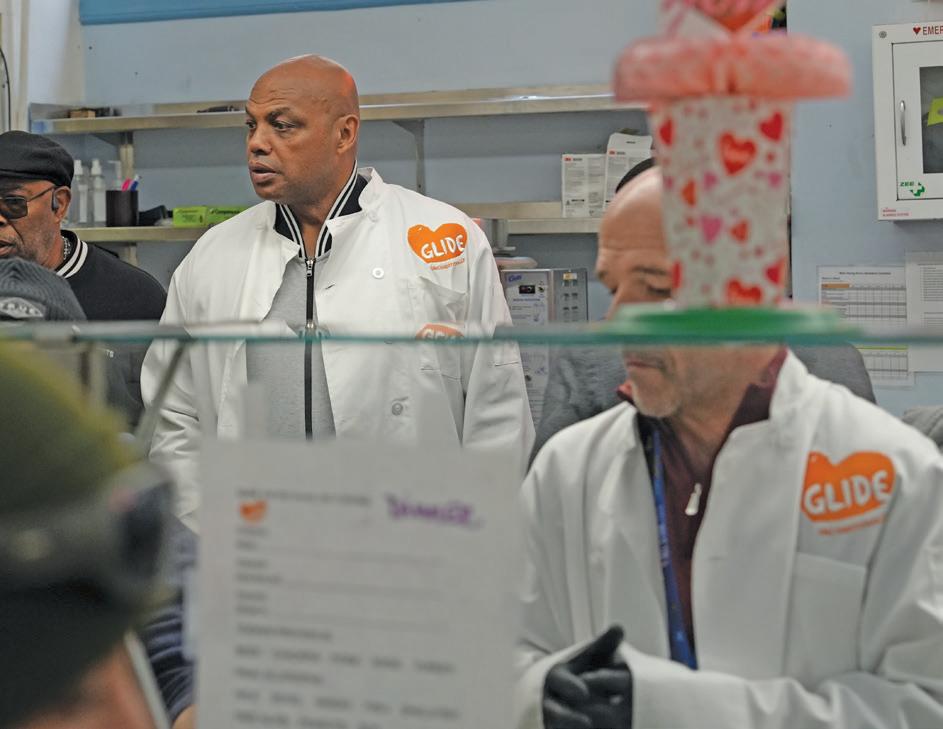
San Francisco Mayor Daniel Lurie and called him “tremendous.” And on Feb. 14, he toured Glide Memorial Church and its adjacent social services center in the Tenderloin district where he served free meals to low-income and homeless people. He also pledged to donate $250,000.
“He came for a couple hours to visit. He toured the whole building,” Lezak told J. “He was really rocked by what he saw.” Lezak, a director with Glide’s Center for Social Justice,
Stacey Wallach
• Helene and Sylvan
Wallenstein
• Ellen and Jeffrey Wang • Irene
Wapnir • Jane and Gary Ware • Kathy Marie
Warnock • Stephanie and Elliott Warshauer •
Martin Wasserman
• Sharon and Steven
Wasserman • Deborah Wechsler • Shoshana
Wechsler • Judy Weil • Miriam Weil • Barbara
Weinberg • Joanna Weinberg and David
Levine • Susan Weiner • Bonnie Weinstein •
Helen Weinstein • Madeline Weinstein • Peter
Weinstein • Richard L. Weinstein • Jerry
Weintraub • Dan Weisberg • Sheila Weisberg • Joanie Weiser • Allison Kent Weiss and Paul
Weiss
• Elaine and Stanley Weiss
• Rabbi Eric
Weiss and Dan Alpert • Janna Lipman Weiss •
Linda and Joseph Weiss • Roz Weiss • Debra
Weiss-Ishai • Joel Weissman • Abraham
Weitzberg • Jane Weitzman • Elissa Weizman
• Paul Werner • Linda Wertheim
• William
West • Betty Anne Wexler
• Judie and Howard
Wexler • Lawrence Wexler • Lewis Wexler • June White • Trudi White and Naomi Jay • Paula White-Reddy • Dorothy and Alfred
Whitman • Susan Whitman • Harold
Wilensky • Lenore and Alex Wilkas • Ruth
Willheim • Edie and Roger Wilson • Julie
Wilton and Harry Shulman
• Deanne and Frank Winer • Maxine Winer
• Mary Anne and Hugh Winig • Judith Winkelstein •
Beverly and Phillip Winslow
• Gary Winter •
Diane and Josh Wirtschafter • Pauline Witriol
• Larry Wolf
• Leslie Wolf
• Lonna and Bernard
Wolf
• Carol Wolfe* • Jerry Wolfe • Nancy S.
Wolfe • Ann and Neil Wolff Esther and Lawrence Wolheim • Jessica Sarah Wolin • Beth Wolinsky • Robin Wood • Ken Woodrow
• Fern Yaffa
• Joyce C. Yaffe
• Vladimir
Yagolnitser
• Paul Yamshon
• Katie Yanow •
Naim Yashar • Linda and Marc Yelnick •
said that Barkley was curious about the Jewish community’s involvement in Glide, a nondenominational church led for 60 years by the late Rev. Cecil Williams. Barkley sought out Lezak, made a crack about the Jewish calendar and told the rabbi that his daughter married a Jewish man.
“He looked at me and said, ‘Rabbi, you guys have a lot of holidays!’” Lezak said.
Barkley’s daughter Christina married Jewish entrepreneur Ilya Hoffman in 2021. At the celebration, the 6-foot-5, 250-pound former basketball star was joyfully lifted on a chair during the hora, notwithstanding some reservations he shared about the maneuver.
Barkley has also earned appreciation from the Jewish community for condemning antisemitism coming from Black celebrities. “I don’t understand how you beat hatred with more hatred,” Barkley said in 2020. He again condemned antisemitism in 2022 from NBA All-Star Kyrie Irving.
Lezak said he was impressed by the visit.
“He was here for the big show,” Lezak said, speaking of All-Star weekend. “But he also had a menschy, sweet heart that wanted to understand the pain of the city.”
The rabbi, who helps bake 100 challahs every Friday for kitchen staff (to “feed people who feed people,” he said), offered Barkley two challahs at the end of the visit and wished him a “Shabbat shalom.”
“He’s got my heart now,” he said. “I’m on team Barkley.” n
Yiddish Tango • Jerald Young •Jaysa Zablatsky
• Joline Zalkind
• Fima Zaltsman
• Susan and Bill Zarchy
• Gregory Zarkhin • M. Zarrow • David Zebker
• Helane and Ronald Zeiger • Judith Zeitlin
• Jessica and Leon Zektser • Mark Zelinsky
• Sam Zelver
• Fred Zemke • Al Zemsky • Bess Zimmerman • Janet Zimmerman • Marilyn and David Zimmerman • Marsha Zipkin • Shawn Zovod
• Rebecca Zucker • Arlene Zuckerberg and Alan Gellman • Ami Zusman • Susan Zweig • Lesley Zwillinger • Arta Zygielbaum • Judith Zyroff •
*Donor-advised fund of the Jewish Community Federation and Endowment Fund
We also thank all of our donors at all levels who prefer to remain anonymous.
California
On behalf of the J. board and staff, we thank all of our 2024 donors for your generous support. This list represents more than 2,800 households (plus 200 anonymous donors) who believe in the power of local Jewish journalism.
Because of you, J.’s mission to connect and inform our Jewish community remains strong, grounded in tradition and committed to making the Bay Area a better place. Thank you!
If your name does not appear and you made a contribution last year, or you are listed incorrectly, please contact J. development director Allison Green at 415-796-0227 or email Allison@jweekly.com
LEA LOEB | J. STAFF
A new billboard in Arcata, featuring a boldly Zionist message, was ripped down under the cover of darkness a er just four days.
e billboard, positioned along Highway 101 near Cal Poly Humboldt, said: “Call Me A Zionist. It Only Makes Me Prouder.” It featured U.S. and Israeli flags and a dark-haired young woman gazing into the distance, wearing a Star of David necklace.
An unknown individual or group tore down the billboard late Feb. 7 or early Feb. 8, leaving behind a blank wooden background and ta ered remnants of the sign.
Code Blue and White, a new pro-Israel group founded by David Porush of San Mateo, commissioned the roadside ad. Israeli-born Arcata resident Tamar Krigel helped design it.
e billboard sparked controversy on social media on Feb. 4, the day it went up, with some commenters calling for its removal — by force, if necessary. At least six threads with hundreds of comments were posted on the Humboldt forum on Reddit, ranging from debates over free speech to calls for torching the billboard with “kerosene and waterproof matches” because “fire cleanses all.”
“If promoting Zionism falls under free speech then so does vandalism,” wrote one anonymous commenter.
“Mr. Molotov would be happy to help,” wrote another.
One Jewish commenter said the talk of violence was worrisome.
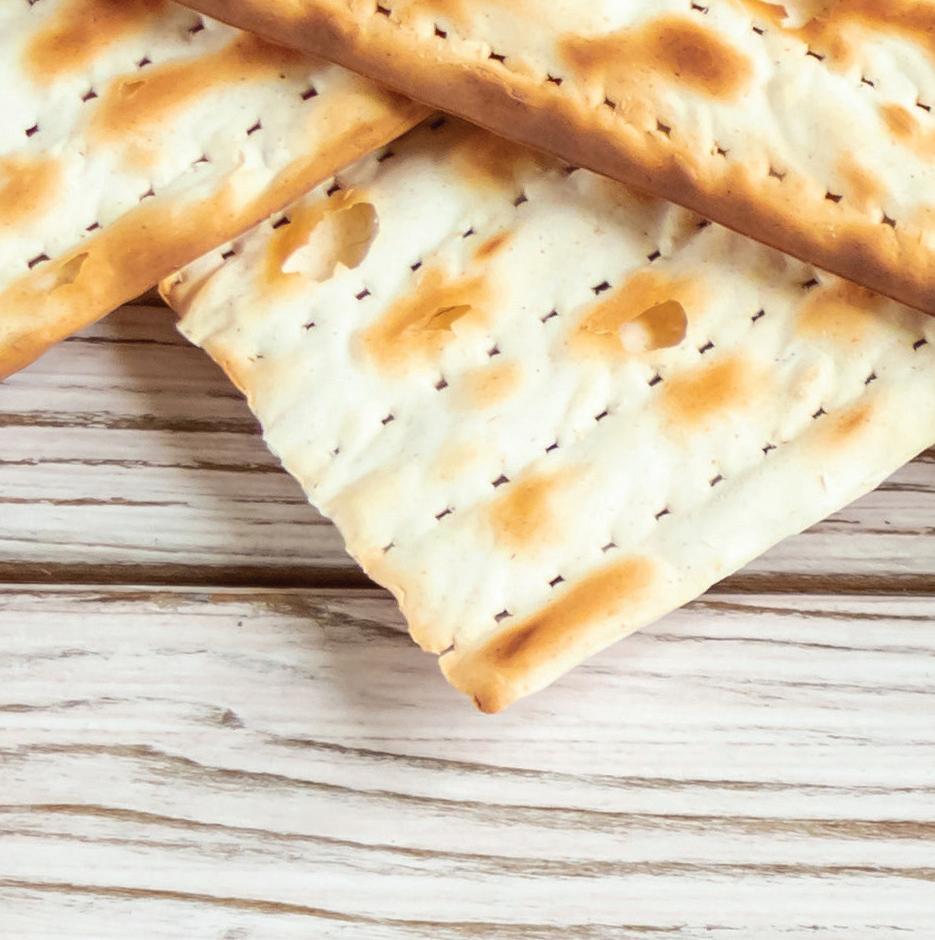
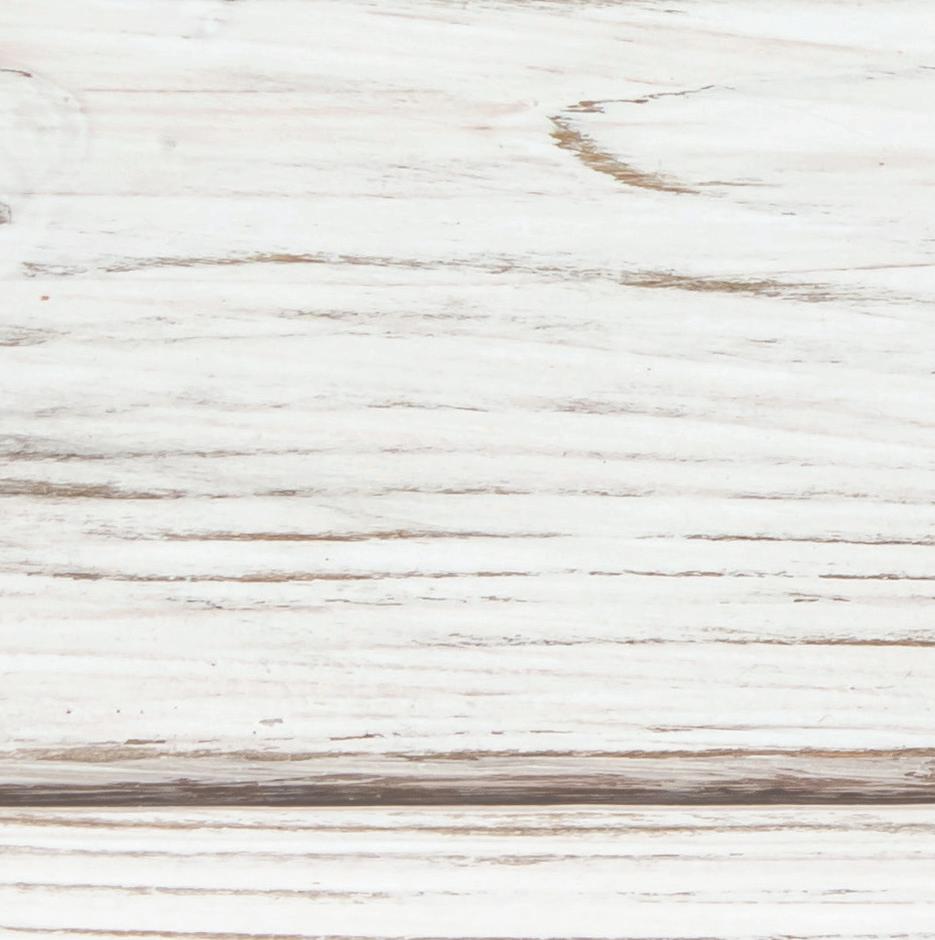
“As a Jew living in Humboldt county, no a liation or opinion to Israel, should I be concerned about being targeted by crazies?” the person asked, garnering dozens of responses — almost all of them a resounding “yes.”
A Change.org petition calling on the advertising company that owns the billboard to take down the pro-Israel message had garnered 107 signatures as of Feb. 18. e petition said the billboard carried “genocidal messaging” that “does not reflect the values of this community.”
Porush and Krigel defended the billboard.
In an email to J., Porush said the goal was “to take back the word ‘Zionism,’” which he feels has been co-opted and distorted. Krigel agreed.
“ e word Zionism has been twisted in so many ways,” she said in an emailed statement. “Anyone can look up the meaning of the word, yet many have tried to distort it into a colonial or imperialist evil, falsely assuming it to be rooted in racism or even genocide.”
Krigel o ered her definition of the word, elaborating on the current war.
“To be a Zionist is to believe in Israel as a democratic, moral society — one that strives for peace even in the face of relentless threats. e horror of what has happened in Gaza is not a Zionist ideal; Zionism does not mean supporting every action of the Israeli government, nor does it mean ignoring Palestinian su ering. It is possible to want Israel to survive

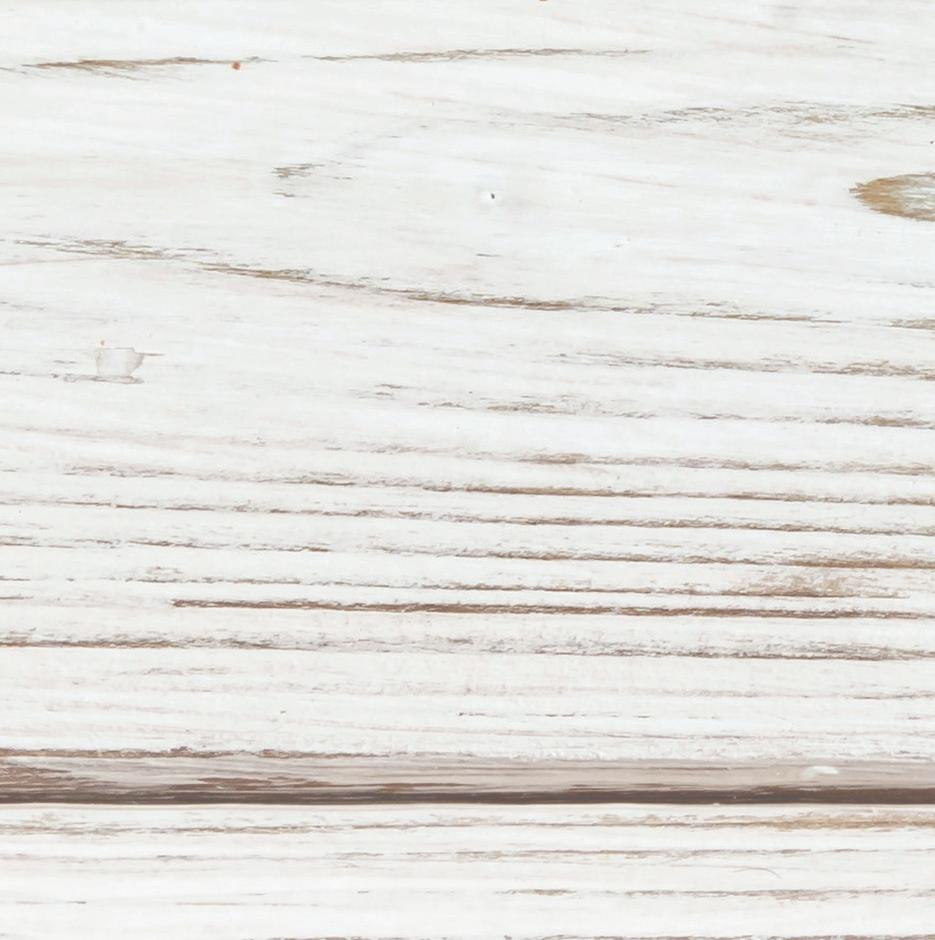
and thrive while also demanding that its actions reflect the highest moral standards,” she said.
“Being a proud Zionist and feeling horrified by what has happened in Gaza are not contradictions — they stem from the same core values of human dignity, justice, and the sanctity of life,” Krigel continued. “Zionism is not about blind nationalism; It is possible — and necessary — to hold this belief while also feeling deep sorrow for the su ering of innocent Palestinians in Gaza.”
Porush said Code Blue and White plans to replace the billboard. e incident, in his view, amounted to a hate crime.
“ e equation between Zionism and Jews and the Jewish state is pre y clear, and the distortion of Jewish history — there was one comment on Reddit which said, you know, ‘all Zionists should be killed,’ and threats to throw Molotov cocktails at the billboard. Certainly, the energy is hateful whether or not it falls under the legal definition.”
A second billboard from Code Blue and White went up on Feb. 10 along Highway 101 in Redwood City. It displays the message: “America and Israel: Fighting Terrorism Together.” e billboard shows images of an Israeli female soldier and an American male soldier, both in uniform.
Porush said he reported the Arcata incident to the Humboldt County Sheri ’s O ce, the FBI and the U.S. Department of Justice. e case has been transferred from the sheri 's o ce to the Arcata Police Department. ■

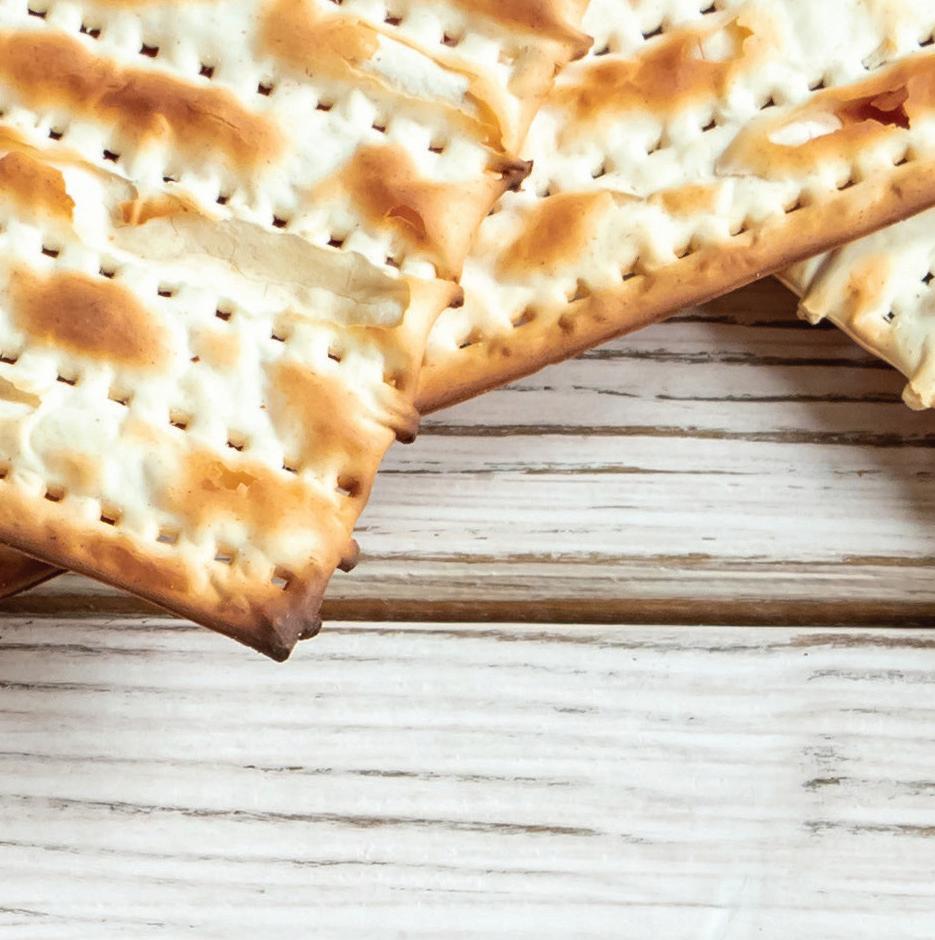
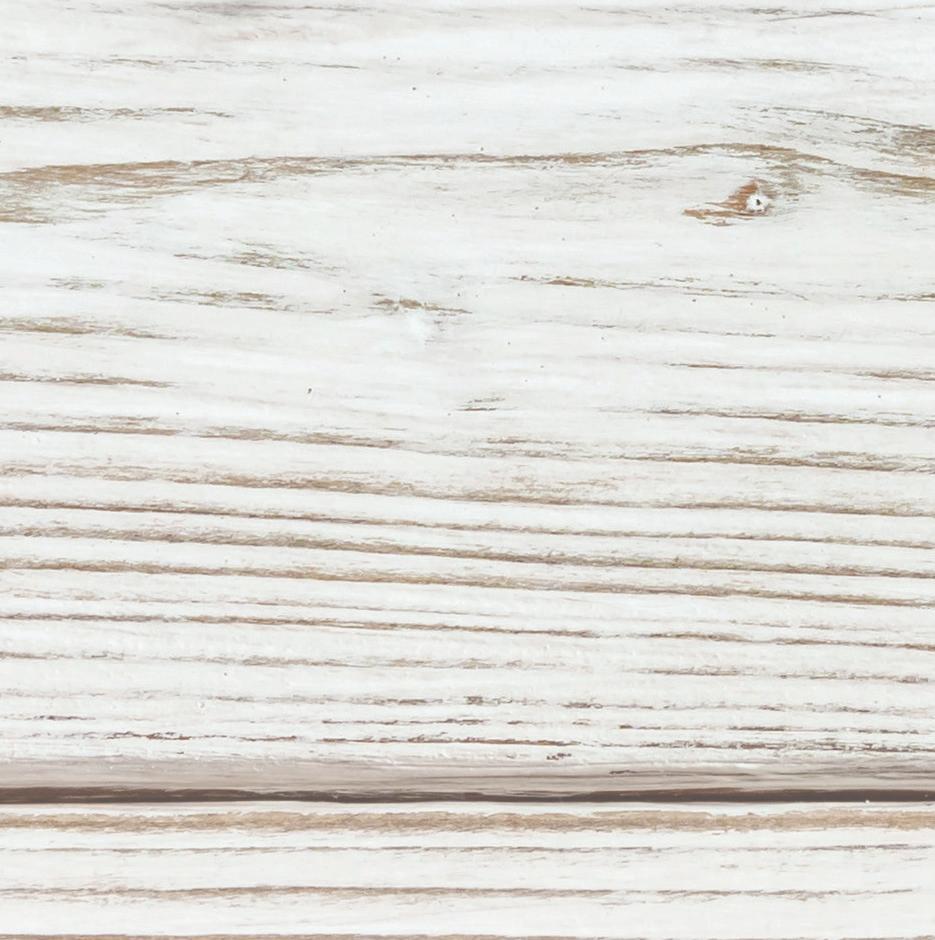

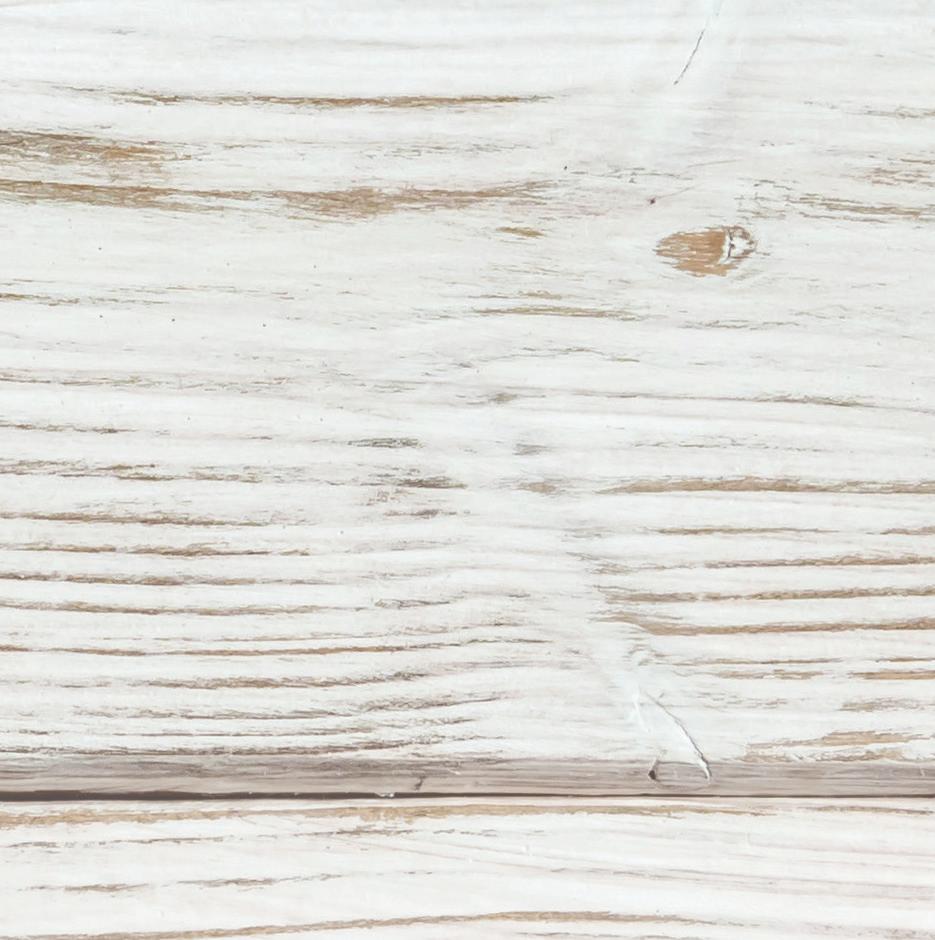

Elsa Cedeño was 15 when she first heard an Amy Winehouse song.
The song was “Stronger Than Me,” a jazzy ballad from Winehouse’s 2003 debut album, in which she laments her boyfriend’s substance abuse and his failure as a man “to live up to his role.”
The singer and her fan had completely different
upbringings — Winehouse, a Jewish girl born in London, and Cedeño, a Mexican American girl born in Chicago — but Cedeño related to Winehouse’s song as soon as she heard it. Her own father had been deported to Mexico several years earlier and had become addicted to methamphetamines.
“My dad was a gnarly drug addict, so I always kind of felt like that song fit with my life,” recalled Cedeño. “That was
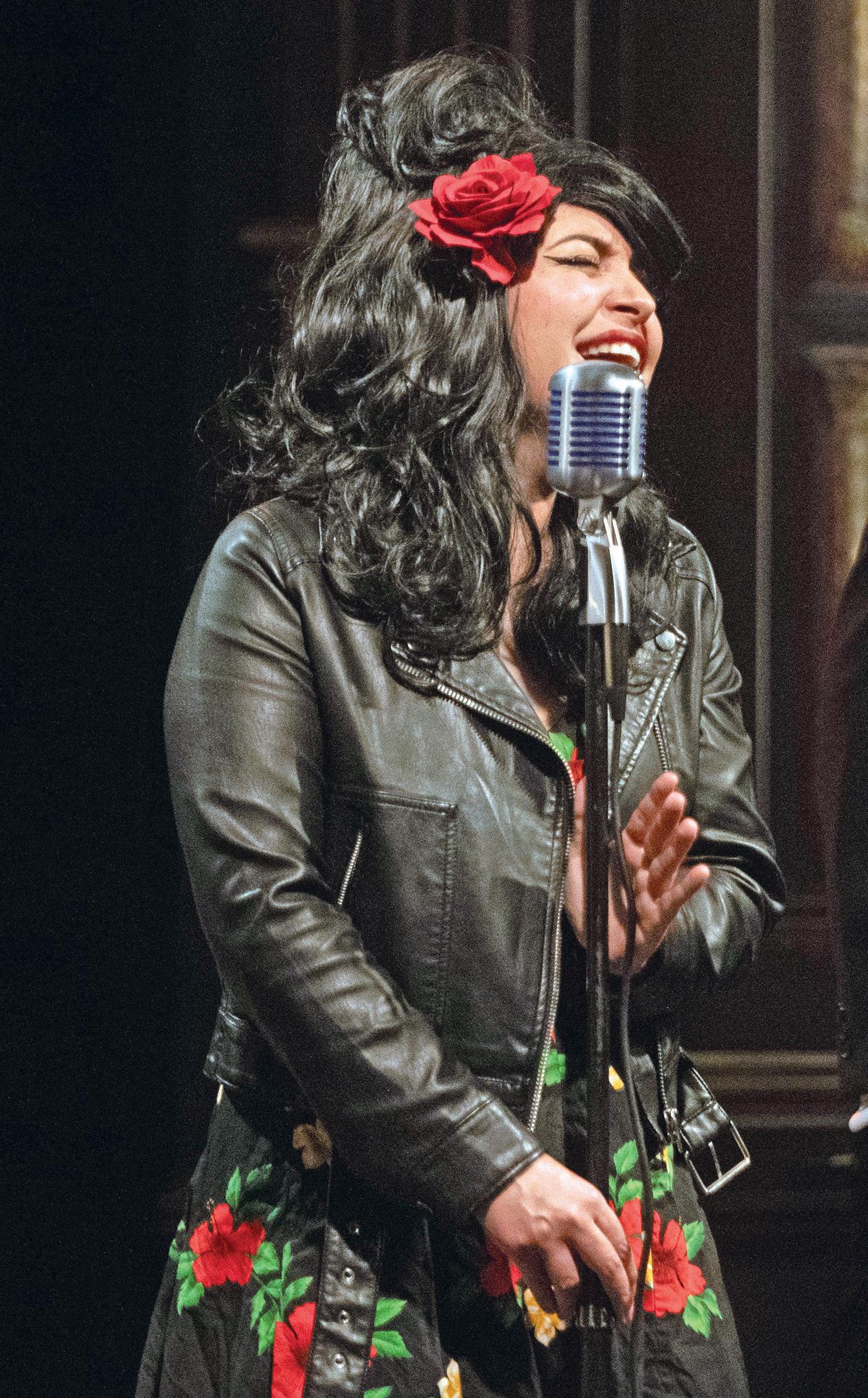
“Because she died young, a lot of people never got to see her perform.”
Kevin Summer, tribute band manager
“Because she died young, a lot of people never got to see her perform,” Summer said. “We focus on re-creating an authentic and passionate experience where people can feel close to her.”
For performances, Cedeño dons Winehouse’s signature retro beehive hairstyle and winged eyeliner, but Cedeño’s expressive vocals anchor the re-creation. She originally answered Summer’s Craigslist ad for a backup singer because he had already chosen a lead. But after her audition, Summer knew she was the right person for Winehouse’s role, despite Cedeño’s lack of formal training or stage experience.
For Cedeño, feeling connected to Winehouse goes beyond the music. When Cedeño’s father was deported, she was 12 years old and her whole family was forced to relocate to the slums of Tijuana to avoid being split up.

the thing that started it for me, that song and her life story.”
Now 33, Cedeño didn’t know at the time that she, too, would one day struggle with addiction and depression, like Winehouse. She also never would have guessed that one day she would make a living impersonating the Jewish songstress, who died in 2011 at age 27.
Cedeño is the lead singer in the Amy Winehouse tribute band Valerie, which has played sold-out shows throughout the state since its first performance in August. The eight-piece band, based in Santa Cruz, was created by manager Kevin Summer, a lifelong Winehouse fan who wanted to bring the singer’s legacy to new audiences. He named the band for one of Winehouse’s best-known songs.
“We didn’t have money. We didn’t have anything, not even school,” she said. “So I started singing. I’d go downtown and I’d put out a little hat and I’d get money and bring it home to my siblings for food.”
About a decade later, in 2013, Cedeño moved to the Bay Area so her 6-month-old daughter could receive treatment at UCSF for bilateral retinoblastoma, a rare type of cancer that affects both eyes.
Cedeño said the stress from her daughter’s cancer diagnosis and subsequent treatments, plus a toxic relationship, caused her to become severely depressed and turn to alcohol.
“Alcohol was my best friend,” she recalled. “I feel like alcohol saved me so many times from killing myself. I didn’t want to live, and alcohol was right there, like, ‘Hey, just drink me and you’ll feel OK.’ But eventually it was killing me.”
Tragically, it did kill Winehouse, who died of alcohol poisoning.
In her short career, Winehouse earned numerous
accolades, including six Grammy Awards. Her music and life story have continued to generate interest in the years since her death, with books, documentaries and museum exhibits, including one at San Francisco’s Contemporary Jewish Museum. She was also the subject of a 2024 biopic.
While critics praised her raw talent and lyricism, Winehouse was lambasted for her openness about her issues with mental health, addiction and long-term bulimia. Her authenticity made her relatable to fans but also loomed over her musical achievements. ose close to her have said in interviews that fame exacerbated Winehouse’s struggles with mental health and addiction. Others have argued that family members, especially her father, Mitch Winehouse, and her husband, Blake Fielder-Civil, enabled her heroin, crack cocaine and alcohol use and exploited her talents.
“Her addiction took her. She didn’t win that ba le, but she le a mark on a lot of people who have su ered the same story as her with family issues, romances and addiction,” Cedeño said. “ ankfully, I was able to get out. But she didn’t.”
Cedeño celebrated one year of sobriety on Dec. 7, 2024. Her daughter, though losing her right eye to cancer, remains in remission. During Valerie concerts, Cedeño always acknowledges Winehouse’s struggles with addiction and shares her experience with recovery. She said that many a endees come up to her a er the shows to discuss their own struggles and to o er words of strength and encouragement. She hopes that by spreading awareness through her performances, she can reach those who need support.
“I think it’s important that we put it out there — what addiction is and how you can recover,” Cedeño said. “I think it’s important for people to see that.” ■



“Thankfully, I was able to get out. But she didn’t.”
Elsa Cedeño, Valerie’s lead singer
Valerie tribute band Performances March 22 at Nile Theater, Bakersfield; March 29 at Spanos Theater, Cal Poly San Luis Obispo; April 5 at the California, Santa Rosa; April 19 at Golden State Theatre, Monterey; May 10 at Rio Theater, Santa Cruz; July 12 at Freight and Salvage, Berkeley; Sept. 6 at Flamingo Resort and Hotel, Santa Rosa. All shows start at 8 p.m. Tickets range from $35 to $70. valerieamyband.com
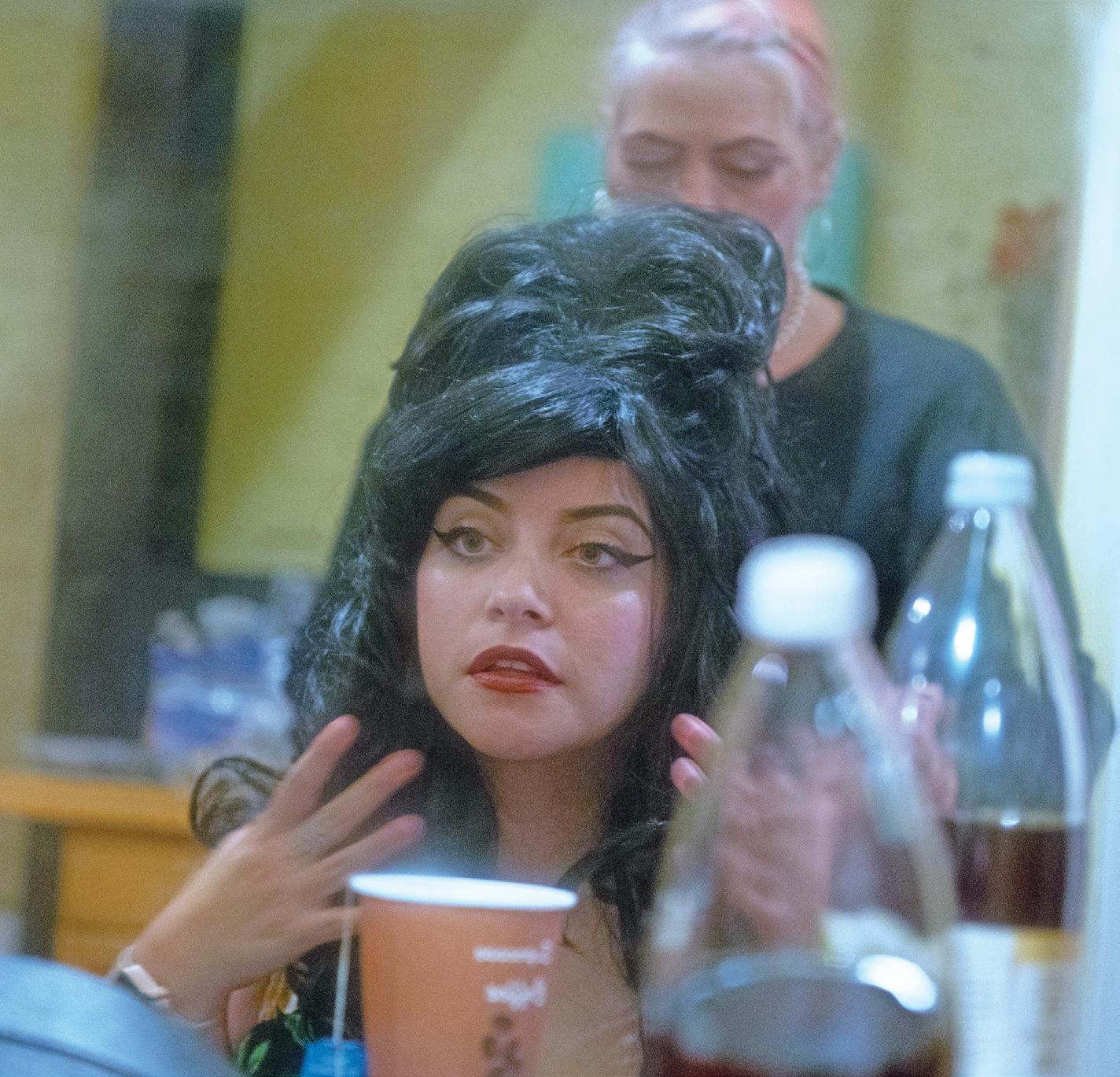




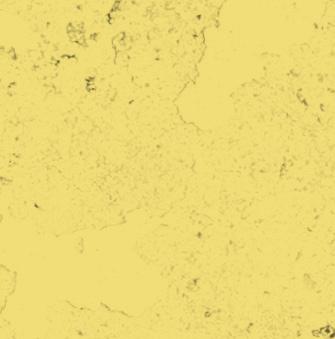














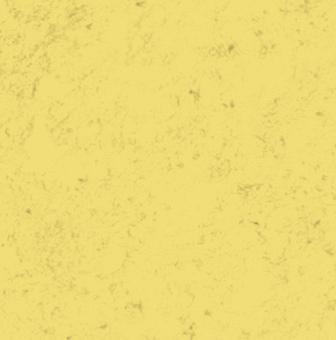






Fifteen
Compelling chronicles of love and loss, piety and heresy, mysticism and rationality, and stirring stories of exile, dislocation, and profound change.

unforgettable stories that reveal the singular endurance of Jewish memory.
“Luminous tales of exile and loss that bequeath new life… grounded in realism made poetic, but they also have an aching sense of evanescent mystery…an engrossing fictional world with real literary depth.”

—Kirkus Reviews (starred review)
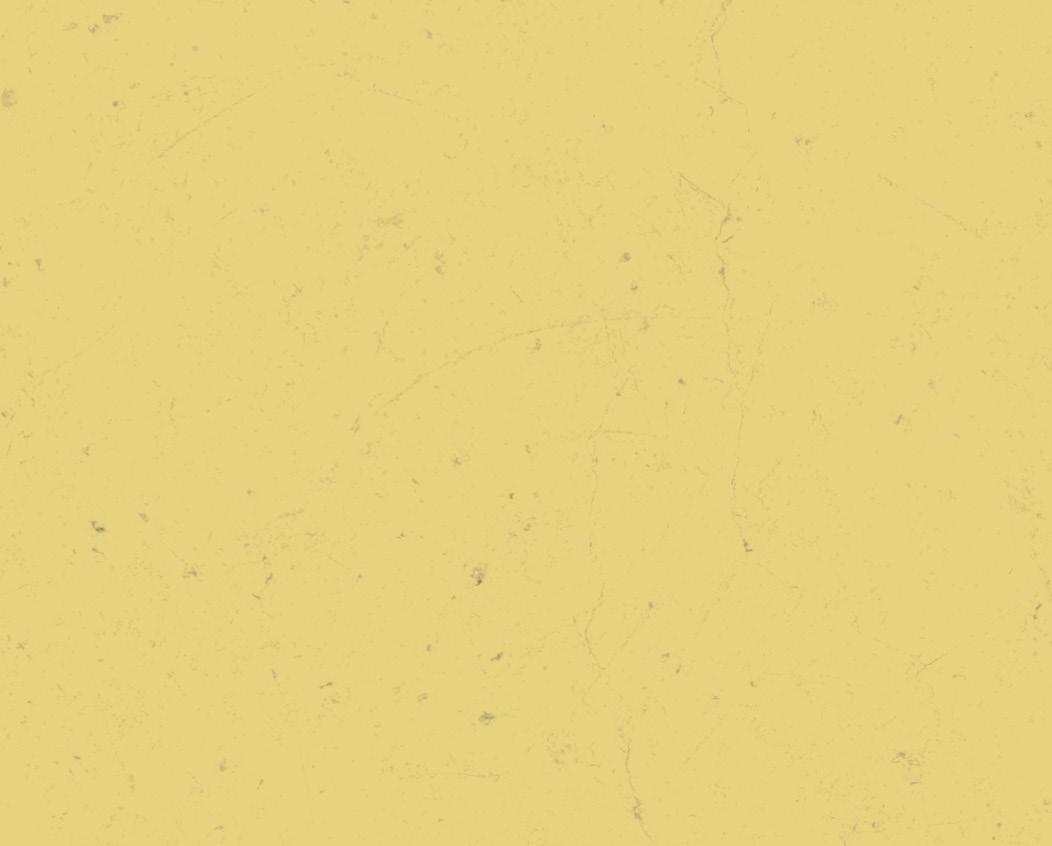
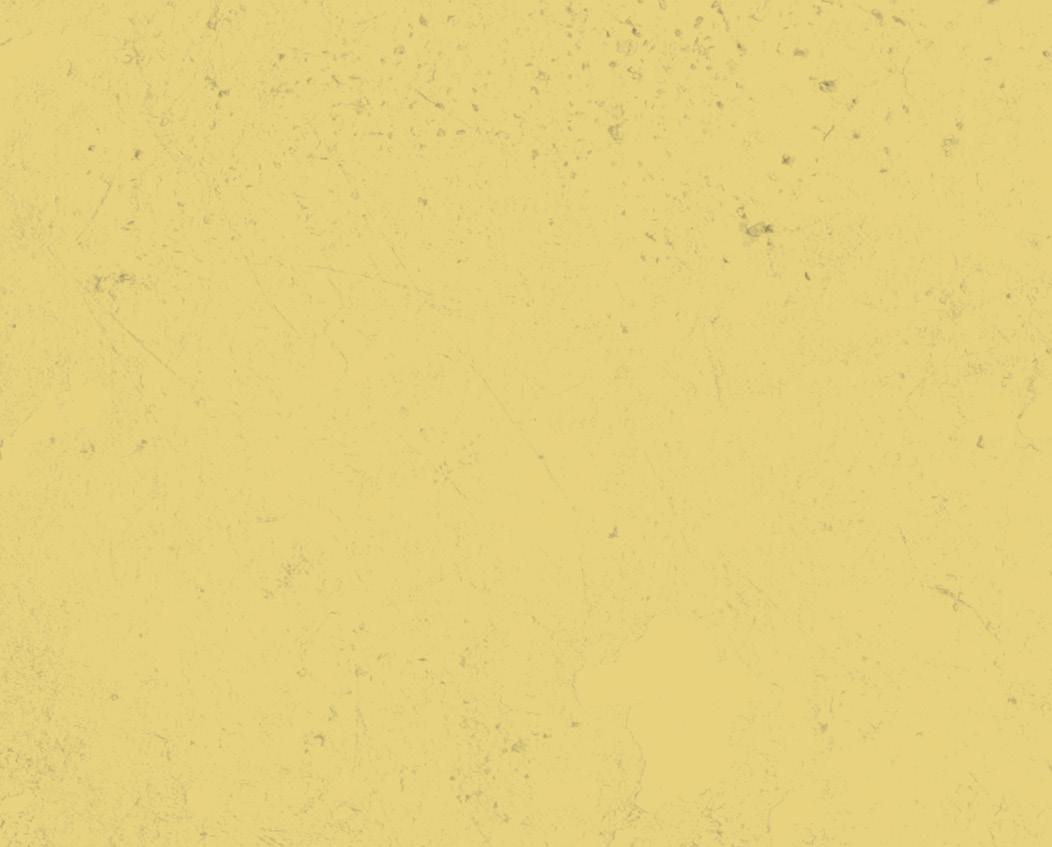
Available now wherever books are sold.

ART | MAYA MIRSKY | J. STAFF
What does it mean to visit a building that no longer exists?
To honor the memory of his relatives killed in the Holocaust, and the places where they once lived, San Francisco visual artist Ben Wood decided he would bring back those memories through art.
Through dreamlike yet highly detailed animation videos of his grandparents’ homes in Germany — buildings that were destroyed after his family members were forced to leave — Wood has re-created a vision of the past.
The two homes once had real walls and real doors, and real people lived there. Today, they exist only in his imagination and in his three-dimensional animations.
“I re-created these actually based on drawings, real drawings, that I found in an archive,” Wood said. “But they’re somewhere between history and a dream, or history or memory and a dream.”
Wood made the two videos in 2024 by poring over maps and photographs, then using software to create animated videos that loop through an exterior tour. The six-minute videos are accompanied by Wood’s voiceovers in German (with subtitles in English) that describe the properties and the people who lived there. The animations are realistic, except that the windows have been replaced with photographs of the one-time inhabitants.
“I’m telling their story,” said Wood, who has a master’s degree in visual studies from MIT and specializes in public art. “My idea was to bring back their faces and, in some ways, their voices.”
The first video, titled “Grosse Strasse 73, Strausberg,” brings to life the shop and home owned by Albert Levy, a
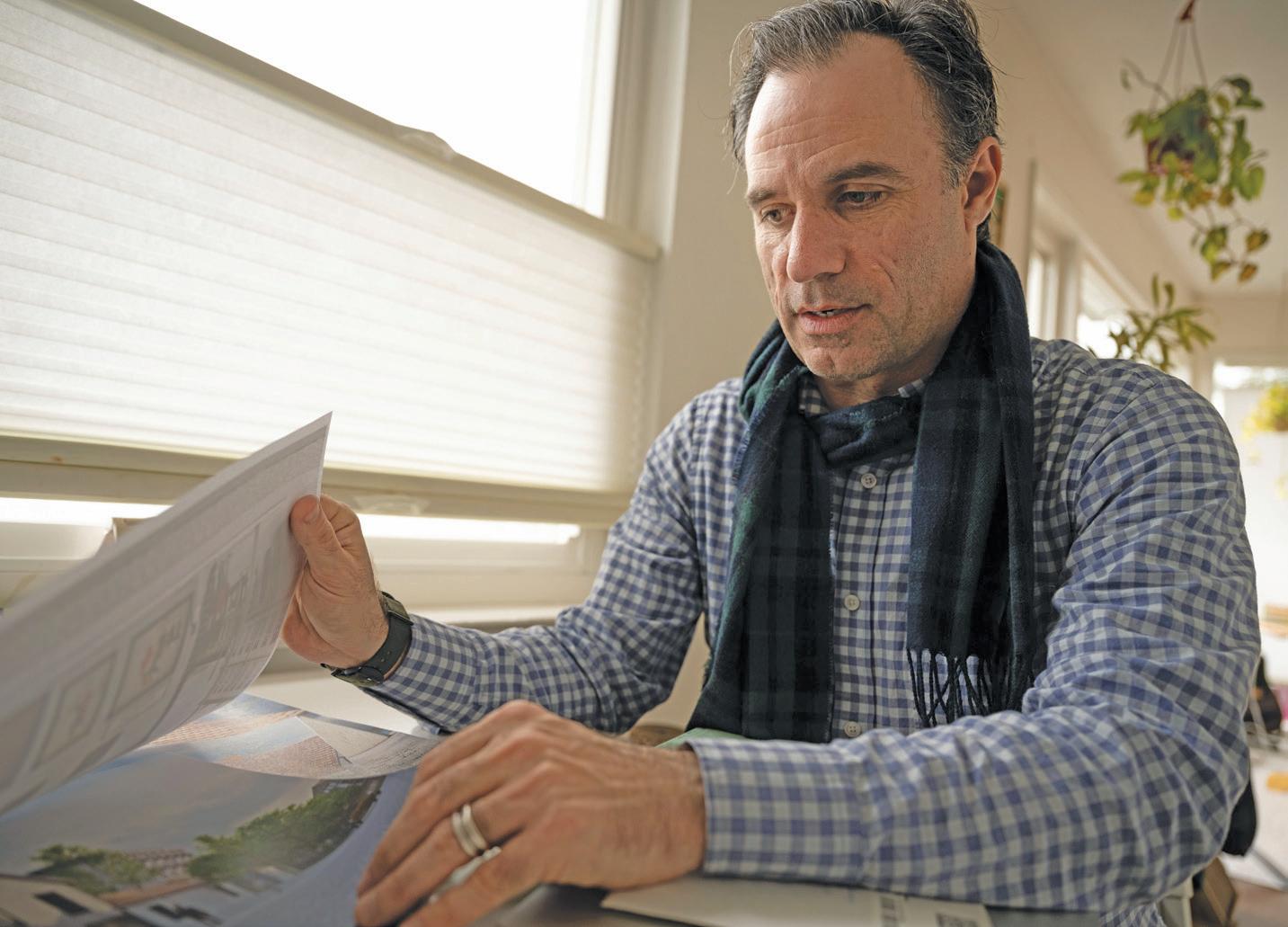
Ruth was Wood’s maternal grandmother.
Wood’s second video is titled “Berliner Strasse 46, Seelow,” a Berlin suburb. It was the home — now razed — of Max and Adelheid Philippsborn, Wood’s great-grandparents. Adelheid’s given surname was Reissner; the property was the Reissner home and workshop, where they traded in furs and hides.
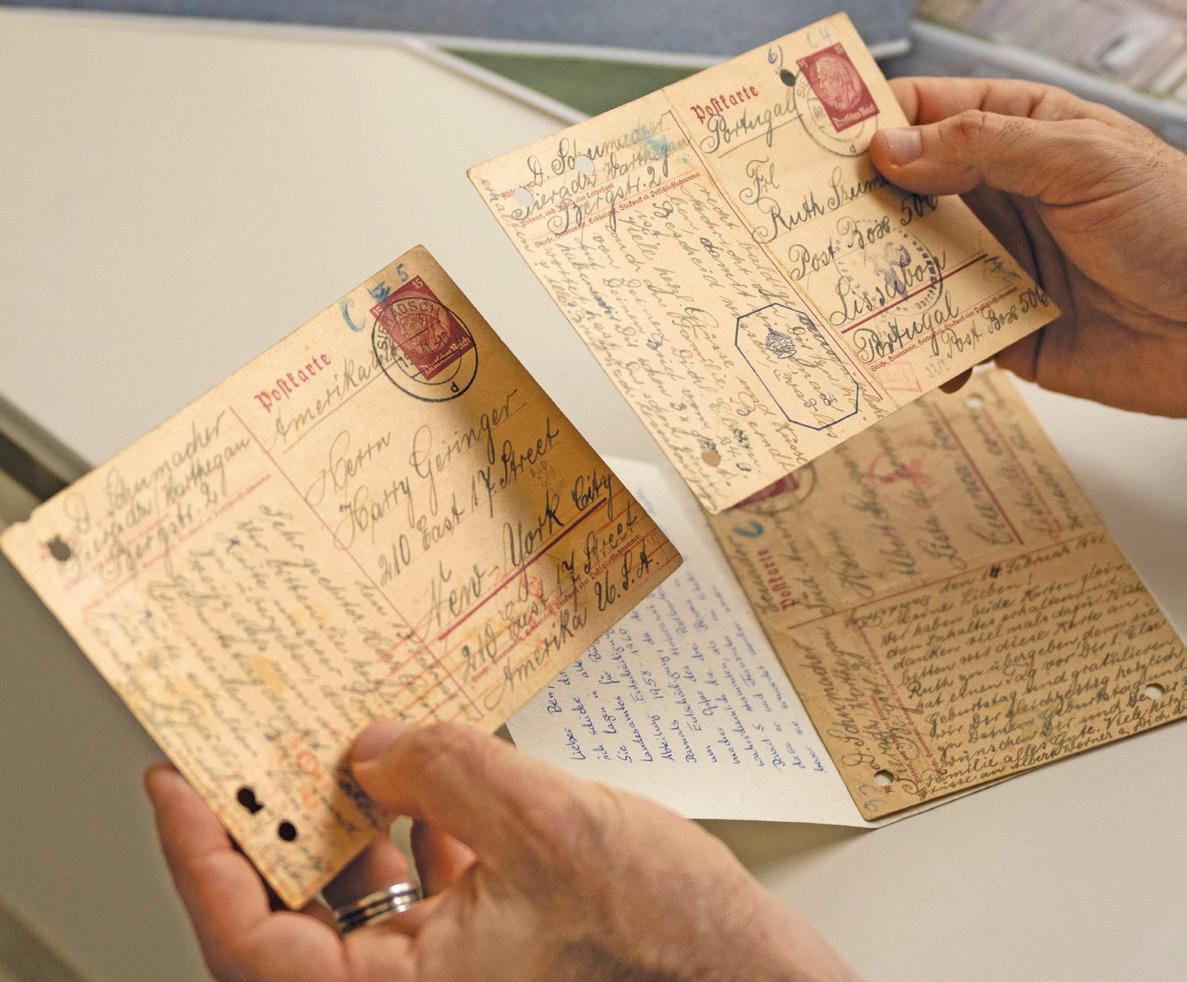
clothing and textile seller, and his wife, Helene Levy. In 1939, the property was commandeered by a local Nazi agent who forced the Levys to sell it for a nominal sum. Then the site was demolished. The couple moved to the Jüdisches Altersheim, the Jewish Home for the Aged, in Berlin. Helene died in 1940 in a sanatorium. Albert, then 82, was sent to Theresienstadt then to Treblinka, where he was killed. Their couple’s adult daughter Friederike and her husband were also killed, but Friederike’s stepdaughter, Ruth, was saved by the Kindertransport mission that brought her to England.
his brothers is an Orthodox rabbi, and the other brother runs a Jewish deli.
He is known for his site-specific work, projecting photos onto San Francisco’s Congregation Emanu-El and onto city landmarks and historic sites such as Coit Tower, the Cliff House and Fort Point. In a 2017 exhibit at the Haas-Lilienthal House in San Francisco, he filled the windows with projected photos of the Jewish family — similar to how he has used photos of his own family members in the windows of the animated houses.
The videos about his heritage are part of a bigger project tied to the past. Last year, he and other family members participated in the installation of Solpersteine, or “stumbling blocks,” the bronze memorials set into the sidewalks in front of homes of Shoah victims — now including his family’s homes.
Nils Weigt, a Ph.D. student in Germany, studies Holocaust history and is a member of an antifascist organization (“Vereinigung der Verfolgten des Naziregimes – Bund der Antifaschistinnen und Antifaschisten”) that helped organize and pay for the Solpersteine in Strausberg, Wood said.

Weigt, a resident of Strausberg, describes Wood’s videos as “immersive.”
“The viewer goes on a journey back in time to a past that doesn’t want to go away,” Weigt said in an email to J. “We still live in a post-Shoah society here in Germany. I would describe what we see with the word ‘haunting.’”
“If you can’t reclaim property, you can at least tell the story.”
Ben Wood
Under the Nazi regime, Max was sent to the Sachsenhausen concentration camp and later released, but then died from an unknown “accident” at the hands of the Nazis in 1940, according to documents. Adelheid was sent to the Warsaw Ghetto and did not survive. However, the couple’s son did make it out: Heinz and two cousins fled to England.
Heinz was Wood’s maternal grandfather.
Wood, 44, was born and raised in England, the country where his maternal grandparents found refuge, and has lived in the Bay Area since he was 19. Wood is also a triplet; one of
Wood said his family has looked into reclaiming the properties but doesn’t expect to pursue that effort. Instead, he said, he has been inspired by what Native American artists have done in the U.S., which he describes as “cultural repair” or “cultural restitution.”
“If you can’t legally reclaim property, then you can culturally try to reclaim it, at least by telling the story,” he said.
Wood’s videos are not the only virtual renderings of Holocaust-related locations. The Holocaust Museum LA features a virtual replica of the Sobibor concentration camp for teachers to use in class. In addition, museums have used hologram testimony recorded from real interviews as survivors continue to pass away.
“I found a creative solution, which is to somehow tell the story through a different medium, bring back the memory through art, which is very empowering also for me as an artist,” he said. “That’s what I do.” n
THEATER | EMMA GOSS | J. STAFF
When it comes to dating, it can take years to find “the one.”
It also took quite awhile for Itamar Moses and Gaby Alter to get their musical comedy about love, dating and reality TV just right.
Moses, a Tony Award-winning playwright, and Alter, a composer with a forte for rock musicals, have been rewriting and reimagining the script off and on since 2007. Now they finally feel it’s ready for Broadway. But first, “Nobody Loves You” is coming to the American Conservatory Theater’s Toni Rembe Theater in San Francisco from Feb. 28 to March 30.
The two Berkeley-born men, who now live in Brooklyn, began their labor of love nearly two decades ago. Their friendship goes back even further.
Moses, 47, and Alter, 51, are both the sons of UC Berkeley professors who themselves are longtime friends — Israeli-born film scholar Gavriel Moses and Biblical scholar and author Robert Alter.
The Moses and Alter families, both members of Congregation Netivot Shalom in Berkeley, spent many Thanksgiving dinners and Passover seders together.
“The Thanksgiving tradition was charades,” Itamar Moses recalled to J. “The Passover tradition was every person at the seder was assigned some topic within the Haggadah to elaborate upon for the group at some point
during the evening.”
Moses and Alter attended Tehiyah Day School in El Cerrito and Black Pine Circle for part of their middle-school years. They are also both graduates of Berkeley High School, though their four-year age difference meant they weren’t there at the same time. They also both earned MFAs from New York University’s Tisch School of the Arts, Moses in dramatic writing and Alter in musical theater.
“There was this moment where we were hanging out in Brooklyn because we were friends, and it was like, ‘Well, I write plays. You write musicals. I guess we should write a musical together,’” Moses told J. “It was almost like it would be silly not to. And it started in Gaby’s room, with him at the keyboard and me with a yellow legal pad.”
Between 2007 and 2010, the two co-wrote the first of several iterations of “Nobody Loves You,” comically satirizing the reality show genre of dating competitions and probing the concept of authenticity and romantic connection in the scripted, hyper performative version of reality that such shows are famous for.
Their musical is about a wildly popular and fictional TV show called “Nobody Loves You.” The main male protagonist, Jeff, is a philosophy grad student who snags a spot continued on page 28

Discover why so many families trust us to provide a supportive, engaging environment for older adults. Our memory care and assisted living community combines modern comfort with expert, compassionate care—providing safety, connection, and peace of mind for residents and their families.

Made Simple Wednesday, March 19 • 2:00 pm – 3:00 pm
March 23 • 10:00 am – 2:30 pm


continued from page 27
on the show in an effort to win back his ex-girlfriend. But he ends up falling for Jenny, a show producer, who dreams of making serious films.
“Nobody Loves You” made its onstage debut at the Globe Theater in San Diego in 2012 and had an off-Broadway run at Second Stage in New York City in 2013. When that production came to a close, both Moses and Alter felt the material needed improvements and a rewrite. In 2017, a small theater in
want to say,” Moses said.
One of Alter’s favorite musical numbers from the show is “You’re So Real,” a song that a producer sings to Jeff to convince him to stay on the reality dating show.
“She’s like, people are going to love how authentic you are!” Alter said. “And it’s a disco number.”
Reviving the musical in San Francisco is particularly meaningful to both men, who are excited to bring family members and friends from New York and Berkeley to the premiere.
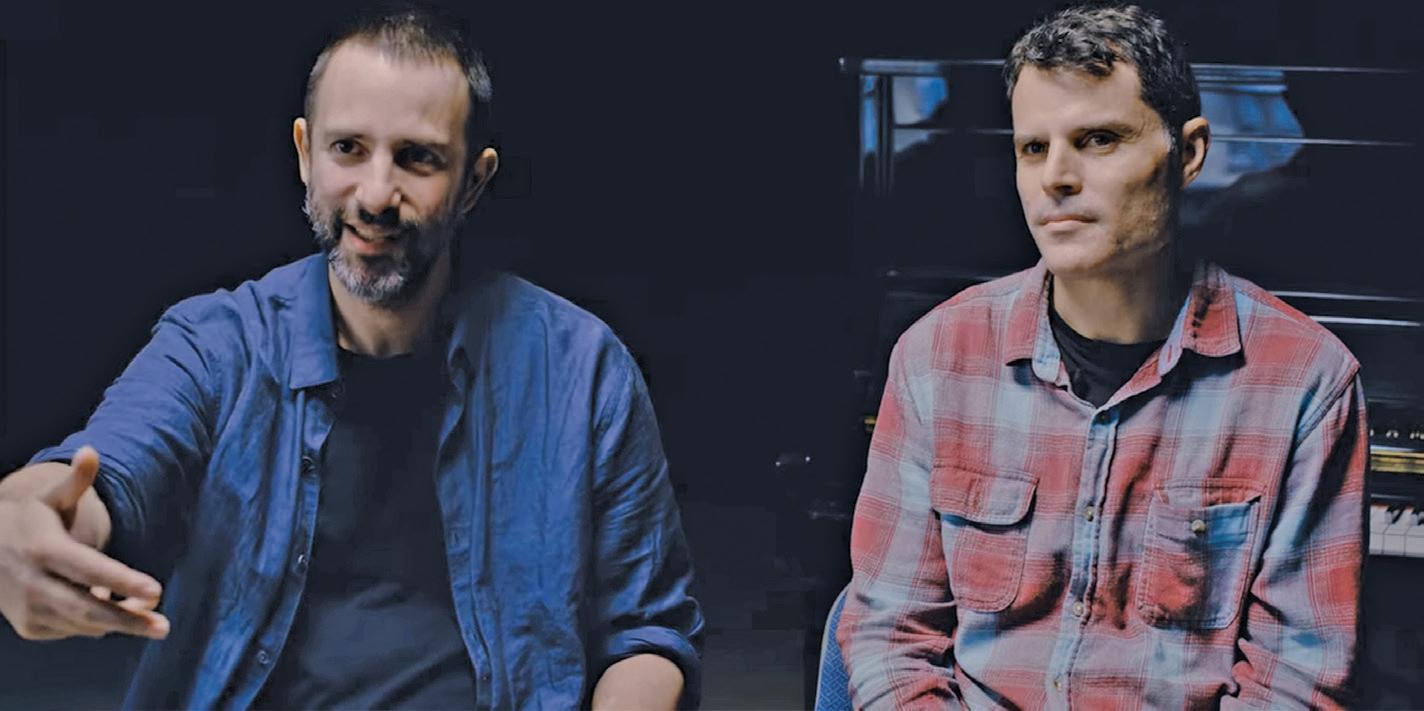
Atlanta called the Horizon allowed them to do just that, asking Moses and Alter to resurrect the musical.
“That was a crucial turning point,” said Moses, who won a 2018 Tony Award for best book of a musical for the adaptation of the Israeli film “The Band’s Visit.” “We got our hands dirty again, working on the show and starting to make some changes and feeling like there really was the possibility of making it feel finished to us.”
Once they had significantly altered the beginning and end of the show and felt it was ready for new audiences, the Covid-19 pandemic closed theaters.
Now the musical — featuring more new material, some of it written in the last six months — is coming back to the stage. This time it’s for a pre-Broadway tryout.
“It definitely feels like a new production,” Moses said. While the show is full of laughs, Moses and Alter told J. that there are several jokes specifically Jewish in nature (but no spoilers).
In the years since they began work on “Nobody Loves You,” dating competition shows have exploded in popularity. And newer ones, like “Love Is Blind” on Netflix, get binge watched by millions across the world.
“In retrospect, I think the changes that the show needed only became clear to us after time went by, both because of how we changed as writers and because of how the world now interacts differently with what we

Moses (left) and Alter as kids. (COURTESY)
“ACT was the place where I saw some of the formative productions that made me want to be a playwright,” Moses said of the San Francisco debut. “So to get to work there and at the Toni Rembe, what was back then in my day called the Geary, is really exciting.”
Added Alter: “l was doing rock musicals for 10 years in places that my friends and I rented. So doing something at ACT is mind-blowing. And then on top of that, we get to invite all our friends and family. This is really exciting and fun.” n
“Nobody Loves You” Feb. 28-March 30. ACT’s Toni Rembe Theater, 415 Geary St., S.F. $55 and up. act-sf.org
Books
coverage is supported by a generous grant from The Milton and Sophie Meyer Fund
OFF THE SHELF HOWARD FREEDMAN
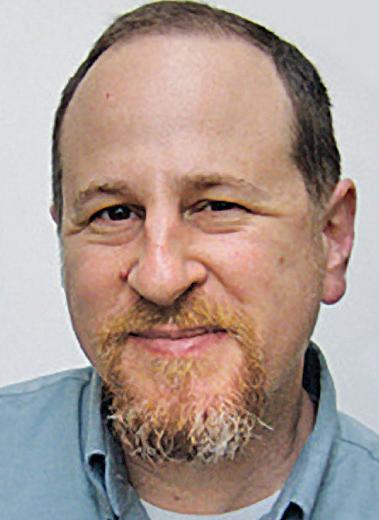
is year’s National Jewish Book Award for food writing and cookbooks, announced last month, went to a book focused on fare that one might not expect.
Jordan Rosenblum’s wonderfully wri en “Forbidden: A 3,000-Year History of Jews and the Pig” o ers a wide-reaching overview of the way the pig — whether as animal, metaphor or lunch — has had a major role in how Jews understand themselves and how others view Jews.
It is not simply that the pig is forbidden in the Torah, as Rosenblum, a professor of Jewish studies at the University of Wisconsin-Madison, demonstrates with a personal anecdote.
A er his infant son received a lovely set of blocks adorned with animals and their Hebrew names, Rosenblum purchased a matching set in Italian to reflect his wife’s heritage.
He then noticed that the sets were identical, except that, where the Hebrew version had a camel, the Italian version displayed a pig. e pig had apparently been deemed problematic for a Jewish child, but the substitution of an equally treyf (nonkosher) animal was acceptable. As Rosenblum writes: “If all we had was the Hebrew Bible, this would make absolutely no sense.”
In many ways, much of the book is an a empt to make it make sense, recording episodes over the millennia in which the pig has been given prominence and set apart, even from the voluminous menagerie of nonkosher animals.
ere is no definitive starting point for this outsized role, but we know that the pig took on conspicuous meaning during the period of the Second Temple. is is reinforced by numerous accounts of martyrdom recorded in the Books of Maccabees, with Jews choosing death rather than submi ing to their conquerors’ demand that they eat the flesh of pigs.
In classical rabbinic texts, the sages o en went so far as to avoid using the word pig altogether, preferring euphemisms such as davar aher, meaning “another thing.” But Rosenblum invokes the wisdom of Professor Dumbledore of the Harry Po er books
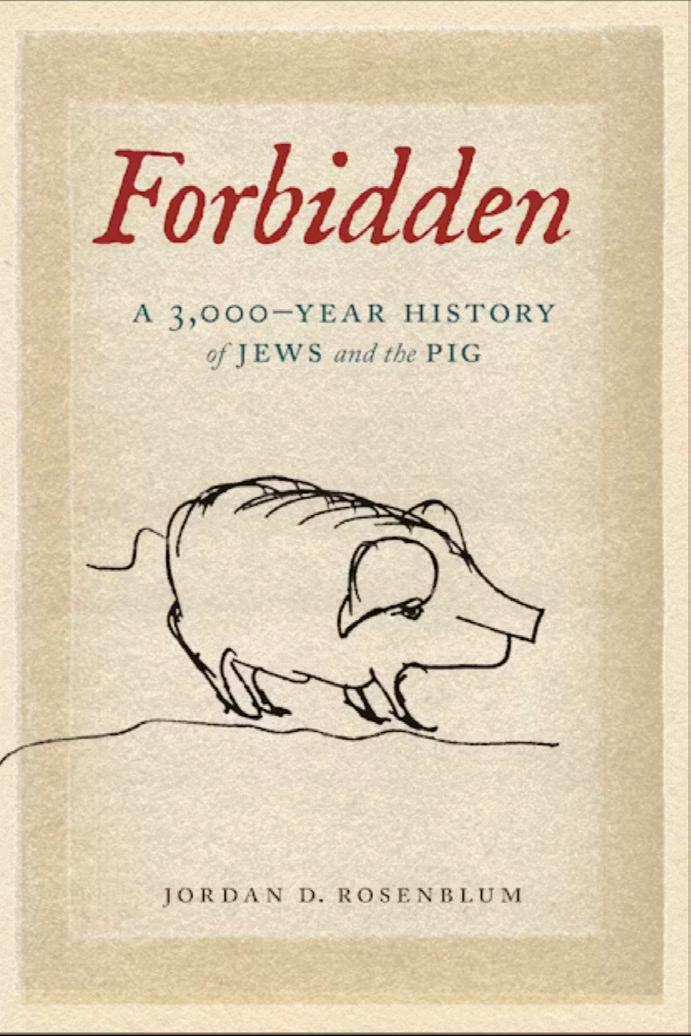
in asserting that “fear of a name increases fear of the thing itself.” By making the pig unmentionable, the rabbis only increased the animal’s power in the Jewish imagination. e aversion took on new meaning as the rabbis of the period of Roman rule, through some interpretive turns, began equating the despised animal with Rome. e comparison took on a somewhat literal dimension in one rabbinic account of the destruction of the Second Temple, reporting that the chief of the Roman soldiers catapulted a pig’s head into the Temple — and that Jerusalem fell at the moment when the pig’s head landed on the altar.
As Rosenblum moves through history, we see how non-Jews grasped the pig’s symbolic importance and o en used it as a vehicle for mockery and denigration. In medieval Europe, Christians, via a twisted logical jump, began to identify Jews with the pigs they refused to eat. e image of the Judensau (Jews’ sow) was popularized in Germany, and artistic representations of Jews suckling or engaging in obscene acts with an oversized sow proliferated.
Simultaneously, many Christians began to see eating pork as a means of distancing themselves from Jews. Rosenblum cites a song sung by Christians in Burgundy in the 17th century proclaiming that, because Jews disavow pork, “the more we eat the piglets, the be er Catholics we become.”
Moving chronologically, the book takes the reader on a whirlwind tour of Jewish diasporic history, focusing primarily on Europe and America. ere was considerably less drama around pork in Muslim countries, given Islam’s ban on its consumption.
In classical rabbinic texts, the sages often went so far as to avoid using the word pig altogether.
Of course, the Jewish relationship with pork is not defined exclusively by rejection of it. Rosenblum discusses many circumstances in which Jews have taken to eating pork, willingly or by necessity, reflecting their negotiation of their relationship with Jewish identity.
For Spanish Jews who converted to Christianity in the 15th century in order to avert persecution or expulsion, eating pork signaled their embrace of their adopted religion — a behavior that would become all the more important once the Inquisition began using avoidance of pork as evidence that the convert was secretly practicing Judaism.
For agrarian Jews on collective farms in the Soviet Union, raising swine was a signal



of a full embrace of communism, with religious observance relegated to the past.
And for many Jews who have sought to distance themselves from their traditional upbringings, the first taste of pork has served as a sort of rite of independence.
Rosenblum brings the discussion to the present day, concluding with the recent refusal of the Orthodox Union’s kosher certification body to give its approval to the fake meat product Impossible Pork, despite the product’s absence of any animal-derived substances. e grounds are not legal, but, rather, very much about inheriting this fraught relationship with the pig.
In this way, Rosenblum’s book, a model of bringing religion, history, and contemporary experience together, shows how the decisions we make today o en live in the shadow of those we have faced for centuries. ■
“Forbidden: A 3,000-Year History of Jews and the Pig” by Jordan Rosenbloom (New York University Press, 272 pages)




L.A. FIRE GIFT CARD DRIVE—Peninsula JCC is collecting cash and/or gift cards from vendors like Target, Trader Joe’s and Albertsons to support families affected by the Los Angeles wildfires. Drop off during operating hours at the welcome desk, 800 Foster City Blvd., Foster City. Through Feb. 28.
BABY CLOTHES COLLECTION—Oshman Family JCC is collecting gently used and laundered baby clothes for infants in need. Through March 2. Drop off during operating hours at the OFJCC Leslie Family Preschool front gate and OFJCC gym, 3921 Fabian Way, Palo Alto.
DIAPER DRIVE—Temple Emanu-El in San Jose is collecting boxes of diapers and wipes for Jewish Family Services of Silicon Valley. Through March 16. Dropoff at Emanu-El, 1010 University Ave., San Jose. tinyurl. com/diaper-drive-25
JFCS PURIM FOOD DRIVE—Jewish
Family and Children’s Services food bank is collecting donations of nonperishable items including soup, peanut butter, jam, macaroni and cheese, rice, cereal, oatmeal, granola bars, toothpaste, lotion, soap, paper towels and toilet paper. Drop off items at food bank locations: 2150 Post St., S.F.; 2001 Winward Way, No. 200, San Mateo; 200 Channing Ave., Palo Alto; 600 Fifth Ave., San Rafael. Monday-Friday, 9 a.m.-5 p.m. tinyurl.com/jfcs-food-bank
SUNDAY | February 23
NOSH, LEARN AND LUNCH-BAG PACKING—Southside Jewish Collaborative presents a volunteer opportunity to learn from Rabbi Chayva Lehrman and pack lunch bags for unhoused San Franciscans. At Congregation Am Tikvah, 625 Brotherhood Way, S.F. 1-2:30 p.m. Free. amtikvah.org
FRIDAY | February 21
COMMUNITY SHABBAT GATHERING— Tu Bishvat celebration with mystically inspired vegetarian seder. Presented by Jewish Gateways. At Albany Senior Center, 846 Masonic Ave., Albany. 6-8 p.m. $10-$25 suggested donation. tinyurl.com/ tree-shabbat
SUNDAY | February 23
“SECRETS HIDDEN IN MEGILLAT ESTHER”—Educator Aviv Matzkin discusses how the scroll of Esther contains surprising hidden references to three other Biblical stories. At Congregation Beth David, 19700 Prospect Road, Saratoga. 10:30 a.m. Free.beth-david. org/adult-education
FRIDAY | February 28
SHERITH ISRAEL REFUGEE SHABBAT—Seventh annual HIAS Refugee Shabbat with guest speaker
Adoubou Traore, founder and executive director of the African Advocacy Network. At Congregation Sherith Israel, 2266 California St., S.F. 6-7 p.m. Free. tinyurl.com/ sherith-refugee
SHABBAT AROUND THE TABLE— Shabbat celebration with rituals, dinner and live music. Pizza party for tots followed by catered buffet dinner from Wise Sons Deli. Presented by Jewish Baby Network. At JCCSF, 3200 California St., S.F. 5-8:30 p.m. $18-$72. tinyurl.com/ shabbat-table
FRIDAY | March 7
FAMILY SHABBAT—Family-friendly Kabbalat Shabbat service with special musical guest Lior Ben Hur. At Congregation Emeth, 17835 Monterey St., Morgan Hill. 7 p.m. Free. tinyurl.com/family-shabbat
SUNDAY | March 2
“WAGES OF EMPIRE”—Michael Cooper discusses his historical fiction book set in 1914 that follows a teen through the killing fields of the Western Front to Ottoman Palestine. At Congregation B’nai Shalom, 74 Eckley Lane, Walnut Creek. 3 p.m. Free. michaeljcooper.net
TUESDAY | March 4
“CONNECTING DOTS”—Joshua A. Miele discusses his memoir, which chronicles his experience learning how to navigate the world as a blind person. In conversation with J. columnist Alix Wall. At JCC East Bay, 1414 Walnut St., Berkeley. 6:30-8 p.m. $5. tinyurl.com/connecting-dots-book
WEDNESDAY | March 5
JENNIFER LANG IN CONVERSATION—
Jennifer Lang, author of Jewish- and Israel-centered books “Landed: A Yogi’s Memoir In Pieces and Poses” and “Places We Left Behind,” discusses compromise, country, yoga and self-acceptance with publisher
Clare Ellis. At Sausalito Books by the Bay, 100 Bay St., Sausalito. 6-7 p.m. Free. tinyurl.com/jennifer-lang
“MATZAH AND FLOUR”—Culinary historian Hélène Jawhara Piñer discusses her new cookbook, “Sephardi: Cooking the History,” a collection of 125 recipes showcasing how flour from sources such as barley and chickpeas sustained Sephardic families throughout history. Presented by JCCSF, the Magnes and JIMENA. At JCCSF, 3200 California St., S.F. 7-9 p.m. $42, includes cookbook. tinyurl.com/matzah-flour. Also, 5:30-7 p.m. March 6 at the Magnes, 2121 Allston Way, Berkeley. $20 (book sold separately). tinyurl. com/taste-sephardic
MONDAY | March 10
“COCA-COLA, BLACK PANTHERS AND PHANTOM JETS”—Historian Oz Frankel discusses his book, which examines the late 1960s as a unique moment when Israel became more closely entwined with the U.S. as a strategic ally and through its intensifying intimacy with American culture, society
SUNDAY | February 23
YOUNG ADULTS WINTER SOCIAL— Evening for Jews in their 20s and 30s with catered dinner, open bar and live DJ. Presented by the Castro, Marina, Nob Hill and RSJ Moishe Houses, Malka Productions, Value Culture, JCCSF, SF Bad Jews, Jewbillee and Israel Bonds. At Menorah Center, 5600 Geary Blvd., S.F. 6:30 p.m. $25-$45. tinyurl.com/sf-winter-social
“KOSHER NY-STYLE DELI NIGHT”— Chabad of the Neighborhood popup that includes matzah ball soup, potato knishes, rugelach, pastrami, corned beef and challah to go. Prices from $1-$20. At Chabad of
more listings see jweekly.com/calendar Submit items to events@jweekly.com
the Neighborhood, 85 West Portal Ave., S.F. 5:30-8 p.m. chabadneighborhood.square.site/deli
SUNDAY | March 9
“L’DOR V’DOR”—Hillel of Silicon Valley fundraiser and awards ceremony with keynote speech by Shai Davidai, an Israeli professor at Columbia Business School who has made headlines for his public stances against antisemitism and anti-Israel sentiment in higher education. At the Rotary Summit Center, 88 S. Fourth St., San Jose. 3-5 p.m. $72. hillelsv.org/ldor-vdor
and technology. Followed by light reception. Presented by the Helen Diller Institute and the Center for Jewish Studies, the Magnes and the departments of history and American studies at UC Berkeley. At Berkeley Law building, 2207 Piedmont Ave., Room 141, Berkeley. 4-5:30 p.m. Free. tinyurl.com/ oz-frankel
WEDNESDAY | March 12
“STATECRAFT 2.0: WHAT AMERICA NEEDS TO LEAD IN A MULTIPOLAR WORLD”—Ambassador Dennis Ross discusses his upcoming book, which explores a range of key foreign policy issues including the Israel/Hamas conflict, the broader dynamics between Israel and the Middle East and the roles of Iran, Russia and the U.S. in navigating today’s multipolar world. Presented by Jewish Silicon Valley. At Addison-Penzak JCC, 14855 Oka Road, Los Gatos. 7-9 p.m. $18 and up. tinyurl.com/dennis-ross-book
ONGOING
“IN PLAIN SIGHT: JEWISH ARTS AND LIVES IN THE MUSLIM WORLD”—Exhibit showcasing Jewish objects originating from Muslim lands that reflect cultural affinities and common threads between the cultures. Through May 15. At the Magnes, 2121 Allston Way, Berkeley. magnes.berkeley.edu
“ROOTS AND WINGS”—Exhibit by Israeli artist Ronit Shalem reflecting the balance between two powerful forces: the “roots,” representing Shalem’s connection to Israel and her personal experiences, and the “wings,” symbolizing her continuous artistic journey and growth. Through March. At Osher Marin, 200 N. San Pedro Road, San Rafael. tinyurl.com/omjcc-art
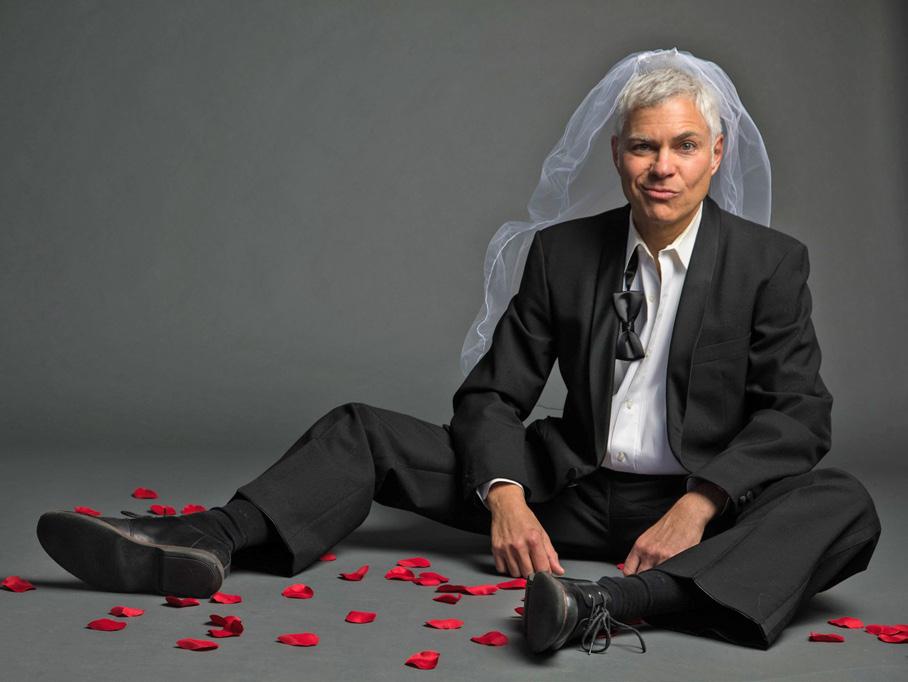
“Oy, What They Said About Love.”
‘Oy
Steve Budd’s one-man show called “Oy, What They Said About Love” tells the stories of real couples through their own words, culled from hours of interviews. From a Jewish couple who found each other through Craigslist to an interfaith pair who met at a Halloween party, Budd weaves in his hilarious search for “the one.” For ages 15 and up.
2 p.m. Saturday, March 1. At San Leandro Main Library, 300 Estudillo Ave., San Leandro. $30, cash only. tinyurl.com/ oy-love-show
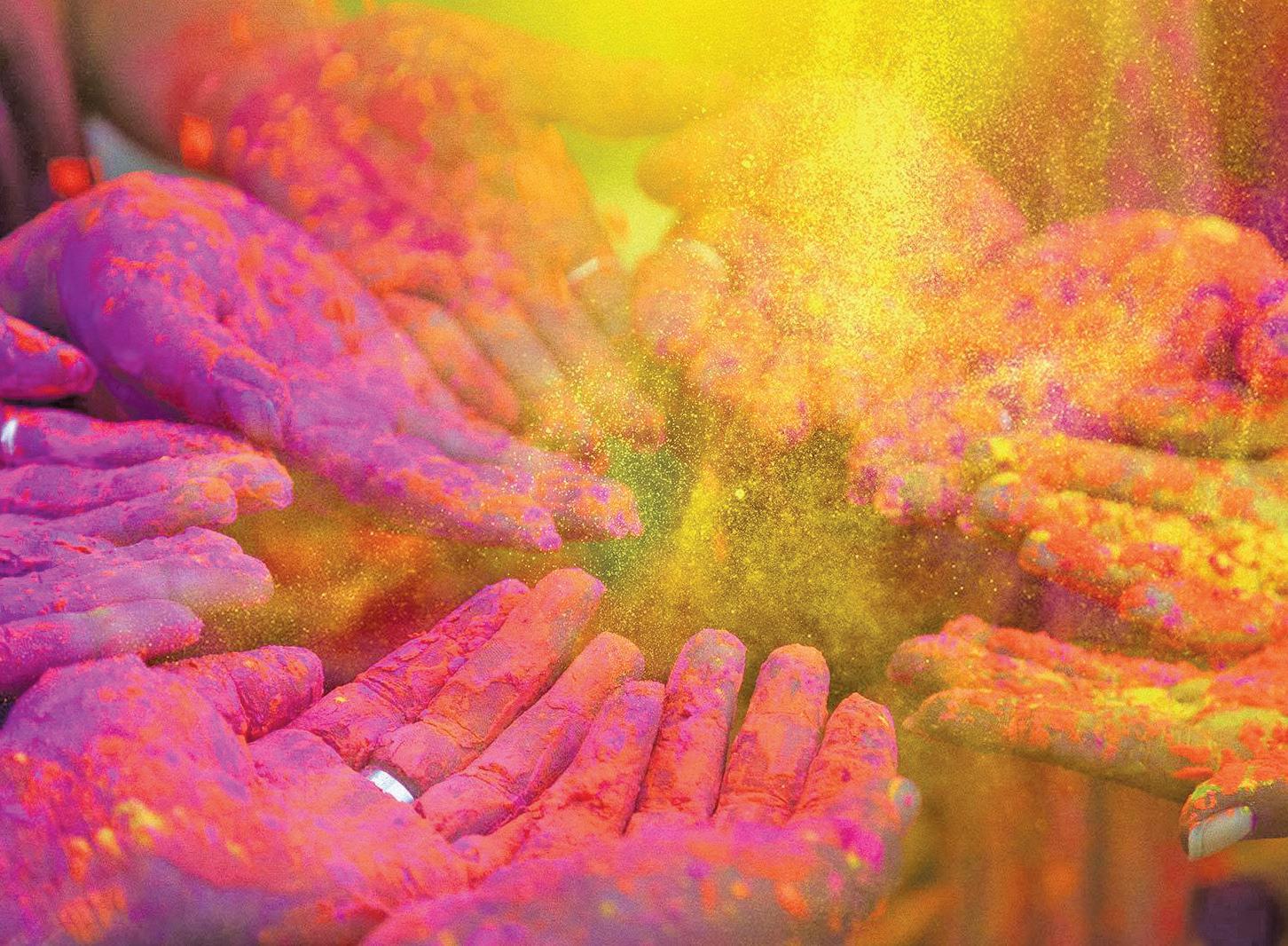
Jews and Hindus in the South Bay will come together for a joint celebration of Purim and Holi. Purim recalls the Jewish people surviving a potential massacre in Persia. Holi, a festival that honors Krishna, includes the tradition of throwing colorful powders called gulal. The event will feature food, storytelling, performances, prizes, henna art and gulal. Presented by JCRC Bay Area, the Hindu American Foundation, Jewish Silicon Valley and Mosaic America.
12 p.m. Sunday, March 9. At Addison-Penzak JCC, 14855 Oka Road, Los Gatos. $10 early bird, $18 after March 2. tinyurl.com/holi-purim
Holi colors. (GOODFON.COM)
ONGOING
SACRAMENTO JEWISH FILM
FESTIVAL—26th annual festival with 25 films, featuring “The Blond Boy from the Casbah,” “Janice Ian: Breaking Silence” and “Bliss.” Available for viewing online or in person; details vary. At Crest Theatre, 1013 K St., Sacramento, through Feb. 23. Livestream Feb. 24-March 9. sacjewishfilmfest.org
SATURDAY | February 22
“THE TRIALS OF ALAN DERSHOWITZ”—Screening of documentary examining the famed attorney’s career, including his most notable victories, lesser-known losses and legal battles involving one of Jeffrey Epstein’s victims who accused Dershowitz of sexual misconduct. Followed by discussion with law professor Michael Asimow. At Congregation Beth Am, 26790 Arastradero Road, Los Altos Hills. 3:30 p.m. Free. tinyurl.com/ trials-film
JFI WINTERFEST—Opening night of 12th annual festival. With six films and events, including “Everything You Have Is Yours.” Through Feb. 23. At Vogue Theater, 3290 Sacramento St., S.F. Passes are $75, JFI members; $100, general public. jfi. org/programs/winterfest-2025
EAST BAY INTERNATIONAL JEWISH FILM FESTIVAL—Opening night of the 30th annual festival featuring “Midas Man” and 36 other films. Available for viewing online or in person. At Century 16 Theater, 125 Crescent Drive, Pleasant Hill. Feb. 22-27. Livestream March 9-20. $180 festival pass, $12-$15 individual films. eastbayjewishfilm.org
“UNDER G-D”—Documentary examines the complex struggles individuals face exercising their reproductive rights. Followed by discussion centered on how these issues align with Jewish values of human dignity, autonomy and justice. Presented by Tri-Valley Cultural Jews. At Castro Valley location provided with RSVP. 3-4:30 p.m. $15 nonmembers, free for members. RSVP at culturaljews@ gmail.com
TUESDAY | February 25
“SCREAMS BEFORE SILENCE”— Screening and discussion of Sheryl Sandberg’s documentary about the sexual violence committed by Hamas in Israel on Oct. 7, 2023. Facilitated by executive director of Shalom Bayit Naomi Tucker. At Peninsula Temple Beth El, 1700 Alameda de las Pulgas, San Mateo. 7-9 p.m. Free. tinyurl. com/screams-film
SATURDAY | February 22
DARWIN DAY/TU BISHVAT BAGEL BRUNCH—Author and environmental activist John Berger discusses climate solutions. Presented by Kol Hadash. At Albany Senior Center, 846 Masonic Ave., Albany. 11 a.m. $7.50 members, $10 public. kolhadash.org
SUNDAY | February 23
“WELCOMING THE IMMIGRANT: JEWISH ETHICS IN THE FACE OF RISING NATIONALISM”—Rabbi Armin Langer explores the Jewish concept of the “resident alien” and how this legal category could inform contemporary migration discourse. With kosher buffet brunch. Presented by Or Shalom Jewish Community. At JCCSF, 3200 California St., S.F. 10 a.m.-12 p.m. Free. tinyurl.com/ welcoming-immigrant
MONDAY | February 24
“TRAUMA AND TRANSFORMATION: CREATING A FOUNDATION FOR HEALING AND JUSTICE”—Karen Erlichman explores the physical, emotional, political and spiritual complexity of individual and collective trauma, offering tools and resources for healing. Part of “Narrow Bridge” series. Livestream option. At Congregation Sha’ar Zahav, 290 Dolores St., S.F. 7 p.m. $36 per session, $230 for series. tinyurl.com/the-narrowbridge
“AN EVENING WITH ISRAELI ARTIST HANOCH PIVEN”—Hands-on workshop exploring artistic reinvention and self-expression by creating
playful self-portraits using everyday objects. Followed by reception. For ages 14 and up. At Yavneh Day School, 14855 Oka Road, No. 100, Los Gatos. 6:30-8 p.m. $54. Proceeds benefit Yavneh. tinyurl. com/hanoch-piven-workshop
TUESDAY | February 25
“WHAT’S GOD PLAYING AT?”—Christine Hayes, professor emeritus of religious studies at Yale, explores Talmudic conceptions of Divine law through performance studies and theories of humor and play. 16th Annual Robbins Collection Lecture in Jewish Law, Thought and Identity at the Helen Diller Institute. With light reception. At Room 105, UC Berkeley School of Law, 2763-2719 Bancroft Way, Berkeley. 6-7:30 p.m. Free. tinyurl.com/god-playing
WEDNESDAY | February 26
“REVISITING THE LEO FRANK CASE”— Journalist and author Steve Oney discusses 1913 murder of Mary Phagan and subsequent arrest, trial and lynching of Leo Frank. Part of this year’s One Bay One Book program. Presented by Jewish Community Library. Online. 7 p.m. Free. tinyurl.com/leo-frank-case
“THE MEANING OF HEBREW IN AMERICA”—Sharon Avni discusses the significance of Hebrew for American Jews in an interactive presentation about how American Jews understand Hebrew both literally and symbolically. Presented by the Taube Center for Jewish Studies at Stanford. At Stanford University, Building 320, Room 220,
SATURDAY | February 22
“GATHERING IN PRAYER”—Israeli and Palestinian musicians Lior Tsarfaty, Naser Musa, Damond Moodie, Eliyahu Sills, Michaelle Goerlitz and more perform traditional music and pray for peace and safety in the Middle East. At Chochmat HaLev, 2215 Prince St., Berkeley. 7-9:30 p.m. $45. tinyurl. com/gathering-prayer
SATURDAY | March 1
DAN NICHOLS IN CONCERT—Jewish rock musician and composer performs original music. At Congregation Beth Emek, 3400 Nevada Court, Pleasanton. 6:30-7 p.m. $20 adults, $10 kids, free for 4 and younger. tinyurl.com/ dan-nichols
450 Jane Stanford Way, Stanford. 5:30-6:30 p.m. Free. tinyurl.com/ hebrew-meaning
THURSDAY | February 27
“CREATING COMMUNITIES THROUGH STORYTELLING: RUTU MODAN”—
Graphic novelist Rutu Modan presents screening of “The Property,” based on her novel of the same name, followed by a discussion with writer-in-residence and award-winning author Maya Arad. Presented by the Taube Center for Jewish Studies at Stanford. At Stanford University, CCSRE conference room, 450 Jane Stanford Way, Stanford. 3-6:15 p.m. Free. tinyurl. com/creating-communities
SUNDAY | March 2
“THE TRIUMPH OF LIFE: A NARRATIVE THEOLOGY OF JUDAISM”—Rabbi Irving Greenberg presents his magnum opus on Judaism’s covenantal journey through modernity, the Holocaust and Israel’s creation, calling for an ethic of power that advances life. Presented by Jewish Community Library. Online. 11 a.m. Free. tinyurl.com/triumph-life
MONDAY | March 3
“SPECTRA OF POLITICAL FREEDOMS”—Neil Grungras discusses the commonalities and differences among restrictive national environments, and what we can learn from those who have lived in such countries about protecting ourselves and preserving personal freedom and safety as Jews and queer people. Presented by Congrega-
SUNDAY | February 23
SUNDAY FUN DAY—Jewish Baby Network and Temple Sinai preschool present event with music, dancing, puppets, play, tea and snacks. At Temple Sinai, 2808 Summit St., Oakland. 3:30-5 p.m. $18 suggested donation. tinyurl. com/sunday-jbn
SUNDAY | March 2
PURIM PARADE AND COSTUME PARTY—Jewish Baby Network and Kehilla Synagogue present holiday celebration with singing, dancing and hamantaschen. Bring a costume. At Dracena Quarry Park, 130 Dracena Ave., Piedmont. 10:30 a.m.-12 p.m. $18 suggested donation. tinyurl.com/purim-party-jbn
FRIDAY | March 7
FUN FRIDAY STORY TIME—Preschool teacher Jessica and PJ Library present holiday story time,
tion Sha’ar Zahav. Part of “Narrow Bridge” series. Online. 7 p.m. $36 per session, $230 for series. tinyurl. com/the-narrow-bridge
TUESDAY | March 4
“RAISE A GLASS, BUT NOT TOO MANY”—Shabbat workshop exploring the role of wine in Judaism. Part of the “Everyday Magic: Jewish Wisdom and Global Practices for Daily Life” series. At Oshman Family JCC, 3921 Fabian Way, Palo Alto. 9-10:30 a.m. $18. tinyurl.com/everyday-magic-series
WEDNESDAY | March 5
“FROM STUDENT ACTIVIST TO THE HALLS OF CONGRESS”—Shabbos Kestenbaum shares his journey starting as a student looking to make change to becoming the lead plaintiff against Harvard University, alleging pervasive and systemic antisemitism. Co-sponsored by Chabad North Peninsula, Peninsula JCC, Ronald C. Wornick Jewish Day School and Chabad at Stanford. At Lent Chabad Center in San Mateo, RSVP for full address. 6:30 p.m. Free. chabadnp.com/shabbos
“ISRAEL, THE ENVIRONMENT AND THE MIDDLE EAST PEACE PROCESS”—Alon Tal, visiting professor at Stanford’s department of sustainability and one of Israel’s leading environmentalists, discusses Israel’s environmental challenges, cross-border cooperation in the region and how environmental efforts can play a role in the Middle East peace pro-
cess. At Congregation Sinai, 1532 Willowbrae Ave., San Jose. Free. 7 p.m. Free. tinyurl.com/alon-tal
MONDAY | March 10
“DOES EMIGRATION MAKE SENSE FOR YOU?”—In light of the current political climate, Neil Grungras discusses options for living in another country, including factors to consider when relocating and pathways to getting there. Part of “Narrow Bridge” series. Livestream option. At Congregation Sha’ar Zahav, 290 Dolores St., S.F. 7 p.m. $36 per session, $230 for series. tinyurl. com/the-narrow-bridge
TUESDAY | March 11
“DRESSING THE PART”—Purim workshop exploring how special garments and accessories shape our emotions in everyday and special moments. Part of the “Everyday Magic: Jewish Wisdom and Global Practices for Daily Life” series. At Oshman Family JCC, 3921 Fabian Way, Palo Alto. 9-10:30 a.m. $18. tinyurl.com/everyday-magic-series
THURSDAY | March 13
ADULT EDUCATION: BOOK OF ESTHER—Rabbi Steve Finley and Reb Neal Attinson lead discussion-based lessons of the Book of Esther before Purim. Also March 20, 27. At Congregation Shir Shalom, 252 W. Spain St., Sonoma. 1-2:15 p.m. Free. tinyurl.com/adult-education-class
featuring “The Purim Superhero” by Elisabeth Kushner. Followed by a physical education activity. At Oshman Family JCC, 3921 Fabian Way, Palo Alto. 4:15-5:15 p.m. Free, RSVP required. tinyurl.com/purim-story-time
SUNDAY | March 9
“FAMILY COOKING: HAMANTASCHEN FOR PURIM”—Hands-on baking workshop for kids and parents to learn to bake hamantaschen from scratch. Led by Michelle Greenebaum from Together In The Kitchen. At Oshman Family JCC, 3921 Fabian Way, Palo Alto. 4-5 p.m. $44.52. tinyurl.com/family-cooking-purim
PURIM EXTRAVAGANZA—Jewish Baby Network event with singing, dancing, puppets, hamantaschen, holiday-themed snacks, costumes and a Purim goodie bag to take home. At Peninsula Sinai
Congregation, 499 Boothbay Ave., Foster City. 3:30-5 p.m. $18 suggested donation. tinyurl.com/ jbn-purim-25
CONTRA COSTA PURIM CARNIVAL—Holiday celebration with games, pony rides, face painting, a raffle, food, costume contest and more. Presented by Contra Costa JCC, Congregation B’nai Tikvah, Congregation B’nai Shalom, Congregation Beth Chaim, PJ Library, Contra Costa Jewish Day School, Midrasha and Shevet Egoz. At B’nai Shalom, 74 Eckley Lane, Walnut Creek. 10 a.m.-1 p.m. $20 per child before March 7, $25 after; under 2, free. ccjcc.org/upcoming-events
EAST BAY PURIM CARNIVAL—Holiday celebration with carnival games, crafts, face painting, hamantaschen, mishloach manot, Purim spiel, costumes and talent
show. At JCC East Bay, 1414 Walnut St., Berkeley. 2-5 p.m. $36 per family. tinyurl.com/jcceb-purim-25
PURIM PARTY IN THE PARK—PJ Library, Tkiya and Jewish Gateways present sensory-friendly, outdoor Purim celebration for families with young children featuring music, snacks, books, crafts and more. Costumes encouraged. At Kennedy Grove Regional Recreation Area, 6531 San Pablo Dam Road, El Sobrante. 3-4:30 p.m. Free. tinyurl. com/purim-party-park
FRIDAY | March 14
“PURIM IN ISRAEL”—Holiday celebration for families featuring live Israeli music, Israeli style food, selfies at the “Western Wall,” kids activities and Megillah reading. At the Lent Chabad Center in San Mateo, RSVP for full address. 5:30-6:30 p.m. $5-$10. chabadnp. com/purim
ALISHA PEDOWITZ | GUEST CONTRIBUTOR
Jewish educators have at our fingertips a powerful antidote to the epidemic of despair and loneliness plaguing our society: spirituality.
That was my main takeaway from the keynote talk at SoulFull, a conference hosted by Jewish LearningWorks that drew close to 100 Jewish educators from across the Bay Area to Berkeley on Feb. 6.
As someone who has worked in the field of Jewish education for over 20 years and attended countless conferences on Jewish education, it was refreshing to have our day begin with a keynote on neuroscience. Dr. Lisa Miller of Columbia University, author of “The Awakened Brain: The New Science of Spirituality and Our Quest for an Inspired Life,” explained her latest research on the neuroprotective impact of spiritual experiences.
Miller’s research demonstrates that spiritual experiences — those which strengthen the sense that life is rich with meaning and which cultivate relationships with the self, one’s community and God — are important in countering the mental health crisis that impacts a majority of American adolescents. The U.S. surgeon general, the American Academy of Pediatrics and the American Psychological Society have all highlighted the dramatic rise in depression, anxiety and suicidal ideation. Over 50% of all adolescents meet the criteria for at least one of these, per the Centers for Disease Control.
In former Surgeon General Vivek Murthy’s “Parting Prescription for America,” he called the eroding sense of community a key factor in the “epidemic of diseases of despair.” His prescription is to build community through “relationships, service, and purpose.”
According to Miller, communal spiritual experiences strengthen the pathways in the brain that make it resilient to depression and prime it to find sources of hope and support. She speaks of using Jewish language and tradition to help young people not only ascribe meaning to daily lives, but to provide them with ways of feeling “loved, held, guided and never alone.”
During her talk, I was reminded of being a teenager at Jewish camp, as our camp rabbi was leading a discussion on the idea that God is the “still, small voice inside of us.” The rabbi invited us each to fully wrap ourselves in a tallit like a cocoon and stand in that stillness. I remember being aware of the other people around me, while also experiencing the “still, small voice” in a way I never had. My focus turned deeply inward while my awareness was attuned to the community around me. I felt “loved, held, guided and never alone” — priming my brain for similar experiences moving forward. That moment still influences the way I pray, as I seek both to feel held by the community and to look for guidance in navigating challenges.
Miller’s message was a balm for the souls of educators who feel depleted after buoying their communities through years of crises. We are nagivating a barrage of threats to young people’s emotional development and mental health: the pandemic’s lingering effects, the Oct. 7 attack and Israel’s reponse, antisemitism in schools, the climate crisis and other existential fears. Educators wonder if we are doing enough.
That is why this year, Jewish LearningWorks launched the Bay Area Jewish Youth Resilience Roundtable, a group of professionals representing 13 local organizations who sit at the intersection of adolescent mental health and meaningful Jewish youth programs. Together, we are exploring how Judaism can cultivate resilience in our students. We invite all Bay Area organizations concerned about adolescent wellness to join us. If this is a crisis of the public sphere, then we have the collective responsibility to respond. n
Alisha Pedowitz is a senior educator at Jewish LearningWorks who has worked for over 20 years in the field of Jewish education and community building.
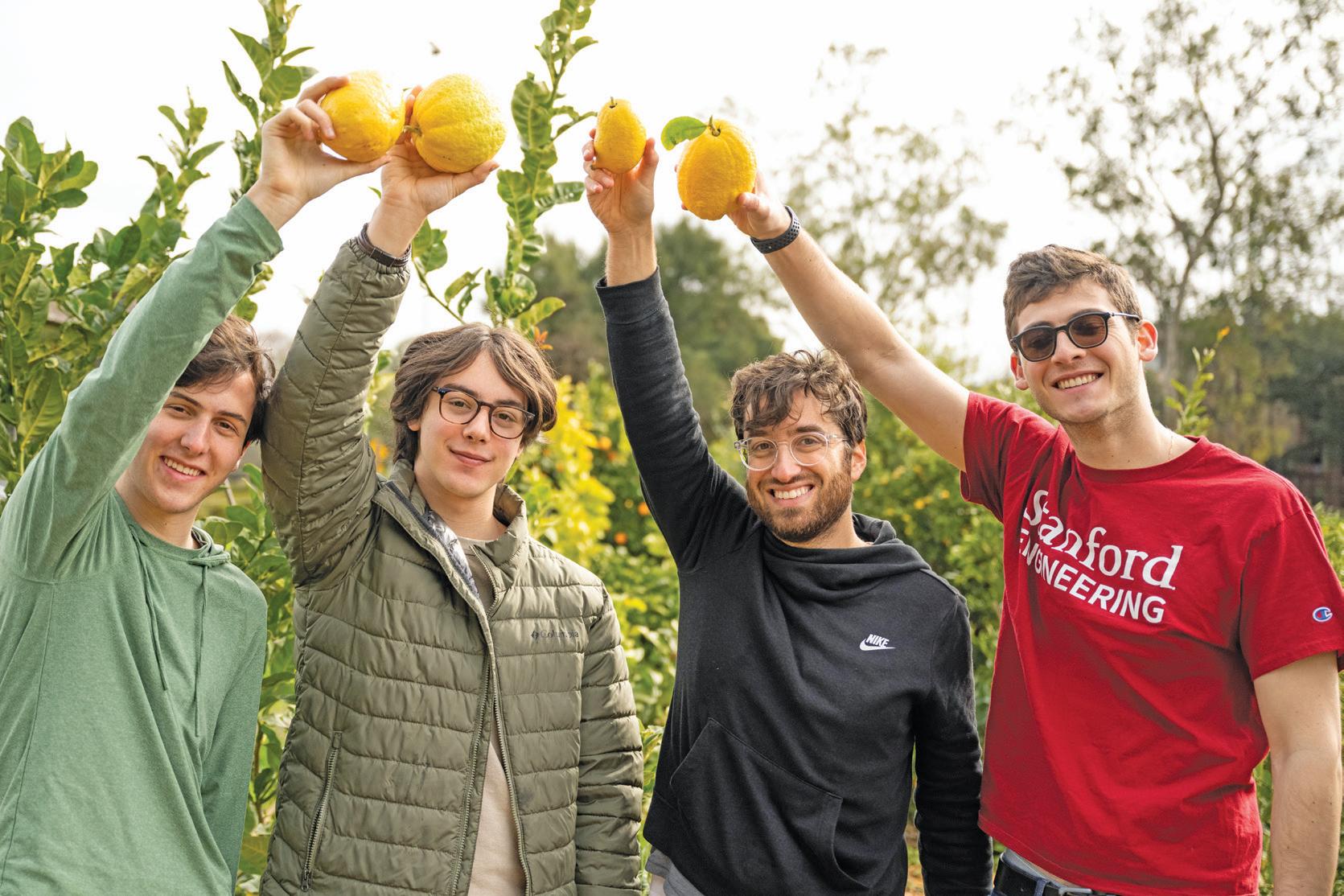
THIS: The day before Tu Bishvat, the ancient tax day that has come to be known as a kind of Jewish Arbor Day, the Stanford chapter of the Jewish environmental organization Adamah held an event at O’Donohue Family Stanford Educational Farm in Palo Alto. Hillel Rabbi Eli Weinbach (second from right) and students (from left) Wyatt Sklarin, Adamah chapter co-president Gideon Witchel and Ben Stettin hold up girthsome etrogs they harvested at the event. (AARON LEVY-WOLINS/J. STAFF)
Cal still has work to do
As a lecturer at UC Berkeley, I deeply appreciate professor Ron Hassner’s efforts to advance the rights and welfare of Jewish students, staff and faculty and their access to equality, freedom and fair treatment that respects our civil rights and access to justice. (“Trump’s antisemitism probe doesn’t reflect UC Berkeley’s progress,” online Feb. 7)
Harassment, abuse, intimidation and discrimination have impacted our campus Jewish community in lasting ways that continue to be felt, causing ongoing hurt and harm. Many Jewish members of our campus community are marginalized, are unable to express their Jewish identities and beliefs because of prevalent prejudice and hostility, and face both explicit and implicit forms of exclusion on account of their Jewish identities, practices and affiliations.
As Hassner writes, “much is left to be accomplished” to address antisemitic hate and discrimination at UC Berkeley. He notes that campus leadership reacted “slowly” to the violation of our rights and welfare and did not take vigorous action to adequately respond to these violations. Indeed, UC Berkeley still needs to do a better job of respecting civil rights law and equality for
all members of the Cal community, without discrimination on the basis of religion, ethnicity, shared ancestry or nationality and without excluding Jews from respect for these legal obligations and the university’s Principles of Community.
While there have indeed been some improvements in the climate on campus and in campus policies impacting Jewish individuals and our community under the new chancellor’s leadership, these need to be made more durable. Support for the welfare and both equity and equality of Jewish members of our community needs to be better resourced in a substantive, sustainable way that reflects a genuine long-term commitment to our wellbeing, dignity and full inclusion in the university community.
NOAM SCHIMMEL | UC BERKELEY LECTURER
Anita Friedman is a ‘community treasure’
Turning the pages of J.’s last few issues I was struck repeatedly by the positive impact of the San Francisco-based Jewish Family and Children’s Services under the brilliant leadership of its longtime executive director, Anita Friedman.
RABBI NICO SOCOLOVSKY | GUEST CONTRIBUTOR

Who doesn’t love a good round of “Would You Rather?” Would you rather always feel like there’s a pebble in your shoe, or have an itch you can never quite scratch? Would you rather relive your most embarrassing moment once a week, or have a stranger insult you every day? Would you rather lose your ability to taste food, or never be able to listen to music again?
President Donald Trump recently posed, essentially, a “would you rather”: Gaza — or no Gaza?
And thousands of voices, compelled by the idea of a huge challenge simply disappearing, got excited.
As a congregational rabbi with a weekly teaching from my pulpit, my thoughts turned to last week’s Torah portion, Beshalach, which offers the Israelites something of a “would you rather” as they flee slavery in Egypt:
“The Egyptians pursued them and overtook them encamped by the sea — all of Pharaoh’s chariots, horsemen, and army.” (Exodus 14:9)
Would you rather face Pharaoh’s army, or throw yourself into the sea? An impossible choice.
It was hard to believe that the mighty sea could split. In fact, the Midrash tells us that the sea actively resisted.
“As Moses stood before the sea ... the sea scoffed, ‘I was created on the third day — you, humanity, came on the sixth. Who are you to command me?’”
The Hasidic master Kedushat Levi explains that nature,
JFCS embodies the values that unite us as Jews across all boundaries and categories. Friedman is a truly remarkable and inspiring leader. She and her team have attracted, trained and retained a diverse group of highly skilled, able, hard-working and compassionate social workers, therapists and other professionals who have helped many of our families, often during our most difficult life experiences.
Friedman has built a once-tiny agency into what is now a crown jewel, a reflection of who and what we can be in our best moments. There is no way to begin to describe all the good JFCS has done. If you want to do something to alleviate the suffering we see all around us but don’t know what to do or where to start, may I suggest you send a check to JFCS today and or perhaps look over its volunteer opportunities.
There are so many of us who will never be able to thank Anita Friedman enough for making the health and wellbeing of our community her life’s work. She is a community treasure.
HAL PLOTKIN | PALO ALTO
after fulfilling its role for so long, can begin to see itself as independent. So God humbled the sea — not just splitting it, but forcing it to dry up completely with a mighty east wind, stripping it of its pride.
As the Israelites crossed, the Egyptians drowned behind them. In heaven, the angels prepared to sing in praise. But the God stopped them, saying: “My children are drowning in the sea, and you are singing before Me?”
The angels fell silent. Though justice was served, God did not rejoice in destruction. But the Talmudic Rabbi Yosei bar Chanina adds a striking nuance: While God does not celebrate the downfall of the wicked, He allows others to rejoice. The Israelites, standing on the shore, were not chastised for their song. Their joy was not in the suffering of their enemies, but in their own miraculous salvation. Justice had been done, but the heavens remained solemn.
But Trump’s proposal was not like Moses raising his hand and God splitting the sea. It was more like suggesting the entire sea be vaporized — for its own good.
Some have told me: “Now that the idea is on the table, those who didn’t want to get involved will engage.” Others have said: “What’s the big deal? It’s just a fantasy. Aren’t we allowed to have fantasies?”
And some have argued: “It’s nearly impossible to rebuild Gaza given the destruction and the tunnel system beneath. Relocating its people might actually be a good idea.”
In Israel, a survey showed that 82% of the Israeli Jewish population favor the idea — including 30% who find it desirable but not realistic. Among Israeli Jews, only 3% think the plan is “immoral.”
I’d like to offer three ideas I’ve been reflecting on over the past few days and invite you to think along with me:
1. Have empathy for our people. Before we judge Israelis or Americans who support something that could be considered ethnic cleansing, let’s acknowledge a painful truth: Most of us prefer to choose our neighbors. Imagine
within a few hours. (“Joy and pride, not crises, pulled me back to Judaism,” Feb. 7)
Praying at the Western Wall is a memory I will savor for the rest of my life. There is so much to see and absorb in Israel. The archaeological digs are fascinating. Spending time with local people and learning of life in Israel today is an honor. I gained so much on my 10-day visit, and later returned as a volunteer. I encourage people of any age to experience Israel.
JILL MALESON | FREMONT
The antisemitic statements and actions of certain union officials and members toward UC Berkeley postdoc Karin Yaniv and other Jewish union members were deeply disturbing to me. (“In suit, Israeli postdoc accuses Cal union of anti-Israel bias,” Feb. 7) However, the lawsuit was filed by the Fairness Center, which focuses on suing public-sector unions. This is disturbing and represents how difficult it is for a Jewish liberal like me who supports standing up to antisemitism and the role of unions.
being assaulted, tortured, abducted and witnessing loved ones murdered by your neighbors. Wouldn’t the idea of sending them as far away as possible feel compelling?
2. Measure with the same scale. “You shall not have in your house alternate measures, a larger and a smaller,” says Deuteronomy 25:14 — a rule that addresses inconsistent or unfair treatment in the form of a double standard.
Whether or not it’s realistic, we must ask: Is it morally acceptable? If we legitimize population transfers, what are we setting a precedent for? And could it backfire?
If we say that a large portion of a population living on a small strip of land is constantly causing problems for its larger and more powerful neighbor, and that this population can be removed for the sake of the more powerful neighbor’s security, what happens when we zoom this out?
Israel itself is a small strip in the Middle East. Could someone in the U.S. government one day make the same argument about Israel? Could they echo the rhetoric we have heard from antisemitic protesters, that “Jews should go back to Europe”?
3. It’s hard to imagine the sea can split. I hope that those advocating the expulsion of Palestinians from Gaza don’t really want to see people forced to leave their homes. I want to believe that what most people really want is peace — but it feels so impossible to imagine something better, that we fall back on a much worse option.
Would you rather: see Israel and Gaza coexist, or see one side disappear? Would you rather: believe peace is possible, or believe destruction is inevitable? Maybe our greatest challenge is not choosing between impossible options, but choosing to believe there is another way. n
The views expressed on the opinion pages are those of the authors and do not necessarily reflect the views of J.
Many thanks to Leslie Katz for the feature on the invincible women of Santa Rosa Congregation Beth Ami, Susanne Batzdorff, Evelyn Gurevitch and Edith Newman. (“Three centenarians find joy at Beth Ami, and with each other,” Feb. 7)
My sister Evelyn and I resided in Santa Rosa for many years; our parents were Beth Ami members. When our father became ill, Evelyn and Edith were always there for us. During difficult times, they were role models, reflecting the values of Judaism: strength, joy and kindness. After many years, my sister and I still thank them for making us feel part of the community. It was a privilege to know them.
DEBORAH MARGOLIN | AMHERST, MASSACHUSETTS
Israel feels like home
Reading Janet Silver Ghent’s column, which mentioned her first trip to Israel, made me sad. My first trip to Israel still gives me chills. I literally kissed the ground upon arrival. It felt like home
I think it would have been helpful if you had included information about the Fairness Center. I wish she did not have such problematic, to me, legal representation.
CAROL EVANS | WALNUT CREEK
J. welcomes letters of no more than 300 words. Submissions are subject to editing. See guidelines and form at jweekly.com/letters, or email to letters@jweekly. com.
RABBI CHAYVA LEHRMAN | GUEST CONTRIBUTOR
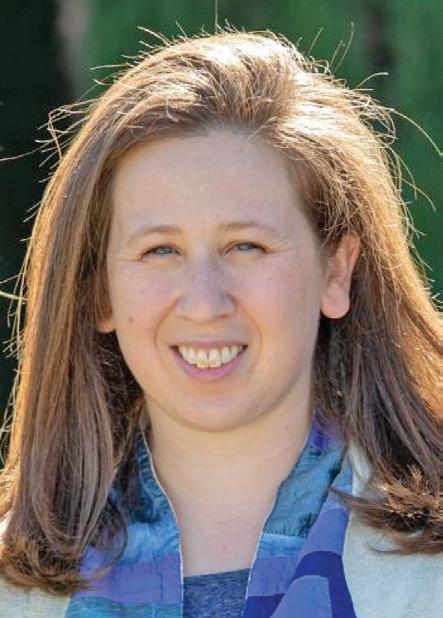
Before the U.S. Agency for International Development’s website was dismantled by the new Trump administration, it stated, “USAID leads international development and humanitarian efforts to save lives, reduce poverty, strengthen democratic governance and help people progress beyond assistance.”
USAID, where I once proudly worked, was essentially describing itself — albeit in classically stodgy governmental prose — as the outward-facing part of the mission set forth in Emma Lazarus’ sonnet “The New Colossus”: …Mother of Exiles. From her beacon-hand Glows world-wide welcome; her mild eyes command The air-bridged harbor that twin cities frame. “Keep, ancient lands, your storied pomp!” cries she With silent lips. “Give me your tired, your poor, Your huddled masses yearning to breathe free, The wretched refuse of your teeming shore. Send these, the homeless, tempest-tost to me, I lift my lamp beside the golden door!
Lazarus’ poem, one of the greatest works of Jewish American literature, welcomed many of our families to this goldene medina. Despite fits and spurts of a tenacious antisemitism, American Jewry has thrived here.
I am one of many beneficiaries of America’s embrace of Jews. Upon graduating from college in 2011, my great American dream was to move to Washington, D.C., and work in foreign relations. In 2014, I started a job at USAID.
I was drawn to USAID by my Judaism; our somewhat nomadic history and the eternal link between Jews all over the world led me to feel like a citizen of the world. I was also motivated by my belief that each person is made b’tzelem Elohim, in the image of God. Many who work in the international development field are drawn by a similar sense of compassion and global citizenship.
America’s highest value is not its exceptionalism, but how we use the great privilege of our wealth and power.
And of course there is the practical side to USAID’s work. The agency’s raison d’etre and the best case for its federal funding is that its projection of American soft power is the U.S. government’s most cost-effective diplomatic tool.
The Trump administration claims that its philosophy is “America first,” but its behavior demonstrates a creed of “America only.” Closing USAID is not just a bureaucratic change. It signals a shift away from a vision of America that is engaged, compassionate and strategic.
As Jews and as Americans, we must respond by
opposing this shift and by articulating and championing a vision of progressive patriotism.
This vision must be framed positively: America’s highest value is not its exceptionalism, but how we use the great privilege of our wealth and power. I believed this long before I left government work and became a rabbi. My commitment to that perspective has only deepened over the years.
and South Africa. In fact, from 2001 to 2014, the value of USAID’s public-private partnerships exceeded $16.5 billion.
Now America will lose all of that income. And much worse, millions around the world could die. Nobody wins.
If service and lovingkindness — two out of three legs the world stands on — collapse, how will the world go on?
As Jews, we know what happens when countries close their doors, ignore suffering and frame compassion as

In Pirkei Avot, Shimon Hatzadik famously teaches that the world stands on three legs: Torah, avodah (service, either in prayer or good deeds), and gemilut chasadim (acts of lovingkindness). I have seen this fulfilled in USAID’s work.
I worked on a program called Partners for Enhanced Engagement in Research, which gave grants to scientists doing critical policy work for governments that did not have the means to fund research. I helped American institutions of higher education — from major agricultural research institutions to diverse urban community colleges — connect to similar institutions abroad and expand the impact of their work. I saw colleagues help end the Zika virus epidemic, provide water access in drought-stricken Kenya, protect against rising water levels in Bangladesh, help Indonesians rebuild after the Sulawesi earthquake and tsunami, and so much more.
Any American tourist knows that the U.S. dollar goes far in low-income countries; the most expensive part of many of USAID programs was paying American farmers for their crops and American drug companies for their medicines. USAID also partners with American corporations, such as Microsoft, to expand internet access in rural India, Nigeria
weakness. As Americans, we know that security comes from partnerships of mutual benefit and the value of a good reputation.
Rabbi Mordecai Kaplan taught that American Jews are dual citizens of both the Jewish and American civilizations. As such, we don’t just live here; through us, our Jewish values shape what this country stands for. Louis Brandeis famously said, “To be good Americans, we must be better Jews.” He was making a point about Zionism, but it also applies to responding to this moment in history with clarity and diligence.
Losing USAID shows us that something about America is broken. but our outcry against that proclaims there is an equal and opposing force for good within this country. Even as we feel besieged by domestic antisemitism, our Jewish community must take up the work of avodah and gemilut chasadim when the government steps away.
The work before us isn’t just the fight against populist isolationism. It’s also about claiming and propagating a vision of America that we are proud to call our own, one that reflects both Jewish and American values. And then we need to put our money where our mouth is. n
The
TORAH | RABBI SHANA CHANDLER LEON
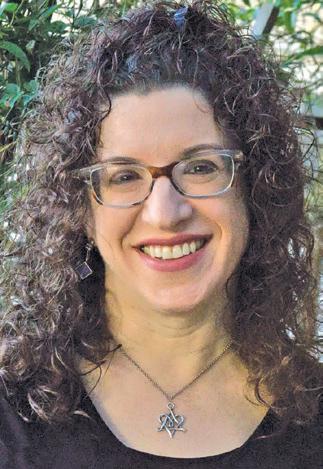
Mishpatim
Exodus 21:1-24:18
The nation heard the mishpatim (rules) of the Eternal and cried as one: “Na’aseh v’ni’sh’ma!” (Exodus 24:7) This riddle of a declaration could mean: We will do and we will obey; we will do and we will understand; we will faithfully do; or in its most literal sense, we will do and we will hear.
We may never know what the people intended, but what echoes through the ages may be this: After Moses “took the record of the covenant and read it aloud to the people” (Exodus 24:6), our ancestors committed first to do, and then to wrestle with the implications of what it all might mean.
For many Jews, performing the mitzvot as diligently as possible is sufficient to honor the directives given to Moses as our forebears heard and interpreted them. For others, many of the Torah precepts, expanded and expounded upon by centuries of scholars, are just a mystery. We struggle with the idea of “doing” when we do not “understand.”
For much of my early life, one of the commandments laid out in this Torah portion left me (and just a few others) absolutely flummoxed. It floats there without introduction or explanation and reappears in two other places in the Torah, similarly without preamble or detail. And yet it is intertwined with the very essence of traditional Judaism:
“You shall not boil a kid in its mother’s milk.” (Exodus 23:19, also Exodus 34:26 and Deuteronomy 14:21)
The plain, straightforward language of this mighty little statement, and the exact repetition of it later in the Torah, suggests that the ancient audience knew (and understood?) what they were being prohibited to do — and why — and that it was known across many strands of early Jewish society. But since then, even the greatest minds in Jewish history come up short when trying to make sense of it.
Maimonides (1135-1204) and others theorized that the edict responded to a Canaanite practice associated with idolatry, though modern experts point out that there is no historical evidence of such a practice. Some suggest the rule is part of the general prohibitions against forbidden mixtures of different “kinds,” but this, too, is “unconvincing, for in the

“Moses and Joshua in the Tabernacle” by James Tissot, ca. 1900
case of the Torah law, no mixture is involved — mother and kid are of the same kind,” as Reform scholar Rabbi Gunther Plaut wrote.
One medieval writer linked the mitzvah to a foreign practice of milk boiled with the meat of a kid goat that was then sprinkled on trees, fields and orchards to encourage fertility
We struggle with the idea of ‘doing’ when we do not ‘understand.’
(a ritual described by a number of authors), but again, as Plaut says, there is “no truly credible evidence” that the Torah referred to such a ceremony here. Another possibility is that this injunction, with its specific naming of “mother’s milk,” implies the Torah’s abhorrence of incest and the forbidden intermingling of blood relations.
Some suggest that the prohibition teaches sensitivity to animals, akin to the laws against slaughtering cattle on the same day as their young; sacrificing cattle in their first week of life; and taking a mother bird along with her fledglings
or her eggs. (Exodus 22:29; Levitcus 22:27-28; Deuteronomy 2:6-7). Now we’re getting to some explanations I can wrap my heart around.
While the commentators continue to debate this cryptic rule, let’s note that from this lone seed grew an entire system of observant Jewish life that rotates around food: the total separation of meat and dairy (including over time designating non-milk-giving animals like chicken as “meat”): laws against preparing, eating, serving or benefitting in any way from such mixtures; multiple sets of dishes and utensils; divided sinks (and even separate dishwashers for some); and prescribed amounts of time between consuming the two food groups.
I lived in an in-between place with this mitzvah for a long time. I’ve found space in small homes for meat and dairy pots, dishes and silverware, complying with the wishes of my chosen families. But outside the house, I ate more or less what was available on a menu and what looked appetizing — until one evening at a birthday party about 20 years ago.
The buffet was large and generous, and I helped myself to something containing meat (I’m quite sure it was chicken) and cheese. The woman sitting next to me, totally unbidden, decided to weigh in on my choice. Chutzpahdik, no? But she must have been sent by an unseen Hand because she said what I had never heard before and, at that moment, what I absolutely needed to hear.
“You know,” she said, “separating meat and dairy is a very important concept. It makes a distinction on our plates between symbols of life and symbols of death.” After so many years of grappling, this was a revelation.
I haven’t thought twice about it again, and I give thanks to that stranger for being the teacher I needed.
In the 16th century, Rabbi Yisrael Sarug-Ashkenazi, a kabbalist, wrote of the mystical power of eating: “Each person has the ability … in the grinding power of chewing food, to raise (Divine) drops of blessing absorbed in that food to a place of holiness.”
There are so many worthy mishpatim/rules to explore in this week’s parashah. But because all creations share the basic need for food, we ought to consider how and what we eat. Is our eating a holy act? Can it link us to the greater mission of the Jewish people to sanctify life? Might we be encouraged to be more mindful of the words that come out of our mouths if we are more careful about what goes in? I like to think so.
May we give thanks for the gift of sustenance and make good, careful choices that nourish not only our bodies but our souls as well.. n
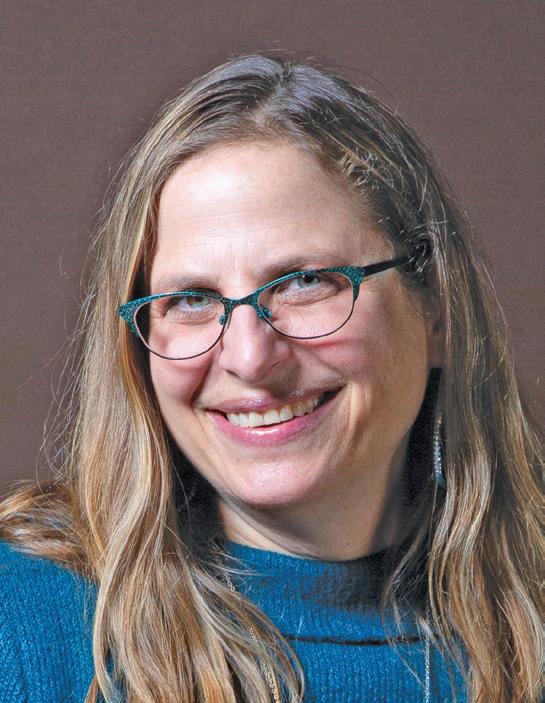
The Not-So-Secret Society of Bay Area Jewish Food Professionals.
Hélène Jawhara Piñer understands that at first mention, a cookbook about matzah and flour might not grab the imagination. After all, she said, matzah has a long-held reputation as the “squared, crunchy, untasty” food we eat on Passover.
But Piñer is an academic who has studied medieval Jewish food culture in Spain and France, and she accepted the challenge of winning over matzah skeptics by writing a historical cookbook about it.
“Most people don’t know how matzah can be so exciting,” she said.
“Matzah and Flour: Recipes from the History of Sephardic Jews” (Academic Studies Press) will bring Piñer to the Bay Area next month for two appearances. On March 5, she will be at the JCCSF at 7 p.m. ($42 includes a copy of the book), and on March 6, she will appear at the Magnes museum in Berkeley at 5:30 p.m. ($20, book sold separately).
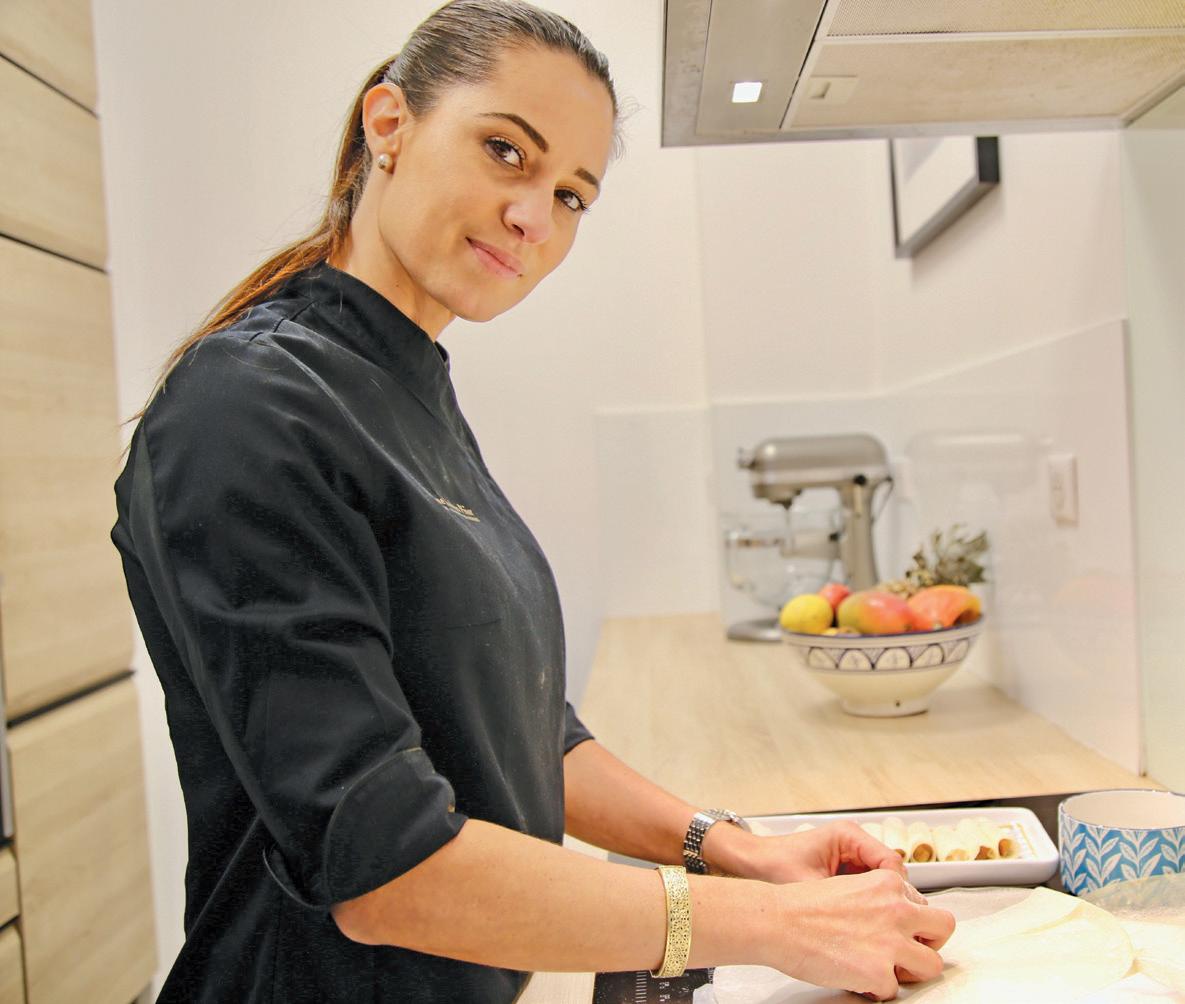
Piñer, 44, who teaches medieval history at Bordeaux Montaigne University and the University of Tours in France, said the idea for the new book grew out of her award-winning “Sephardi: Cooking the History. Recipes of the Jews of Spain and the Diaspora from the 13th Century Until Today.” After it was published four years ago, she was left with many recipes and stories connected to breads and flours that she didn’t have room to include.
She also wanted to expand people’s perceptions of what unleavened bread can be, especially since the term “flour,” at least in Sephardic cooking, can refer to varieties beyond wheat, like chickpea, chestnut, almond and semolina.
“At least for Sephardic Jews, going back to the 15th century, we have so much scientific evidence concerning different unleavened breads they were eating for Passover, but for other holidays, too,” she said.
Piñer’s academic interest in Sephardic Jewry is connected to her interest in her own identity. While she wasn’t raised Jewish, she said she was drawn to Judaism and Jewish people at a young age, and she believes she has Jewish roots on both sides of her family.
Her paternal grandmother’s roots are in Andalucia, Spain, where a Jewish community flourished before the Inquisition. Her grandmother has spoken at length about preparing certain foods for Easter (falling right around Passover), even going so far as to say, “You shouldn’t make this dish with flour, so use chickpea flour.” (Chickpea flour is a common Sephardic ingredient that under Sephardic dietary laws is kosher for Passover.) Her grandmother also prepared special meals for Friday night dinner, without making any reference to Shabbat.
she is “returning” to Judaism.
Piñer had always been fascinated by the connection between food and religion and how they influence each other. Food is also more than just a passing interest in her family; on her mother’s side, most of her relatives are in the food industry in some capacity, as butchers, caterers and chefs.
“I think every job in the food field” is covered, she said. On her father’s side are enthusiasts who just love to eat.
“It’s a great combination of giving me the background in both the technique in cooking, and the practice of eating,” she said.
Piñer’s book is interesting from the get-go. It opens with a recipe for “Ancient Judean Bread,” in which cooked leek, shallot and garlic are kneaded into a flatbread dough. There are also recipes for the breads cited by Moses Maimonides, otherwise known as the Rambam. This Jewish sage had much to say about how to stay healthy, and eating well was part of that.
“Everyone knows of Maimonides as a rabbi and doctor and lawyer, but he was also a dietitian, and his writings about dietary practices were always informed by Jewish dietary laws,” she said.
Also notable is that matzah appears in many holiday recipes that are not for Passover. For example, before the Yom Kippur fast, flour is kneaded with chicken broth to make an unleavened bread to eat with a Spanish chicken soup called puchero. (The recipe is included in the book.)
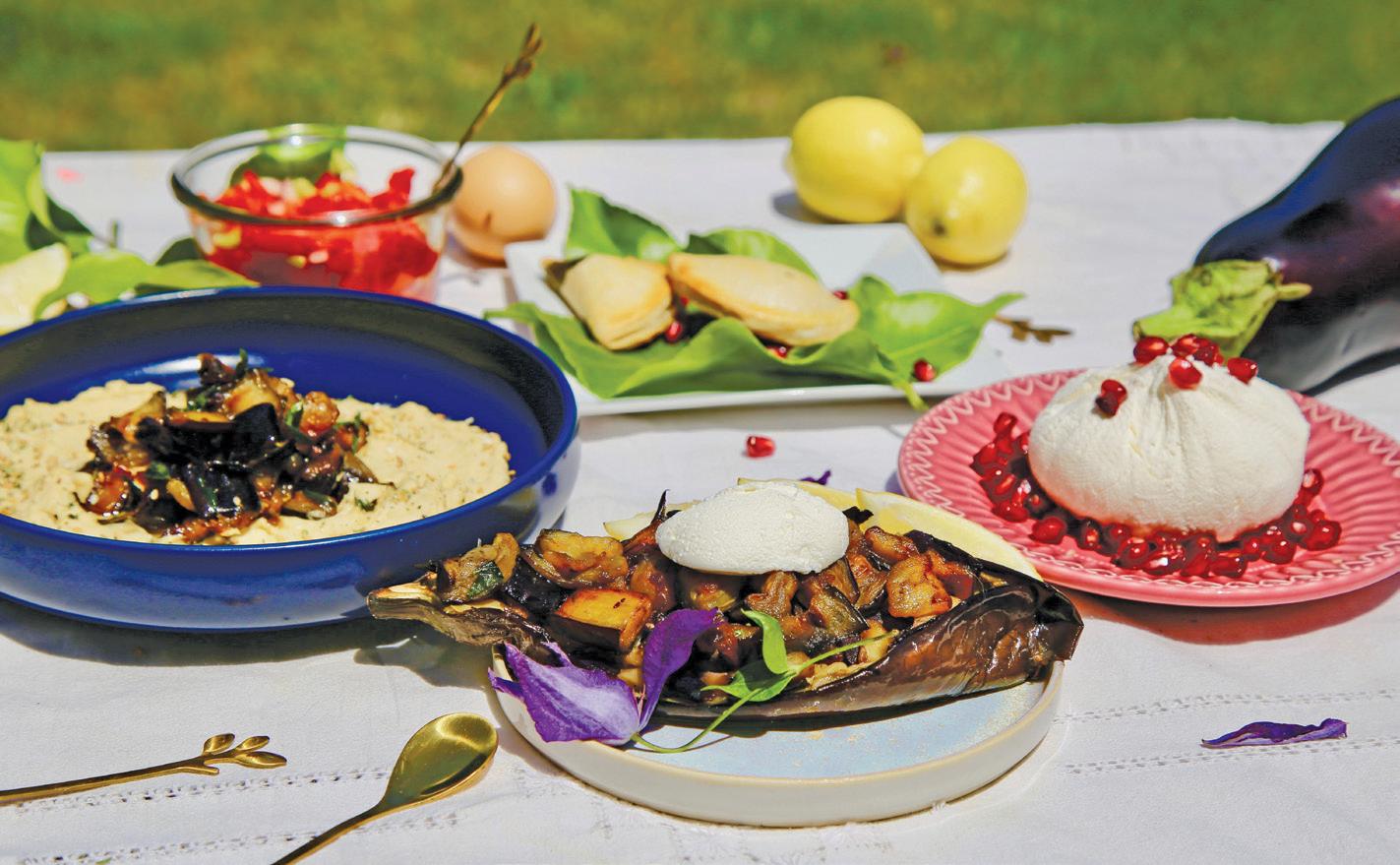
“It’s very bizarre, but quite common,” Piñer said about women of her grandmother’s generation, many of whom follow certain Jewish traditions while seemingly unaware that they are doing so, or of their origins. She has also found variations of her last name in historical records of Inquisition trials of Jews from Brazil and Mexico.
While she prefers to keep specific details about her own Jewish journey private, she said,
Piñer also relied on what’s known as “The Cookbook,” a 13th-century manuscript from Andalucia written in Arabic that is widely considered among the first of its kind. It includes Jewish recipes.
“Matzah and Flour” is full of recipes for mouthwatering
Matzah appears in many holiday recipes that are not for Passover. Before the Yom Kippur fast, flour is kneaded with chicken broth to make an unleavened bread to eat with a Spanish chicken soup called puchero.
dishes that Converso Jews ate, but so many of these dishes have an unfortunate history. What these undercover Jews ate often pointed to their secret origins, and their neighbors would use the clues to report them to the authorities. Many of the recipes’ headnotes tell such a tale.
One example is a delicious and unusual (to Ashkenazi taste buds) sweet soup for Passover called hormiguillos, with milk, honey, almonds and unleavened bread crumbs as its main ingredients. When a woman named Elvira made it for her household during Passover in 1486, one of her servants reported her to the authorities.
“Matzah and Flour” is a cookbook of its time, with abundant and gorgeous photography, and readers are bound to learn something with each recipe headnote. For example, we learn about
a bi er-tasting herb called sow thistle that was used by Andalusian Jews.
In addition to the recipes found in historical sources is a section called “Creations,” which features some of Piñer’s own recipes inspired by Sephardic ingredients, like a date and pomegranate cake for Rosh Hashanah.
“ is book is very important to me because it’s a tribute to our ancestors, and because I’ve heard people say there’s no Sephardic food,” Piñer concluded. “I wanted both of my books to prove the richness of our di erent Sephardic cuisines. ese recipes are not from my grandma, but I found them from historical sources dating back centuries, and this proves that our Sephardic heritage has existed for a very long time.”
Speaking of matzah, J. is holding a recipe contest called Matzah Madness! Surely you have an original recipe you’ve come up with, either to eat during Passover week or to use up extra boxes a er the holiday. Enter your ideas into our contest, and tell your friends. I’ll be teaming up with my cooking colleagues Faith Kramer and Micah Siva to judge your creations, and the winner will receive $250 and the glory of having their recipe shared in J. e deadline to enter at jweekly.com/matzah-madness-contest is March 1.
We’ve wri en about chef Spencer Horovitz and his Jewish pop-up Hadeem a number of times, including in this column on Feb. 7 where we shared that he is a semifi nalist for a James Beard Award in the emerging chef category. e Hi Neighbor Hospitality Group will be hosting Hadeem for two pop-up dinners in San Francisco on Feb. 27 and 28, both with tickets, so purchasers will be guaranteed a seat. (Popular pop-ups like Hadeem o en have long lines.) Tickets for a multiple-course meal are $95, with the opportunity to add specialty cocktails or wine pairings on site. While the menu is in flux, dishes could include cornish hen schnitzel, or guava and dulce de leche babka with burnt cinnamon crème anglaise. Substitutions can be made for vegetarians and pescaterians. Hadeem mixes California and Jewish influences from Horovitz's multicultural Jewish background in Los Angeles.
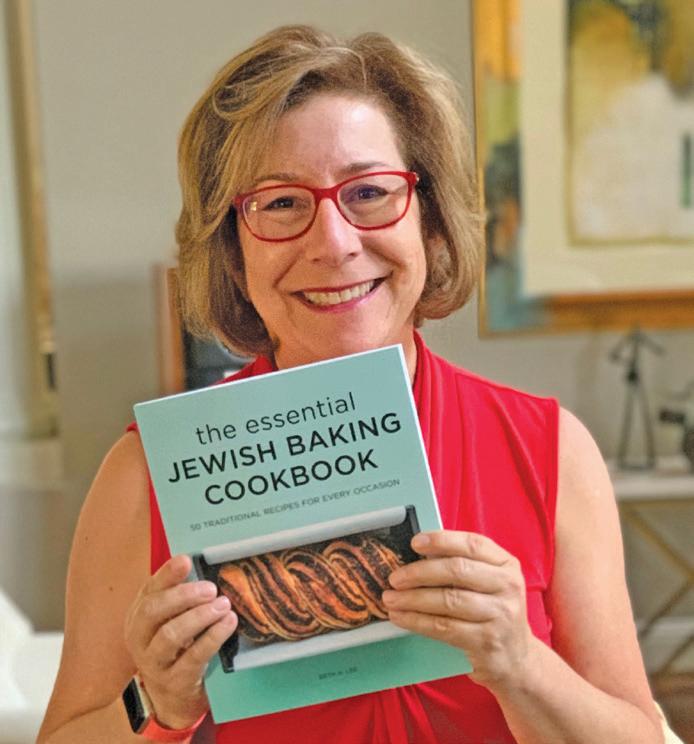
Bay Kosher, the small kosher grocery store in Lafaye e run by Chabad of Lamorinda, recently announced that it has teamed up with Uber to make deliveries of kosher food all around the Bay Area, and as far as Sacramento and Stockton for an additional charge. Fees are listed at baykosher.com/delivery. e market is also piloting a special delivery service to the Peninsula JCC, where people can order online and pick up their groceries in Foster City rather than driving to the East Bay.
We were pleased to see the news in Berkeleyside about the reopening of Homemade Cafe a Berkeley institution owned by Collin Doran that closed with li le warning on Jan. 1. e reopening is due to the intervention of a friendly neighbor, Rohit Singh, owner of the neighboring Breads of India, who is partnering with Doran.
Doran made the sad decision to close when the numbers were no longer adding up. In June 2023, we wrote about his “Everybody Eats” program, in which diners could buy someone in need a breakfast for $5. e initiative drew international a ention. He said the idea came from his Jewish grandfather, who taught him “to never look down on anyone.”
(Note that the mural on the side of his restaurant that featured Magen Davids made from bacon strips is no longer there.)
While some changes will be made to streamline the operation, Doran is just happy to be back in business. Homemade Cafe is at 2454 Sacramento St.
e food blog OMG! Yummy recently marked its 15th anniversary. e blog, subtitled “Recipes from a Multicultural Jewish Kitchen,” was started in 2010 by Jewish food writer and author Beth Lee of San Jose. We wrote about Lee when she published “ e Essential Jewish Baking Cookbook: 50 Traditional Recipes for Every Occasion” in 2021. Mazel tov, Beth!
Tell your L.A. friends: Now they, too, can enjoy Boichik Bagels. Based in Berkeley, Boichik just opened its first L.A. store at 4655 Hollywood Blvd. in the Loz Feliz neighborhood. ■
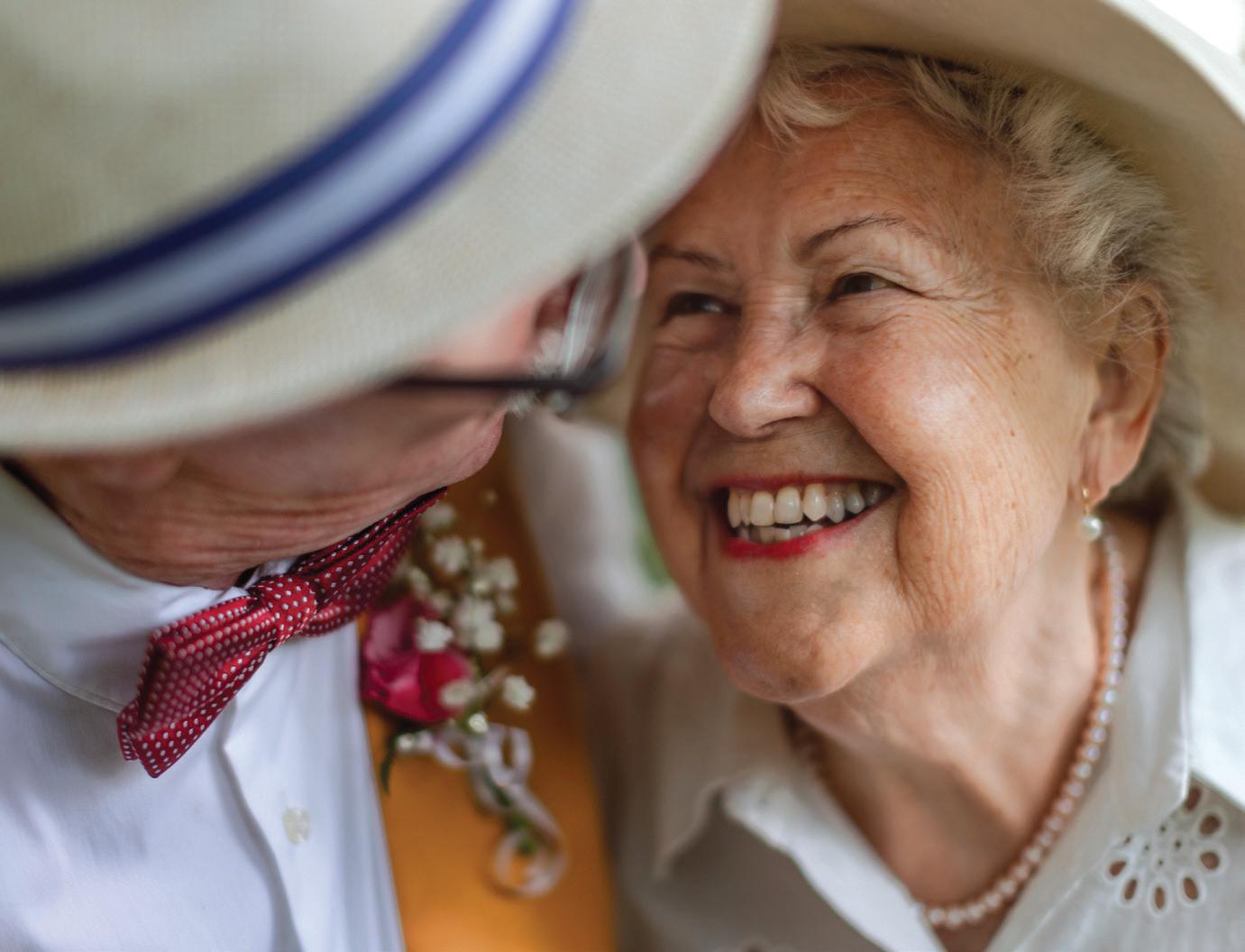
When you’re planning a once-in-a-lifetime celebration, you want an extraordinary experience. One Market is the perfect spot, with Embarcadero and Bay Bridge views, world class fare, experienced and passionate events experts, and venues that will bring your large or small party to life.
Whether it’s a milestone birthday, anniversary or retirement party, bar or bat mitzvah, wedding or rehearsal dinner, together we’ll create an event that’s uniquely tailored to YOU, and memorable for many years to come.
You only have one chance at a one-in-a-lifetime party.
For more information or to book a site visit, contact our events team: 415.777.2233 | events@onemarket.com

NOSH MICAH SIVA

Micah Siva is a registered dietitian, trained chef and cookbook author. She develops modern Jewish recipes inspired by her grandmother, with a plant-forward twist. NoshWithMicah.com
e hamantaschen I grew up with probably aren’t the cookie-based ones you find in a deli case or kosher bakery around Purim. In my family, we feasted on yeasted hamantaschen — pu y and bready, filled with sweet poppyseeds and walnuts, warmed slightly in the microwave and served with a cup of black tea or co ee.
Hamantaschen have a reputation for being dry and bland. But I’ve been on a lifelong mission to share my love and excitement for Purim’s sweet treat. Imagine if a challah and a poppy seed hamantaschen had a baby. Yeasted hamantaschen would be the result. Heartier and less sweet than the cookie variety, they bridge the gap between cookie and bread and are perfect for a holiday breakfast.
Yeasted hamantaschen are thought to be a tradition of the Soviet Union. According to the late Jewish food historian Gil Marks, the original hamantaschen were indeed made using a sweet yeasted dough, but smaller, cookie-based versions won favor because they were easier to work with.
My great-grandmother Freda was born in the former Soviet Union (now Ukraine) and came to Canada with nearly nothing, except for her love of cooking and feeding everyone around her. It’s no surprise that her hamantaschen were sent across Canada and into the U.S. for her family to enjoy, and she passed down those recipes to my grandmother Eva.
While I o en try to modernize classic dishes, some hold such powerful memories and feelings that I want to reconnect with them and go back to my grandmother’s kitchen.
The dough of yeasted hamantaschen is considerably more difficult to work with than its cookie-dough partner. If you’ve ever stressed about getting your hamantaschen to maintain a shape, this may not be the recipe for you. Yeasted dough often has a mind of its own, shapeshifting in the oven. To me, though, the rustic, haimish appearance of the yeasted hamantaschen is part of the charm. It reminds me of my grandmother’s stiff fingers covered in jewelry, kneading, rolling, folding and pinching dozens of hamantaschen for the family, where even the funkiest-shaped outcomes were made with love.
While my grandmother Eva was an avid cook, she also knew when to take shortcuts, “doctoring up” store-bought ingredients so her guests were none the wiser. One ingredient was poppy seed filling. She’d use a canned variety (o en Solo brand, which she’d pick up
from her local Eastern European grocer) and add walnuts, vanilla, citrus zest and a bissel or bit of salt to balance the sweetness. It was her way of adapting her mother’s recipes to the newfound comforts of living in North America.
While I do like to take the hard route, making 90% of my dishes from scratch, I also believe in the power of the shortcut, especially if it makes a dish more accessible. As a parent, I don’t always have the foresight to make and prepare my own poppy seed filling, so I like to keep a stash of Solo poppy seed filling cans in the cupboard. On the occasions when I use them, I miss my grandmother the most.
Makes: 14 to 16 hamantaschen
Total time: 2 hours
Dough:
2 cups all-purpose flour
7 gram package instant yeast
3 Tbs. sugar
1 large egg
⅓ cup warm whole milk
3 Tbs. vegetable oil
1 tsp. orange zest
2 tsp. vanilla extract
¼ tsp. kosher salt
Filling:
½ cup canned poppyseed filling
3 Tbs. finely chopped walnuts
1 tsp. vanilla extract
½ tsp. lemon zest
¼ tsp. kosher salt
Egg wash:
1 large egg, whisked
In the base of a stand mixer fi ed with the dough hook, combine the flour, instant yeast and sugar. Mix to combine.
Add the egg, warm milk, vegetable oil, orange zest, vanilla extract and salt. Mix on low for 6 to 8 minutes, until a smooth dough forms.
Transfer to an oiled bowl, and cover with a lid or plastic wrap. Let rise in a warm place for an hour, until pu y — it will not fully double in size, but should be noticeably larger.




Meanwhile, combine the poppy seed filling, walnuts, vanilla, lemon zest and salt in a medium bowl.
Line two baking trays with parchment paper.
Once the dough has risen, roll it into a ¼-inch thickness. Use a 3-inch biscuit cu er or round cookie cu er. Re-roll dough scraps until you have no more dough. You should end up with 12 to 14 circles.
Use a rolling pin to reshape the dough as needed, as it might shrink or get misshapen.
In a small bowl, beat the egg with a pastry brush.


Place 1 tsp. of filling in the center of each circle. Brush the egg around the dough, and fold into a triangle, pinching the edges to seal. Transfer to the lined baking trays, with 2 inches between each hamantaschen. Cover lightly with plastic wrap, and let rise for 30 minutes.
Preheat the oven to 375 degrees. Bake the hamantaschen for 11-13 minutes, or until just golden. Let cool for five minutes on the tray before transferring to a wire rack. ■
continued from page 3
Chadeish Yameinu in Santa Cruz. California as a whole has a major footprint, home to a fifth of all Aleph-affiliated Renewal communities in the country.
In an interview, Aleph executive director SooJi Min-Maranda described the Bay Area Renewal congregations as “flagship communities” and Aquarian Minyan as “ground zero for Renewal.”
Along with the congregations formally affiliated with Aleph are fledgling communities that Aleph advises. “New communities are starting all the time. Almost every month
then when they wanted [a different] community they came to Kehilla,” he said. “And Kehilla is sometimes a funnel to Chochmat. I always love it when people find a synagogue that meets their needs.”
Kehilla also “spawned Afikomen,” the Judaica shop and bookstore in Berkeley where Cooper once worked, he said. And he and Rabbi Stu Kelman, founding rabbi of Berkeley Conservative Congregation Netivot Shalom, spearheaded the creation of Gan Yarok in Marin, the nation’s first green Jewish cemetery.
“We are not an insular community,”
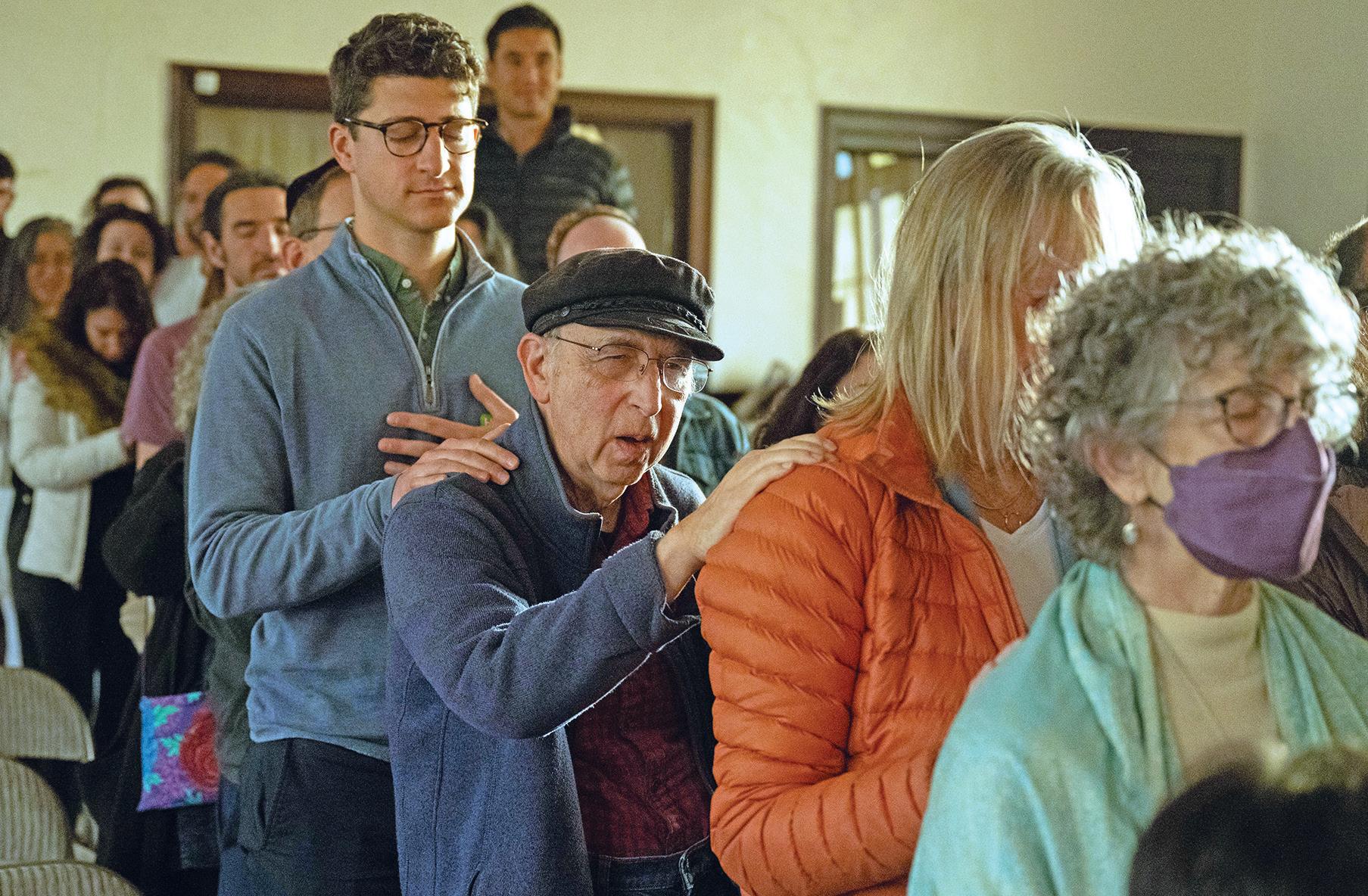
I get a call,” said Min-Maranda, who on that very morning heard from a new havurah, or prayer community, in Hood River, Oregon.
Aleph has produced 220 rabbis since the formal ordination program was established in 2000, in addition to 34 cantors, 38 rabbinic pastors and 91 spiritual directors.
Rabbi David Cooper, the former spiritual leader at Kehilla in Piedmont, estimates that “15 to 20” Renewal rabbis live in the Bay Area. Not all were ordained by Aleph; some went to other rabbinical seminaries and now identify as Renewal, and some of the older rabbis received direct smicha from Schachter-Shalomi.
Cooper remembers moving to the Bay Area in 1976 and spending Kol Nidre at the House of Love and Prayer, a San Francisco community founded by Rabbi Shlomo Carlebach, who, like Schachter-Shalomi, was a former Chabad emissary.
“On Yom Kippur Day I went to the Aquarian Minyan, and Reb Zalman was leading the service,” Cooper said.
Today the East Bay Renewal communities have a symbiotic relationship, Cooper said. “We had quite a few people turned on to their Judaism through Beyt Tikkun, and
Cooper noted. “You find Renewal-oriented folks in many places.”
The two newest local Renewal rabbis have strong Jewish backgrounds and have been filling functions often thought of as rabbinic for many years.
Hurvich, 56, grew up in Mill Valley, where her family belonged to Conservative Congregation Kol Shofar in nearby Tiburon, but “I had a real boundary-crossing family,” she said. On some Saturdays her father would take her to the Shabbos Shul, led by the “rock ’n’ roll brothers” in a church basement. And the family spent vacations with his Orthodox, kosher-keeping family in Alabama.
When it was time for her bat mitzvah, she refused, saying it wasn’t meaningful to her. But she kept up with a teen group that met weekly with the rabbi “to talk about Jewish values and research on animals or space exploration.” She marked her bat mitzvah after high school and said her rabbi set her on the path to becoming a Jewish educator “because he took me seriously.”
After receiving a master’s degree in art, Jewish art and material culture from the Conservative movement’s Jewish Theological Seminary in New York, she returned to the
Bay Area in 1999. She has since compiled an impressive resume in Jewish education, including stints as community liaison at the Contemporary Jewish Museum and the JCC of San Francisco, and director of Kehilla’s Hebrew school. Today she continues to prepare b’nai mitzvah students and is a freelance Jewish artist and ritual leader.
So why rabbinic ordination, and why now?
“I remember thinking when I was still in college, I’m a Jewish woman at the end of the 20th century in America, and I don’t define myself through the Holocaust. I’m part of that pivot generation. I thought, what can I do that will have the most impact?” she said. “I know, I thought: I’m going to be a rabbi.”
It took her 30 years. She got married, had a baby and spent a decade running the religious school at Kehilla. It derailed her from that goal, she said, but she “didn’t lose the fire.”
Receiving ordination has changed her life, she said. “I feel different. It’s like marrying someone you already lived with. The ceremony felt like a veil was being lifted.”
Krieger has likewise been filling a rabbinic function without the title for years, notably the past three when he has served Chochmat HaLev as its part-time spiritual leader.
People who meet Krieger for the first time might find it hard to believe he grew up haredi, or ultra-Orthodox. It’s not just the piercings and the long hair. It’s the total package.
At his congregational welcome on Jan. 25, the 41-year-old told the 150 people gathered in the sanctuary that he “resisted the calling” to become a rabbi for many years, both because of the “hierarchical implications” and because he was “uncomfortable with this model of rabbi being ‘symbolic exemplar,’ the idea that people expect their rabbi to be the paradigm of perfection.”
Instead, he continued with a grin, “I can be a Shabbat-observing, neo-Hasidic, mysticism-loving, queer, body-positive, tech bro, single dad, ADHD, Enneagram 7, surfer, [Burning Man] Burner, meditator, ecstatic dancer, and everything else that goes into the soup of what makes me, me.”
Krieger is a whirling ball of energy. After getting his bachelor’s degree from Yale in 2006, he spent almost a decade in
journalism, covering the Arab world for Newsweek and serving as foreign policy correspondent for the Atlantic, among others.
Government work followed, including postings at the Pentagon, the World Economic Forum and the State Department, where he served as that body’s first-ever “ambassador to Silicon Valley,” working with the tech sector on emerging technologies. He has taught design, technology and social impact at Stanford and UC Berkeley, and most recently has advised tech and social media companies including Meta and TikTok on “responsible innovation” strategies to mitigate potential harm caused by their products.
In contrast to many who leave the ultra-Orthodox world, Krieger looks back at it fondly. He’s grateful for the years of Jewish learning, which give him a facility with Jewish texts not always available to new (or old) rabbis without that background.
As the years passed, he knew he wanted to do Jewish communal work but couldn’t envision a path to the rabbinate. What seminary would admit him? Where would he feel at home? In 2014 he heard about Jewish Renewal for the first time when he read Schachter-Shalomi’s obituary in the New York Times.
“I remember thinking, ‘Who is this guy who grew up Orthodox and was a Chabad rabbi but also dropped acid with Timothy Leary and is into singing and dancing and meditation and is egalitarian and pro-LGBTQ and cares about the environment and social justice?’” he told J. “If he could be a rabbi, perhaps I could be too.”
Now a rabbi, he continues to work part time in responsible innovation at social media companies, mostly TikTok, and is raising his 10-year-old son.
“I think the Bay Area has the richest Jewish community in the country,” Krieger said. “Even the institutions in the East Bay are great, and the mainline synagogues are, I’d say, some of the best synagogues of their denominations. Then you have so much entrepreneurial Judaism and creativity, and the fact that the communities get along so well with each other.
“Many of the innovations that happen here, just kind of radiate outward into the country. I feel just thrilled to be here!” n
“We had quite a few people turned on to their Judaism through Beyt Tikkun, and then when they wanted a different community they came to Kehilla. And Kehilla is sometimes a funnel to Chochmat. I always love it when people find a synagogue that meets their needs.”

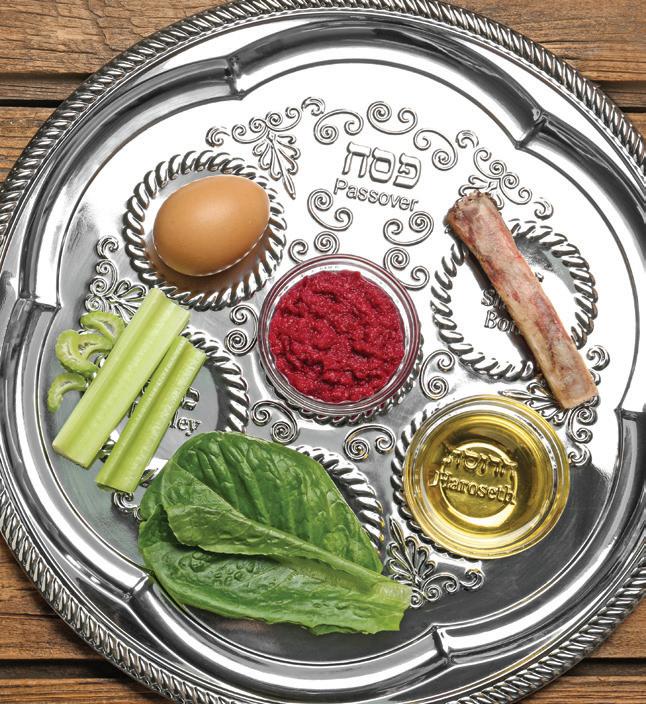


This moment calls for sadness. So how come I am so filled with rage?
Yarden Bibas, 35, was freed on Feb. 1 along with two other hostages held by Hamas. But he returned without his family.
Now Hamas is sending the corpses of his wife and two sons home, and the world must seethe over their deaths: Shiri Bibas, 34, Ariel, 5, and Kfir, 2.
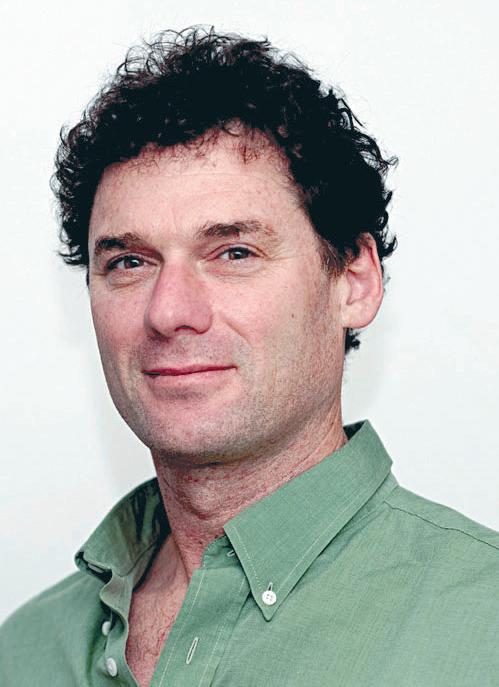
Rob Eshman is a senior columnist for the Forward based in Southern California. Follow him on Instagram @foodaism and Twitter @foodaism or email him eshman@forward.com. This article was originally published in the Forward and is reprinted with permission.
I’m seething. I’m enraged at Hamas. Its leaders and so-called soldiers bear 100% of the guilt for the unimaginable suffering of every hostage, and the deaths of the hostages who have died since Oct. 7. It was Hamas who planned and executed that massacre, and we know from materials captured by the IDF that those plans included the taking of civilian hostages in order to trade for Palestinian prisoners in Israeli jails.
That’s why Hamas terrorists attacked Kibbutz Nir Oz in the first place. And why, when Yarden Bibas and his family hid together in the safe room, Hamas used drilling equipment it had brought to break in. The terrorists murdered Shiri’s parents, Margit Shnaider Silberman and Yosi Silberman, and even the Bibas family dog.
Terrorizing civilians wasn’t an accident of this battle. It was the strategy. Taking a baby less than a year old — as Kfir, the youngest hostage, was at the time — was part of the plan. No matter who you are, that should chill and enrage you.
“Kfir and Ariel aren’t enemies of Hamas,” Jimmy Miller, Shiri’s cousin, said last year when Kfir turned 1 in captivity. “The world is creating a legal precedent that allows the abduction of babies from their land, from their homes.”
I’m also furious at Israeli Prime Minister Benjamin Netanyahu. I know some people may object that this pulls focus from the real perpetrators, but I refuse to absolve him of his share in this tragedy.
For years, Netanyahu allowed millions in Qatari cash to flow into Gaza, propping up Hamas, because doing so advanced his aim of undermining the Palestinian Authority. He plunged the country into civil chaos by pushing a judicial overhaul that was a naked attempt to stay in power,
giving Hamas the perfect opportunity to attack an Israel weakened by internal strife.
He kept the war in Gaza going beyond what his own generals said made strategic sense. His scorchedearth strategy, which resulted in massive civilian death and destruction, failed in its avowed aim to destroy Hamas. That strategy prolonged the suffering of the hostages who have survived, and made it more and more likely that many of them would die.
The Kahanist Knesset members Netanyahu brought into his cabinet boasted of rejecting previous hostage deals — deals that could have helped the Bibas family return home before this grievous moment. And to this day, Netanyahu has thwarted every attempt to launch an independent investigation into Oct. 7 so that those responsible will be held accountable and future families won’t face the agonies of the Bibases.
He is a reverse Moses, who has brought plague after plague on his own people.
I’m angry at Israel’s knee-jerk American supporters. The people who never saw fit to speak against a government gone mad, one that’s unrecognizable to those who support a secular, peace-seeking state for Jews and all its citizens. They have helped, with their silence, to enable Netanyahu as he has sowed division at home and terror in the West Bank.
And if this crowd dares to use the Bibas family’s pain — especially now, as it celebrates the return of one loved one, while mourning for others — as a reason to further oppress, occupy and terrorize Palestinians, they will be sealing the doom of Israel’s democracy.
I’m also livid at those pro-Palestinian protesters who have justified Hamas. Since Oct. 7, we have seen them on college campuses and in public squares, echoing Hamas’ demand to eliminate Israel. All I can say to them is: Are you happy? Those who were celebrating on Oct. 8, 2023 — can you not see where terror leads? To the destroyed lives of children, on every side?
Your breathtaking self-certainty undoubtedly encouraged Hamas. Instead of saying, as many brave Palestinians did,
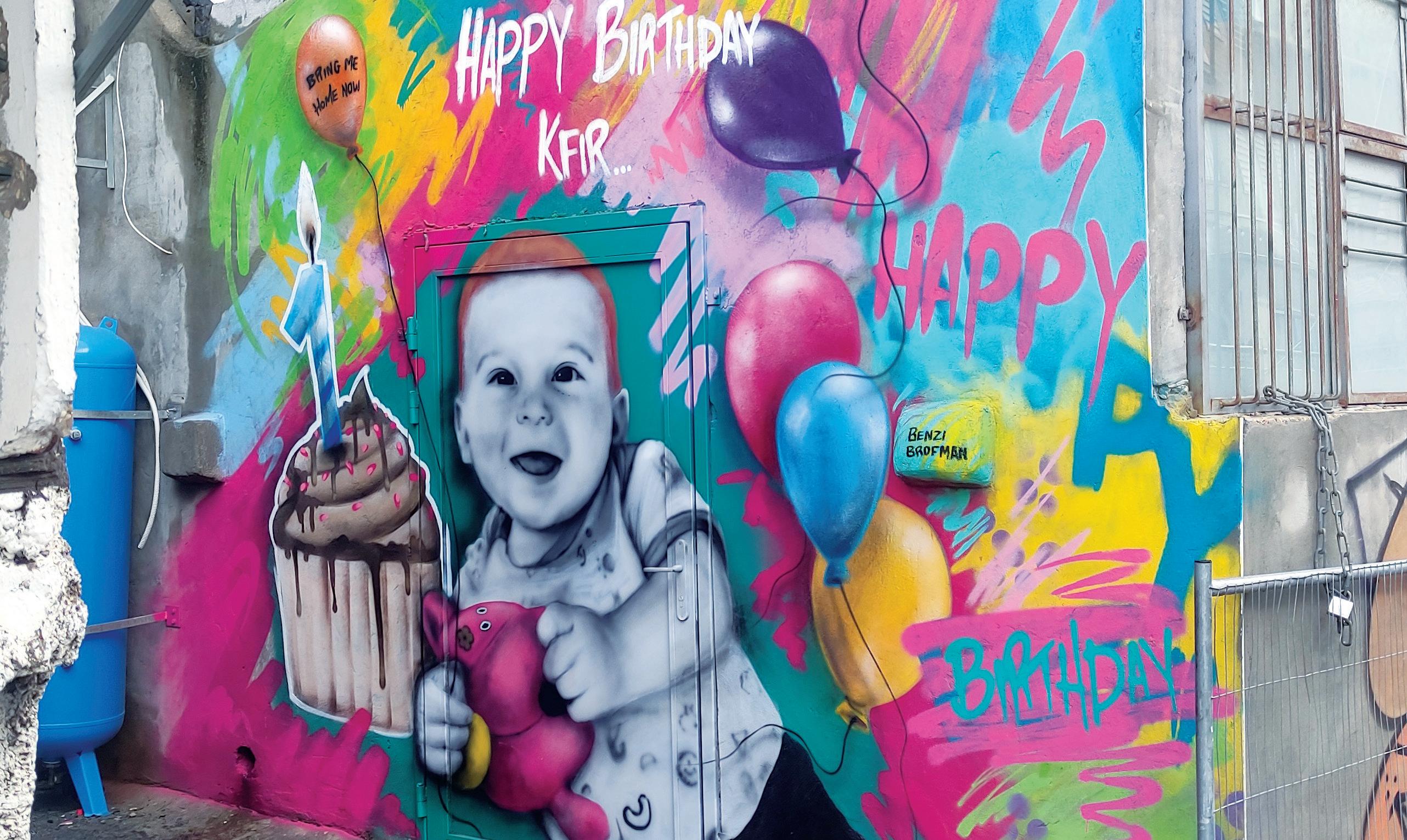
that the hostages needed to be released, and that taking the Bibas children hostage fouled the Palestinian cause, you donned retro-Guevara wear and helped suggest that further slaughter would be, if not actively endorsed, at the very least overlooked by the global le .
And do not dare cite body counts of children killed by Israel in Gaza in response to agony over the Bibas children. Each young life marred or taken by war is a unique tragedy: Palestinian or Israeli; Jewish, Muslim or Christian.
ere are, to be sure, heroes in this sad story, and to calm my anger, I look to them.
e Bibas family, which has endured

the unendurable with steadfastness and grace — including in a Jan. 31 statement that welcomed Yarden’s imminent release, while striking a grave note in admi ing they were “facing very complex days” ahead.
e hostage families, and others who have stood by and supported them and fought tirelessly for the captives’ freedom.
Former President Joe Biden and President Donald Trump and their diplomatic teams, who put aside di erences to finalize the deal that has freed many of the remaining hostages and will, if seen to completion, see all of them — living and dead — returned to Israel.

e Israelis and Palestinians who join together to reject murder and kidnapping as a legitimate tactic and work toward a shared future in the land.
We have seen this week what the awful
alternative is.
On my bookshelf, staring down at me as I write every column, is the spine of Serge Klarsfeld’s “French Children of the Holocaust,” his exhaustive 1983 compilation of the names and faces of 2,500 children deported and put to death in the Nazi camps. Klarsfeld spent some 20 years collecting the documentary evidence for the book, and photos of each child, all under age 18. He gave each one his or her own page, a final act of resistance to the Nazis who sought to obliterate whole families, their documents and any record of their existence, including by killing at least 11,400 French children.
As I stare up at the book, it is too easy to imagine the faces of Ariel and Kfir Bibas among those of the Nazis’ young French victims, two more innocents destroyed by a genocidal campaign.
It is imperative that their story be remembered, and repeated. My prayer is that their family may find comfort and that the rage we feel at their fate will lead us to fight, in their memory, for peace. ■




Robin Raphael and Jack Simke of Burlingame, and Julie and John DeRubes of San Diego, are very pleased to announce the marriage of their children, ARIELLA SIMKE and BRIAN DERUBES, at Monastery Beach in Carmel on Oct. 27, 2024, with Brian’s father, John, o iciating. Ariella is a senior editor at Scuba Diving magazine, and Brian owns Monterey Expeditions, a local adventure and guide company. Brian will be known as Brian John-DeRubes Simke. The couple will continue to reside in Monterey with their two cats.

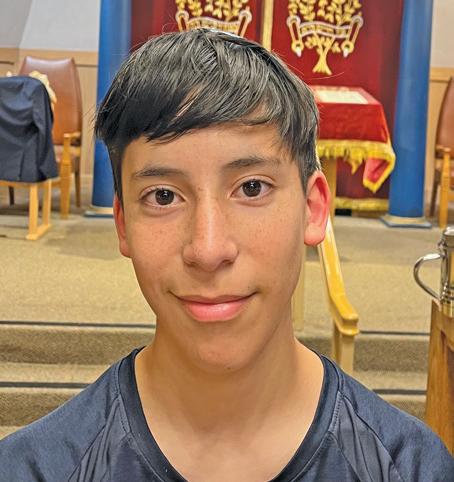
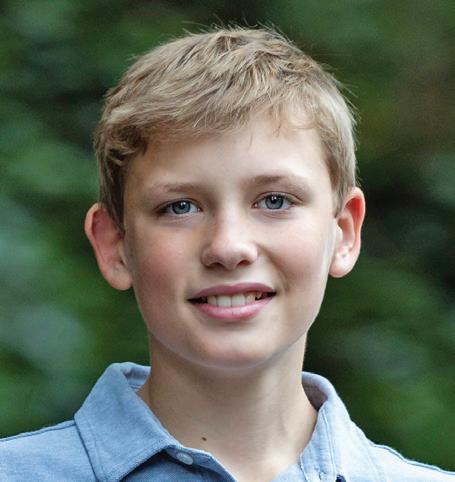
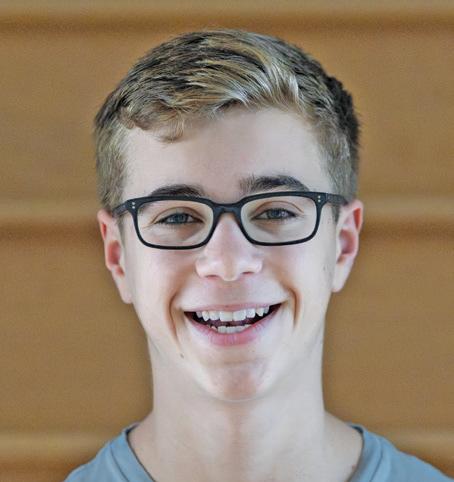
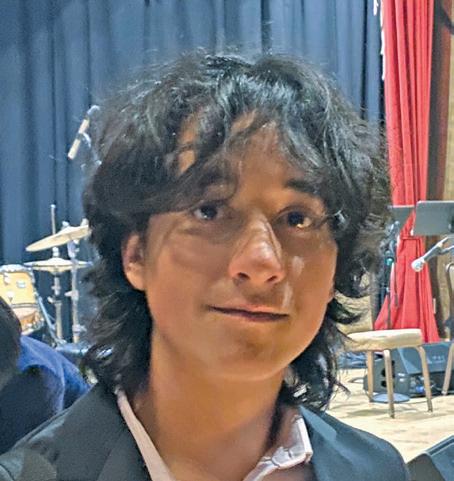

The Obituaries section is supported by a generous grant from Sinai Memorial Chapel, sinaichapel.org
ELLEN CAROL BENJAMIN
April 30, 1950–Dec. 1, 2024
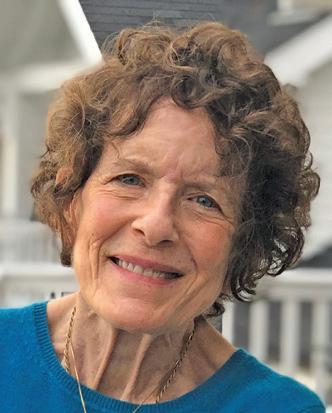
Ellen Carol (née Ecker) Benjamin, age 74, passed away on Dec. 1, 2024, in San Francisco following a long illness.
She was surrounded by her loving family, her husband, Jon Benjamin, and her stepchildren, Chloe Benjamin (Nathan Jandl) and Jordan Benjamin, along with her care team at Rhoda Goldman Plaza. She is survived by her mother, Geraldine Ecker, sister, Karen Yasgoor, brother-in-law, Stuart Yasgoor, and nephew, Justin Yasgoor. She was predeceased by her father, Gerald Ecker, and grandparents, Joseph and Ruth Radlow and Jack and Betty Ecker.
Ellen was born and raised in Lorain, Ohio. She graduated from Admiral King High School (1968) and Kent State University (1972) before receiving a Master’s Degree in Communications from Bowling Green University (1974). Ellen had a successful career in HR and development with organizations
such as UnitedHealthcare, the San Francisco Ballet, and the SF Symphony. Trips to Europe and Israel reignited Ellen’s connection to Judaism, and she returned home to become a Bat Mitzvah at Congregation Emanu-El in San Francisco. Rabbi Cohn’s formation of the Spiritual Institute of Temple Emanu-El (SITE) led to Ellen’s work as a spiritual director and to her most treasured friendships. In 2010, Ellen studied for and received two certifications: one in individual spiritual direction from the Mercy Center in Burlingame and the second in group spiritual direction in a Jewish context. She led both individual and group meetings for over twelve years, inspiring and guiding women, including those who had recently converted to Judaism. She led her groups with love, music, and wisdom, and she will be remembered for her gracious spirit.
Ellen’s dedication to her family and religion became the heart of her life. Jon and Ellen built a vibrant, devoted partnership that spanned thirty years. She assumed the mantle of spouse and stepparent wholeheartedly, and her generosity took infinite forms, from maintaining their beautiful home life to caring conversations to acts of lovingkindness. She had many relatives
and friends — too long a list to mention here — who loved Ellen’s beaming smile, energy, and wisdom. She loved to travel with Jon, their family, and friends, with particular fondness for Mendocino, Hawaii, France, and Italy.
In addition to her synagogue commitments, Ellen was a docent at San Francisco’s Contemporary Jewish Museum, where she led tours with curiosity and enthusiasm — and, as her memory began to be impacted by Lewy Body dementia, with distinct bravery. Ellen felt injustice deeply and was motivated to make the world a better place. After losing a dear family member, Claire Cucchiari Loring, to domestic violence, Ellen joined the board of Shalom Bayit, where she served for ten years. Ellen’s kindness and compassion knew no bounds. Her sparkling laugh will ring forever in the minds of those who loved her.
A memorial will be held on Sunday, March 16, at 2 p.m. at Congregation Emanu-El. For more information, please contact Jon Benjamin at jonbenjamn@aol.com.
May Ellen’s life be a blessing for all who knew her. If you would like to honor Ellen’s life, please make a donation in her memory to any of the following organizations.
Shalom Bayit shalom-bayit.org
Social Good Fund/Shalom Bayit P.O. Box 2883, Berkeley, CA 94702
Lewy Body Dementia Association lbda.org/donate 912 Killian Hill Rd. SW, Ste. 105 Lilburn, GA 30047
Memory Care, Rhoda Goldman Terraces jfcs.org
Jewish Family and Children’s Services P.O. Box 159004, San Francisco, CA 94115

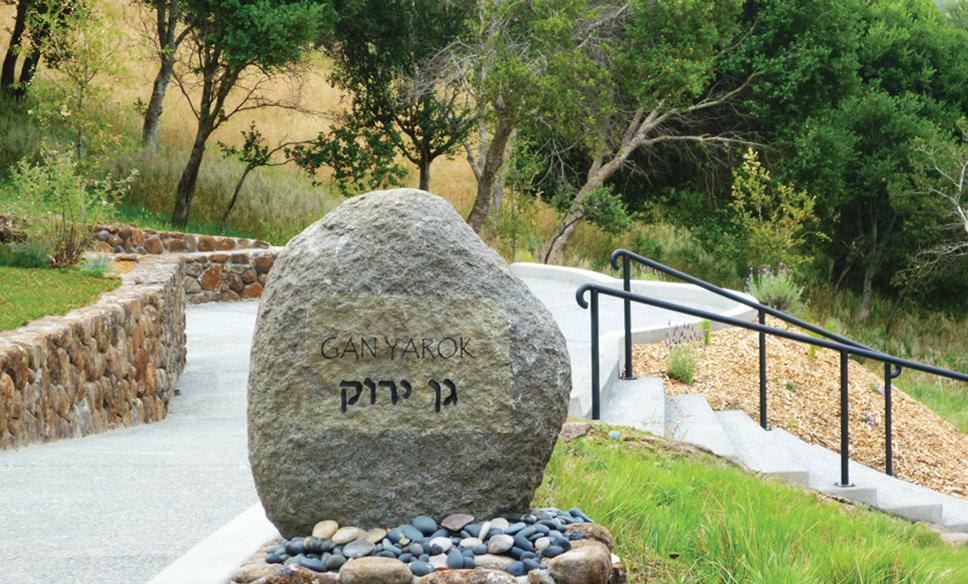



MAYA MIRSKY | J. STAFF
The year was 1934.
That was the year Hitler purged his enemies from his own party and took complete control of it. That was the year the president of Germany died, leading Hitler to abolish the office and declare himself Führer, or in other words, dictator.
Fascism in Germany was swelling like a wave.
But it wasn’t only in Europe that fascism was broached. Jews in America were deeply concerned about whether fascist ideology could spread here.
Robert Bradon wrote an essay for this paper in September 1934 headlined “Fascism Threatens America.” In it, he issued a wake-up call to American Jews to take the potential of fascism in the U.S. seriously.
“What has occurred in Germany with the coming to power of Hitler has centered world attention on the political philosophy of Fascism. The Jews have had special concern in the terroristic phase of Fascism — for in Germany, in Poland and elsewhere, the Jews have been one of the minorities most severely affected,” he wrote.
“That Fascism might spread to America

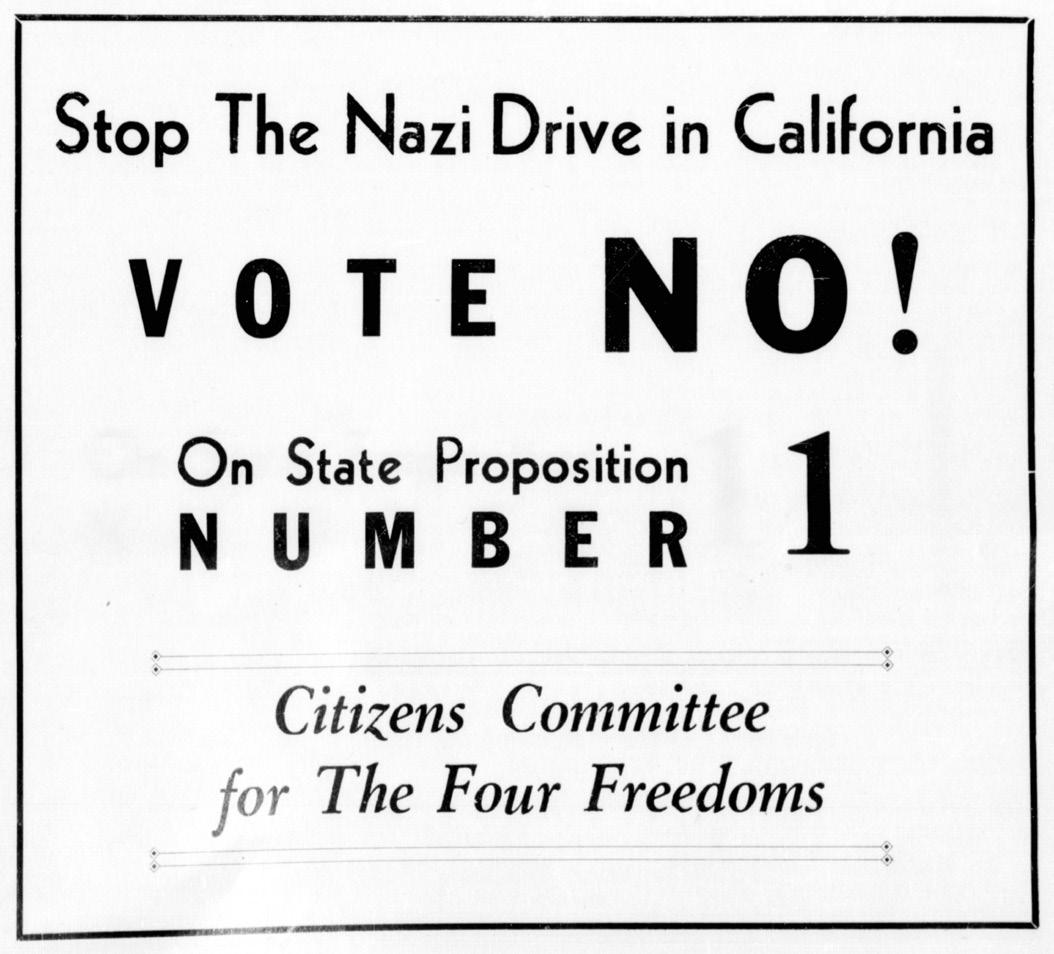

is a threat no thoughtful citizen can ignore. Fascism takes different forms in different nations. But the principle remains the same. It is the terroristic rule by the most reactionary section of financial capitalism to preserve the benefits of the few at the expense of the broad masses — the workers, the liberals, the intellectuals, the minority racial and political groups. Democratic pretense is discarded: terror, repression are the instruments of Fascist dictatorship.”
Jews, including the readers of this paper, knew that the situation was bad in Germany long before Kristallnacht in 1938, before the race laws of 1935 or even before the boycott of Jewish-sold goods in 1933.
At the beginning of 1932, this paper was already calling out the “Hitler menace” and the dangers of antisemitic attacks at the University of Berlin. So by 1934, the danger was clear.
But this wasn’t only about Europe. Bradon was particularly concerned about what would happen if fascism spread to the U.S. It wasn’t an impossibility.
“The threat of Fascism to America is increasingly great. Our political orientation has become dangerously nationalistic. Organizations with frankly anti-Semitic, anti-Catholic, anti-negro biases spring up throughout the country — witness the Silver Shirts, the Khaki Shirts, etc. And in California, Fascism already has roped off the Imperial Valley as its special province.”
Bradon was most likely talking about the Associated Farmers of California, an anti-labor group that coalesced in the state’s inland agricultural regions. While not overtly
fascist, many historians consider it to have had fascist leanings.
The Silver Shirts were a pro-Nazi group based in the U.S. There was even a local following. In 1933, Raymond Dannenbaum infiltrated the San Francisco branch for our paper and delivered a mocking exposé headlined “Hate for Sale.” (The second segment was titled “Any ‘Good’ American Citizen Can Become A Silver Shirt Bigot By Paying $10
“That Fascism might spread to America is a threat no thoughtful citizen can ignore.”
Robert Bradon, September 1934
and Disclosing the Amount of His Bank Account.”)
“There is hate for sale in the Whitney Building here,” he wrote in the first segment.
“In a one-room bookshop, suggestively called ‘The Aloha,’ nestling among the appropriate sentiments about universal love and good will … should you be willing to contribute 15 cents more to the ‘war chest’ of American anti-Semites, you can purchase a charming pamphlet: ‘The Cause of Anti-Jewism in the United States.’”
Dannenbaum continued:
“For nothing, Mrs. Meyer, the attendant, will give you one of her sweetest smiles (if your nose is not too conspicuous) and a copy of a brochure: ‘Declaration of the Principles
of the Silver Shirts of America.’”
According to Bradon, fascism and its bigotry were ways to divert Americans from real problems, at the expense of minorities.
“The radicals and liberals, the pacifists and intellectuals — all threats to the Fascists — will suffer immediately. And along with them, the Jews and Catholics, the Negroes and Japanese, and the religious and racial minorities that will logically feel the brunt of the Fascist terror. They are the potential scapegoats in America.”
He focused in particular on how Jews would fare under a fascist government and appealed to a Jewish understanding of the unique place of America in world history.
“The Jew is threatened by racial prejudice: but he is also threatened as an American. Our valued liberty, which attracted the Jews first to this country, vanishes. And not only the liberty of the Jews, but the liberty of all citizens,” he wrote.
“If we believe in true liberty of thought, of action, of belief, we abhor Fascism, not only as Jews, but as Americans. The Jew values his Americanism: he should stand with all other sincere Americans in the battle against the Fascist forces.”
Bradon concluded by appealing to the Jewish sense of history and self:
“The Jew, historically a rebel, a lover of liberty, must again affirm his traditions by active resistance to the blight of Fascism.” n

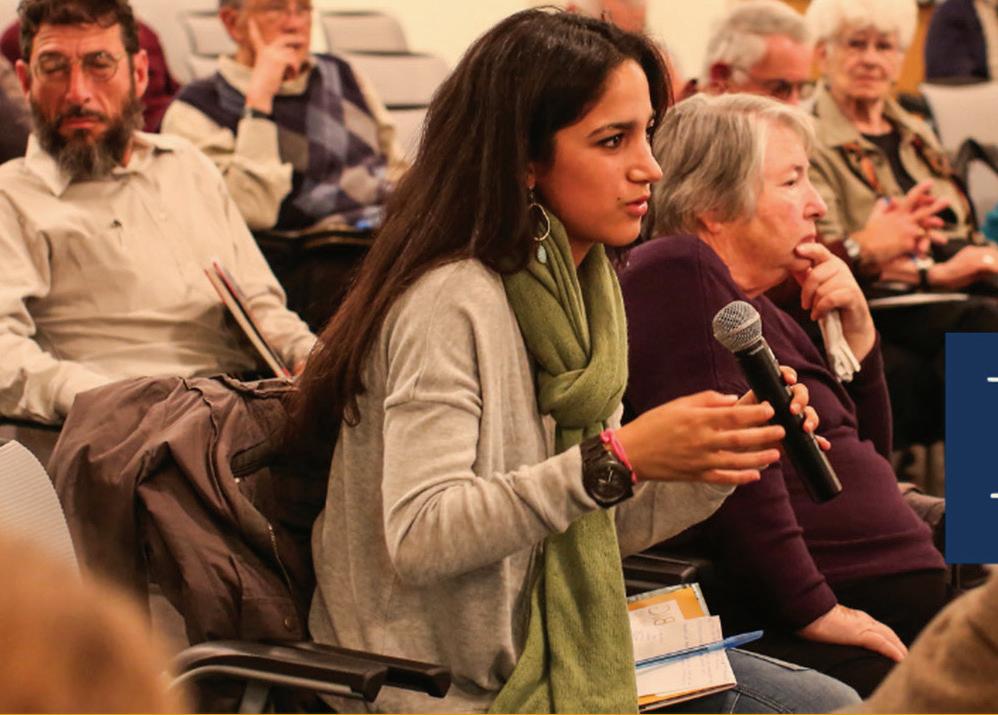

Complexity Welcome.
MONDAY, MARCH 10, 4–5:30 PM PT, ROOM 141, BERKELEY LAW BUILDING
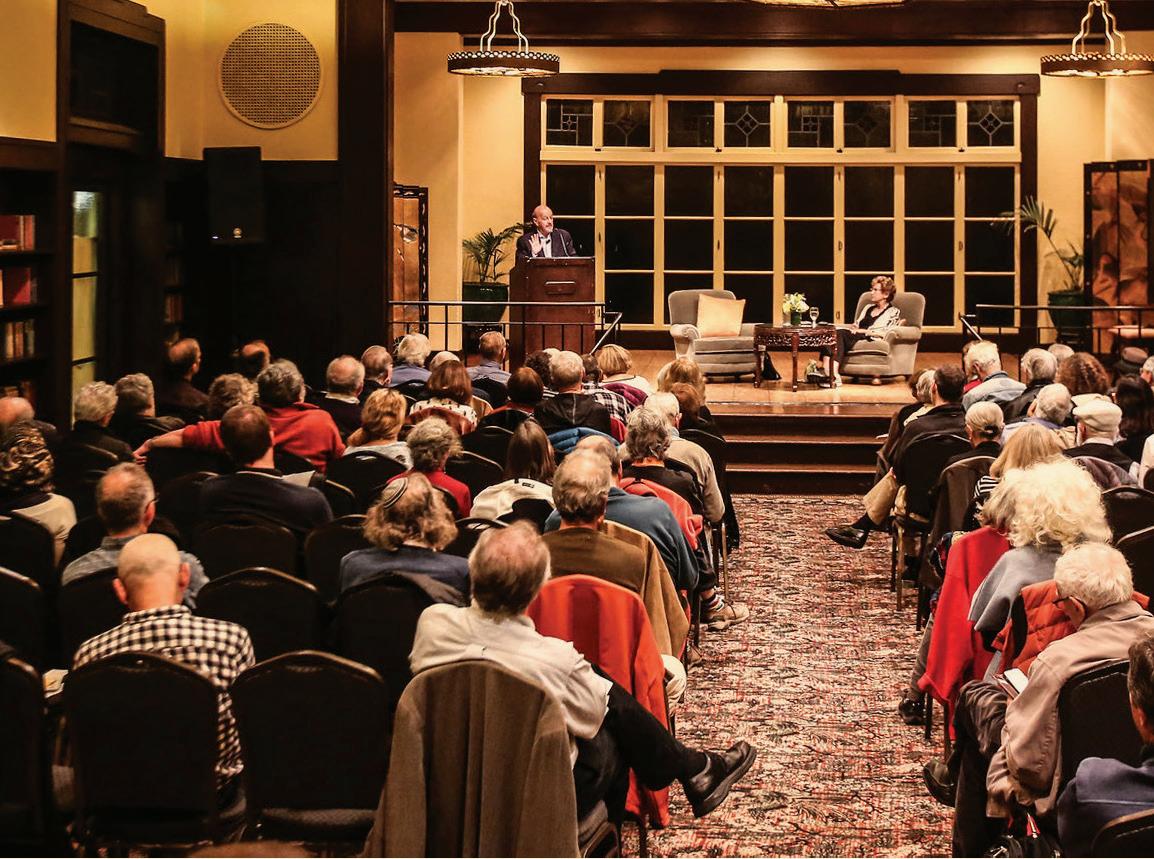
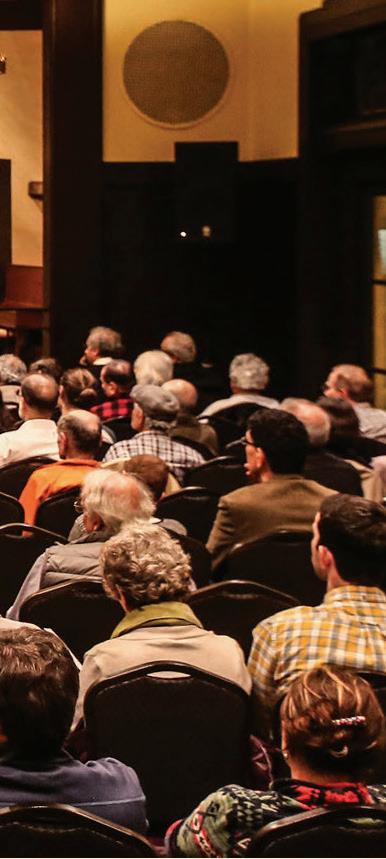
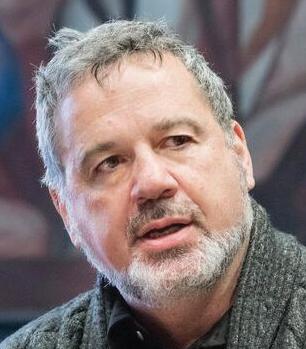
In this book talk, historian Oz Frankel examines the period of the late 1960s as a unique moment when Israel became more closely entwined with the United States not just as a strategic ally but also through its intensifying intimacy with American culture, society, and technology. Taking an expansive view of Israeli–American encounters, historian Oz Frankel reveals their often unexpected consequences, including, for example, the ripple effects that the rise of Black Power had on both extremes of Israeli politics. Purchase the book here.
Introduction by Professor Emeritus of History, Sheldon Rothblatt. Hosted by the Helen Diller Institute and the Center for Jewish Studies. Cosponsored with The Magnes Collection of Jewish Art and Life, the Department of History, and the Department of American Studies at UC Berkeley.
A light reception begins directly after the lecture in the front courtyard of Freehouse Berkeley, 2700 Bancroft Way, Berkeley, CA 94704.
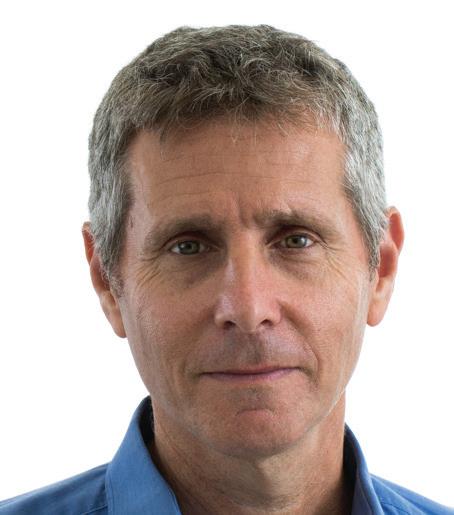
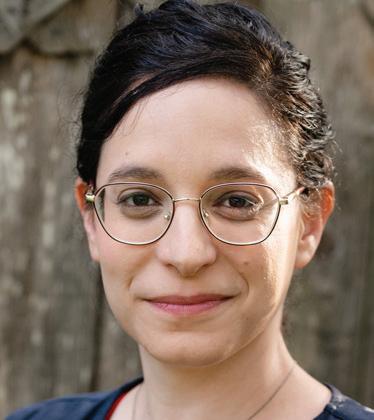
Yuval Shany, Hersch Lauterpacht Chair in International Law, Former Dean, Law Faculty of the Hebrew University of Jerusalem; Former Member, Chair, UN Human Rights Committee
Register: ozfrankel.rsvpify.com
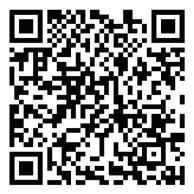
5TH ANNUAL LIBITZKY LECTURE ON ISRAEL AND THE GREAT POWERS AT THE HELEN DILLER INSTITUTE
Masua Sagiv (MODERATOR), Koret Visiting Assistant Professor of Jewish and Israel Studies at UC Berkeley (2021–2025); Senior Faculty, Shalom Hartman Institute; Researcher at the Menomadin Center for Jewish and Democratic Law, Bar-Ilan University Law Faculty
WEDNESDAY, MARCH 12, 6–7:30 PM PT, ROOM 105, BERKELEY LAW BUILDING
How should we understand Israel’s complicated relationship with the United Nations? Please join Yuval Shany (Former Member and Chair of the UN Human Rights Committee) and Masua Sagiv (Koret Visiting Professor at HDI) for a frank discussion about the complexities and nuances of Israel’s current and historical relationship with the world’s preeminent international body. This is the fifth in a series of talks examining Israel’s relationships with global powers. Prior talks have explored Israel’s relationship with China, Russia, Turkey, and Iran.
Hosted by the Helen Diller Institute. Cosponsored with the Miller Institute for Global Challenges and the Law and the Institute of International Studies at UC Berkeley. A light reception will be provided to all registrants. PUBLIC EVENT
Register: israelun.rsvpify.com
